Solo Traveler
Solo travel tips, destinations, stories... the source for those who travel alone.

Road Trip Alone with Confidence: 10 Tips for a Great Trip
April 11, 2023 by Janice Waugh

A road trip means freedom. A road trip alone gives you even more.
A solo road trip also requires you to do all the driving. It can be daunting when you start to plan and physically taxing when on the road. Not to worry. We can help with advice to relieve some of the stress. We have been helping solo travelers take to the road for years.
The benefits of a solo road trip are many. You can take any detour you want, listen to any radio station or audio book that interests you, and you can change your schedule on a whim. The list of advantages goes on. The longer the trip, the more you'll settle in to enjoy these benefits. A cross-country road trip alone is a perfect opportunity to experience the real value of being one with yourself and the road.
I've taken dozens of road trips in Canada, the US, and Europe. On these many trips I've learned a few things about how to plan, pack, navigate, stay safe, and have fun.
Once you read below about preparing for a solo road trip, check out How to Plan a Road Trip: Route Planning, Scheduling & Budgeting and these posts on specific road trips .

Table of Contents
How to Plan a Road Trip Alone
Whether you're planning to drive across country alone or across a province or state, if long-distance driving is something you enjoy, and the idea of going your own sweet way is appealing, here’s the rest of what you need to know to prepare for a long drive by yourself.
1. Know your driving limits.
I can drive up to 10 hours in a day, but not two days in a row. Other people have a limit of three or four hours. This can be due to physical problems from sitting for that long or from pure boredom. You need to know your limits. To plan your trip, you need to know how long you can drive each day, what distance you can cover, how many breaks you need, and whether driving at night is an option. All these factors must be considered to get the road trip you want.
2. Set a theme for your solo road trip.
You might want to choose a theme for your trip. In France, it was history for me. I wanted to see the Bayeux Tapestry and also Juno Beach where the Canadians landed on D-Day. In Arizona, it was landscapes. The Grand Canyon, the Painted Desert, Monument Valley–could those landscapes from old western movies truly be real? Driving around Lake Ontario, I was visiting wineries. Every road trip I take alone has some sort of focus. Know what yours is and identify the places you just have to get to. Use this information as you plan your route.
3. Set your pace with the ideal drive and explore schedule.
Getting the pace right is a big part of a trip's success. I've found that, generally, I need three days per destination. If I have four destinations, I need twelve days. I might be able to get away with ten but it's important not to squeeze too much into too few days. If you do, you'll miss lots and find that you spend all your time driving, rather than experiencing destinations. I also don't plan to drive too far on any one day. I try to aim for five hours a day. Even though I'm not typically an early riser, I like to set out early in the morning. I'm up at 6:00 am and away by 6:30 am to beat the traffic and arrive at my destination by noon.

4. Use these tools to map your trip for navigation and points of interest.
On my trip to the American southwest I found myself using two maps. One was a map of the Four Corners by National Geographic called Trail of the Ancients. It had great information on places of interest. There are a variety of National Geographic travel maps to choose from. The other was a standard road map. In addition, I used Google Maps . I especially like road atlases for planning and recording my trip, which makes the atlas a souvenir in the end. Here's an atlas for North America and another for Europe .
5. Book your accommodation.
Now that you've mapped out your solo road trip, book your accommodation. I recommend Booking.com , though if you have a loyalty card with a specific hotel chain you may be better off booking directly with them rather than through any booking site. If you'll be RVing or camping, read Solo Camping: Tent Camping, Safety, and the RV Option .
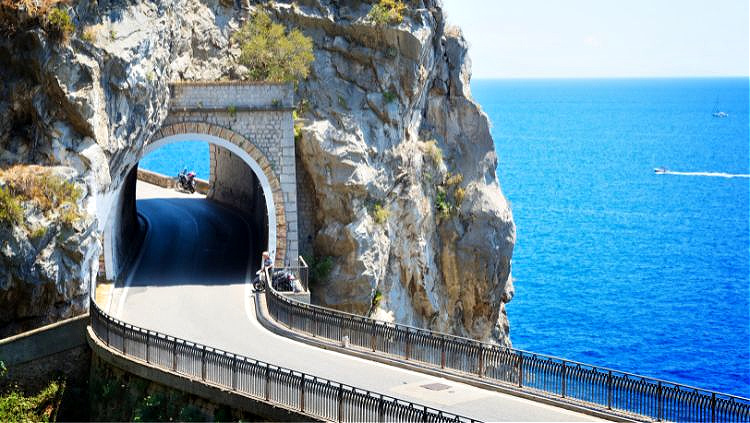
6. Make sure you're covered.
Travel Insurance. I never travel without it – no matter what. Depending on the coverage you buy, it can reimburse the cost of doctor fees, medical examinations, medication costs, and even hotel accommodations. Possibly more importantly, it may cover the cost of getting someone you love to your bedside during a medical emergency or return you to your home if that’s necessary. For details, read A Complete Guide to Travel Insurance for Solo Travelers .
Roadside Assistance. Whether you run your battery down (as I did in Maine), lock your key in the car, get a flat tire, or worse, it's great to have roadside assistance on your side. If you have AAA or CAA, you’ll be fine in North America. If you don't have it, it's likely a good investment for a long road trip alone.
Rental Car Insurance. If you’re renting a car for your road trip (read How to Save on Car Rentals ), check with your insurance company and credit cards first to find out what kind of coverage you have through them. If you rent a low-end vehicle on a credit card that offers coverage, you should be okay. If, however, you upgrade, your credit card insurance may not cover the more expensive vehicle. It's important to get the details right. If you've determined that your current coverage is not adequate for your rental car, here are the questions you need to ask the rental agency:
- How much does the coverage cost?
- What type of collision coverage is offered and what is included in this coverage?
- Who is insured under the coverage?
- Is there a deductible associated with the coverage?
- Is there anything that could possibly void the insurance coverage for the rental car?
- Is roadside assistance available as part of the coverage?
- What steps need to be taken if you get into an accident?
7. Pack right for a car trip.
Pack light. I know I say this all the time but whether you're staying at hostels, B&B's, or hotels, you are going to be hauling your luggage in and out whenever you move on to a new destination. Having just one bag to carry makes life much easier. Here's a link to my Bare Minimum Packing post for a bit of guidance on how to pack light.
8. Use multiple navigation tools to keep you on track.
Navigation when you're on the road alone can be a bit of a challenge. I use Google Maps, however, it chews through a lot of data. Depending on where you are, it could be expensive. In addition, I use the paper map or atlas I bought to plan the trip. I will also use the compass on my phone if I feel lost as it confirms my direction. It's also helpful to know that in the U.S.:
- Two-digit Interstates often go directly through cities while three-digit Interstates go around them.
- Odd-numbered highways run north to south and even-numbered ones run east to west.
9. Prepare your vehicle.
Have your car tuned up and inspected at least a week before you leave. This will give you time for any repairs that are required. Car Talk recommends the following items be checked. You can click on any of them to go to the Car Talk site for details.
- The Cooling System
- Steering and Suspension
- Change the Oil
- Air Conditioning System
- Check the Tranny
10. Stay in touch.
Let someone at home know your route, when you leave, and when you arrive at your destinations. A quick text message will do. If you have Wi-Fi (McDonald's and coffee shops are always good bets for free Wi-Fi), use any messenger system or send a quick email. That's all it takes.

Extra Tips for an Electric Vehicle Road Trip
Taking a road trip alone with an electric car not only gives you the freedom of the road but also freedom from the carbon footprint of a gas vehicle. While the range of travel for EVs continues to increase, there is still the issue that charging stations are not as readily available as gas stations.
1. Find Fast EV Charging Stations for Road Trips.
Not all charging stations are created equal. Fast chargers will make your road trip easier. Where to find them? Electrify America boasts a network of over 3,200 fast chargers and an additional 116 Level 2 chargers. Level 1 is to be avoided as it could take many, many hours to charge your vehicle. Also note, EVs will lose power faster in colder weather than warmer. Keep that in mind for winter road trips and be conservative in your range estimations.
2. Plan for Charging Time in Your Schedule: Apps.
You can't charge an EV in five minutes like you can with a gas vehicle. It takes time to charge and you'll need to plan for that.
A Better Route Planner is good app for this. Enter your vehicle and its year, starting and end points of your trip, and the pace you want based on the quickest way to get there, or if you prefer few but longer stops or more but shorter stops. That kind of information fits perfectly into #3 above, which is about setting your pace. You can download Electrify America's app here. Plugshare has a map of hotels with charging stations.

Increase Your Solo Road Trip Fun
1. take the stress out of your day of driving..
Start your drive early in the morning. You'll be less tired and more alert. The roads will also have less traffic, making the drive more enjoyable. You'll arrive in daylight with time to find your accommodation if you haven't already booked it.
- When you're driving, make sure your doors are locked and (need I say this?) you're wearing your seat belt.
- Be mindful of where you park your car. Try to park near an entrance to a mall or hotel. The lot may be busy when you arrive but if it's empty when you leave you won't enjoy a long walk across a vacant parking lot.
- If your trip takes you along roads with little traffic, consider getting a full size spare tire rather than a donut tire that can only go a short distance. You can get an affordable, decent quality spare tire at a used tire store.
2. Create a playlist.
There are definitely times to listen to local radio, but chances are you'll get bored of it and, possibly, be out of range of a station. Whether your playlist includes audio books, music (you may want to get Spotify), lectures, or all three, be prepared with what will keep you happy, interested, and alert as you explore on your road trip alone. Check out our Solo Road Trip Playlist .
3. Slow down, go local.
Slow down, save on gas, and enjoy the scenery and the scene. On my trip through the southwest I listened to KGHR 91.3 Native Radio. Listening to this station, I learned what was going on in Tuba City, what the Indigenous people care about, the values they hold, and much more. It's a wonderful aspect of travel that is most easily enjoyed on a road trip. Hungry for lunch? Look for the diner in a small town and you're sure to get some local flavor from the people as well as the food. Sometimes a local museum is the one that you'll find yourself telling people about years later. Don't overlook what may appear to be small experiences as they may be the most memorable.

14 Great Road Trips: All Solo Traveler Tested
Here's a link to our road trip category . Here are 14 Great Solo Road Trips: All Solo Traveler Tested .
Sharing is caring!
Publisher Janice: info @ solotravelerworld.com
Editor Tracey: tracey @ solotravelerworld.com
Sales Simon: simon @ solotravelerworld.com
Get Solo Travel News & Deals
- Create Your Advertiser Account
- Login to Your Advertiser Account
- Solo Travel Statistics
- Media & Speaking
- Privacy Policy & Disclosure

The content of Solo Traveler and any resources published by Solo Traveler are meant for entertainment and inspiration only. Please note that while we have advertising clients promoting destinations, products, services, trips and tours on Solo Traveler and that we endeavour to only work with companies in which we have confidence, we are not responsible for the delivery or quality of their products or services. Every person and every travel situation is different. Your safety, satisfaction and fun traveling solo are your responsibility alone and not that of Solo Traveler, its publisher, editor and/or writers.
PRIVACY POLICY & DISCLOSURE: In accordance with FTC guidelines, I disclose that I may be compensated if consumers choose to utilize links located throughout the content on this site. Additionally, some posts might be sponsored to support this site. Please do the appropriate research before participating in any third party offers. All opinions are my own. Please read our full Privacy Policy here.

Solo Road Trip Planning Guide: Tips for Traveling Alone
Hit the road with these essential tips for planning your first solo road trip – including where to camp, gear to pack, finding fun activities, eating well, and staying safe.
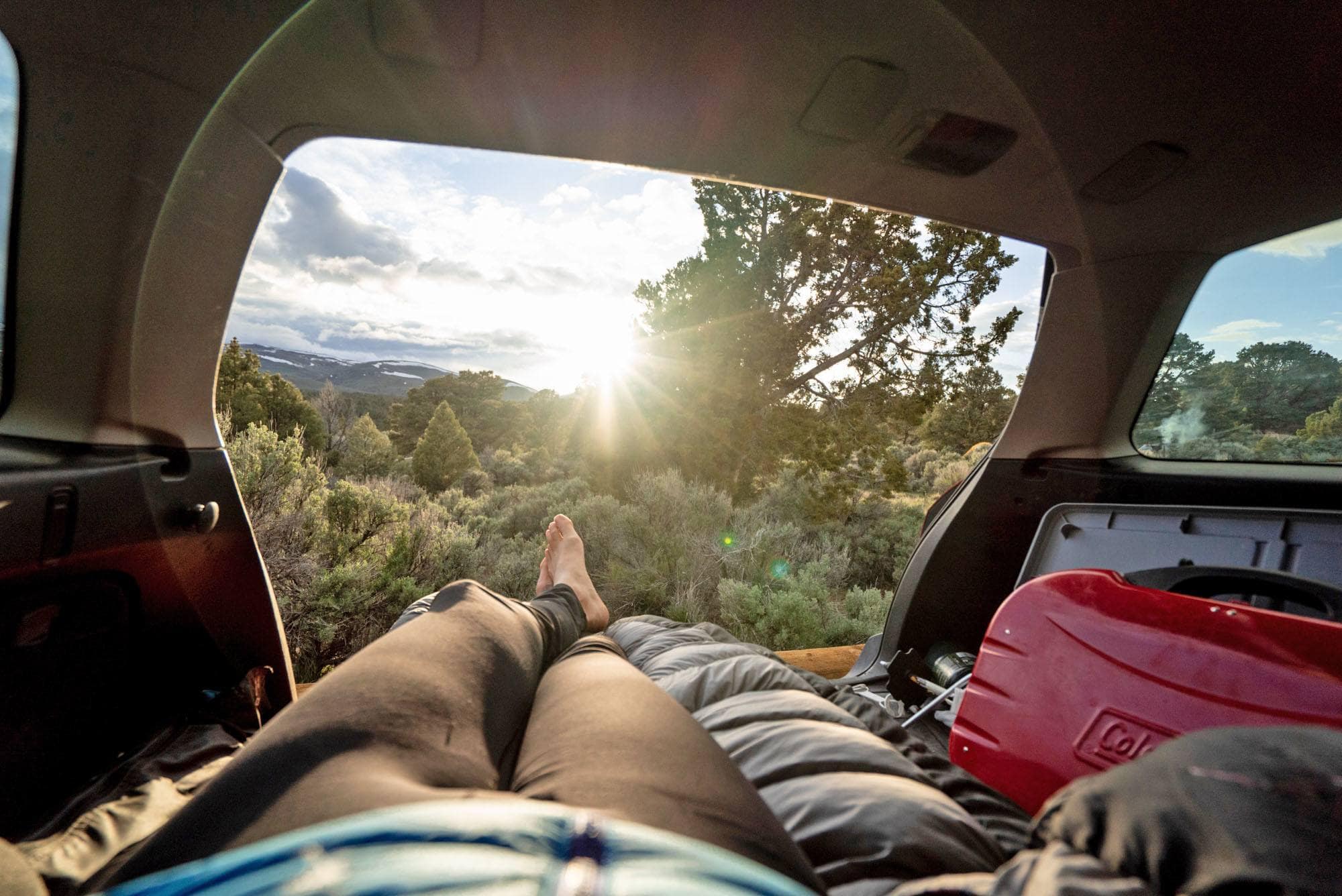
A few winters ago, I spent three months traveling around New Zealand in a van. It was my first-ever solo road trip, and I learned a TON of helpful road trip tips in the process – from how to plan, what gear to pack, and how to eat well on the road.
Since returning to the states, I put many of these road trip tips into practice, from a week long solo road trip around Nevada in my Subaru to traveling solo for months in my first Sprinter Van .
Your first solo road trip can be a little intimidating – especially as a female – so I wanted to share some of the things I learned from my experiences being alone on the road.
With this guide to planning your first solo road trip, you can travel smarter and safer, all while having a blast in your own company.
1-on-1 Van Life Coaching
Ready to get over your analysis paralysis and put your van life dreams into action? Let’s make it happen together. Book a 1-on-1 van life coaching call now and take the first step towards a life of adventure, freedom, and unforgettable experiences.
Planning Tips for Your First Solo Road Trip
Here are a few road trip tips to keep in mind when planning out your route and your solo road trip overall.
Take the Scenic Route
I always recommend taking the scenic route. It’s about the journey, not just the destination, right? So plan your route to be enjoyable and take time to enjoy the landscapes you pass through.
During my road trip to Nevada a few years back, my goal was to get off-the-beaten-path as much as possible, and the old country roads ended up being the best part of my trip. Fewer cars meant less stress, I could focus more on the scenery, and I could pull over wherever I wanted.

Give Yourself Plenty of Time
Give yourself plenty of time so you can stop at viewpoints and grab a bite to eat at that cute little cafe you happen to come across when cruising through town. It’s no fun being rushed, so plan extra time into your route and know that with all the stops, it’s probably going to take you longer than you expect to drive those miles. That way, if you see something unplanned that strikes your interest, you’ll be able to stop and check it out. If you find yourself feeling rushed, alter your route if possible so you can cover less ground and actually have time to stop and enjoy the scenery.
Find Cool Stuff to Do
Road tripping isn’t just about sitting in the car. It’s about finding fun things to do along the way. Do your research ahead of time and make note of the places you’d like to visit on your road trip, but be open to possibilities as well. You never know what local gems you’ll find by talking to people. Coffee shops, local stores, and visitor information centers can be great places to seek out info from the locals who know best. Also, don’t pass up quirky roadside attractions or an intriguing sign pointing down a dirt road. Stop to check it out! Some of the best stuff you won’t find in a guidebook.
While being spontaneous can lead to some of the best memories, you’ll also want to have a few stops in mind. National Parks are a great place to start. If you don’t have one already, consider getting an America the Beautiful Pass which grants you free admission to all national parks and public lands for $80 a year. Read more about how to save money in National Parks here .
Download Helpful Apps
Download a couple apps ahead of time so you’ll be ready to go when you’re looking for a place to eat or something to do. Here are some of my favorite travel planning apps for road tripping:
- AllTrails – for finding local hiking trails
- MTB Project – for finding local mountain biking trails
- Peak Finder – for identifying local peaks
- Tripadvisor – for restaurant and accommodation reviews
- Yelp – for local services and spots to eat
Gather Resources Ahead of Time
Invest in a couple of guide books for the areas you’ll be exploring. Hiking books, road atlases, trail maps, national park maps, and regional guides like Lonely Planet can also help you plan your trip.
If you’re looking for ideas on where to go, my friend Kristin Addis of Be My Travel Muse has an awesome round up of the 30 Best Solo Travel Destinations in the US , many of which would make for great road trips.
What to Pack for Your Solo Road Trip
What you pack for your solo road trip really depends on you, what you like to do, and whether you’ll be camping or not. Check out our Road Trip Essentials Packing Checklist for a complete list of suggestions. In the meantime, here are a few helpful suggestions to get you started, from apparel to outdoor gear, to entertainment, and more.
Solo Road Trip Basics
Always carry a map in your car for those times when you are out of service and you can’t use the GPS on your phone. I like to buy a road and recreation atlas for whatever state I’m traveling in. They show parks, monuments, campgrounds, dirt roads, and all kinds of other helpful information.
During my Nevada road trip I found that many of the free campgrounds didn’t have any potable water available. Invest in an inexpensive water jug to make sure you always have an adequate water supply both at camp and in case of an emergency. Fill it up before you leave and when it gets low, you can refill it at most truck stops.
Many campsites require a small fee and the only way to pay is cash. Keep a little bit of cash with you so you aren’t caught empty-handed when the ranger asks you to pay up. Cash is also handy for those times when you come across a local farmers market or roadside stand that only takes cash.
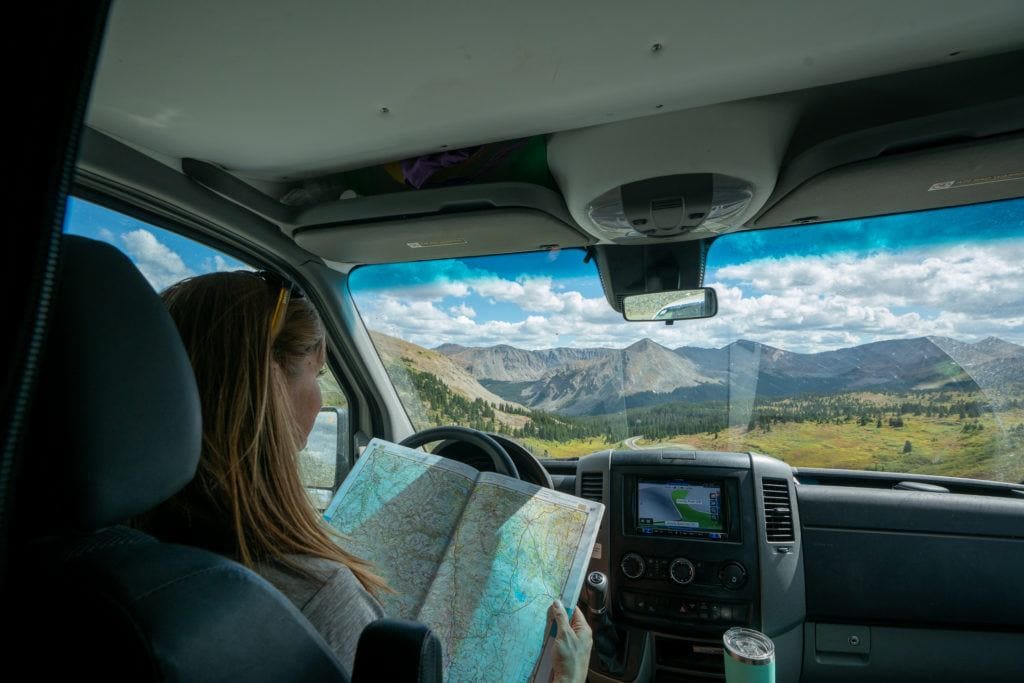
Road Trip Apparel
Bring clothes that are functional and can be worn multiple times. You also want your clothes to be comfortable and to breathe well. Think leggings or yoga pants, tank tops, a down puffy, a rain jacket, etc. I also always like to pack a hoody. If there’s a chance you’ll want to go out to a nice meal, bring one nice outfit that won’t wrinkle in your suitcase. As for shoes, I like to bring a trail shoe and my trusty Teva sandals which I can wear on walks, in water or with socks at camp… so fashionable, I know 😉
Shop my favorite road trip apparel

Solo Road Trip Safety Tips
Know the basics of auto repair.
I’m a complete idiot when it comes to mechanics – I barely know how to check my oil (my dad cringes). But in the case of an emergency, it’s a good idea to know a few basics like how to check fluids and how to change a tire, and have things like a car battery charger in your car.
Before you leave, check to make sure your spare tire has air in it. The last thing you want is to get a flat and then find out that your spare is flat too. It’s also a good idea to sign up for AAA or another roadside repair service if your auto insurance doesn’t cover that. If your vehicle is older and hasn’t been serviced in a while, it’s probably worthwhile to take it in to have the fluids checked and topped off.
Finally, always carry the owner’s manual – that’s the best book you can have in your car.
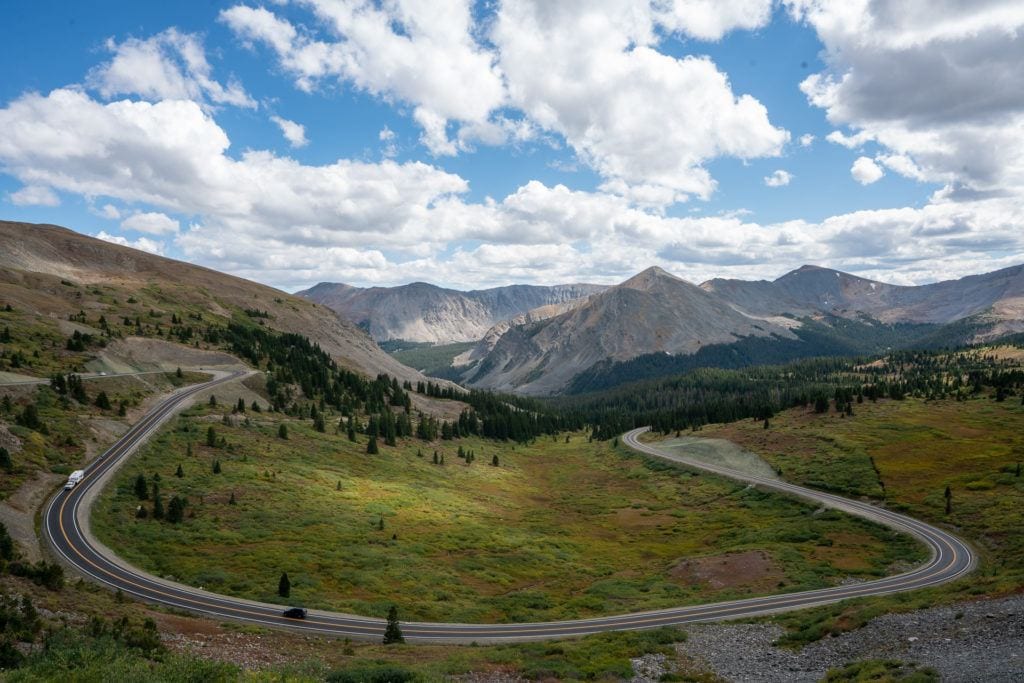
Carry a Communication Device
If you will be traveling on the backroads or anywhere where there is no cell phone service (this includes a lot of National Parks), you should always carry some sort of device that you can use to communicate in case something goes wrong.
I have a Garmin inReach which is a GPS tracker and navigation tool that also lets me communicate via satellite (no cell service needed). With a device like this, you can send and receive text messages to any cell phone number or email address no matter where you are, share your location, send updates, and call for help if needed.
You should also make sure someone close to you has a loose idea of your itinerary and check in with them via text or phone when you roll through a town. And definitely let someone know if you are going hiking or doing any other sort of solo activity away from your car.
How to Feel Safe at Night While Road Tripping Solo
If you don’t feel safe, you won’t be having fun, and choosing the right campsite can make all the difference. When I was on my first solo road trip in Nevada, I tried to choose campsites that had a handful of other campers there. I didn’t want so many people that it felt crowded, but having a few families or couples around assured me that it would be hard for a weirdo to go unnoticed. I was also friendly to my neighbors, but not so friendly that I could be interpreted as inviting unwanted company to my campsite.
As far as sleeping, I used to drive a Subaru, and I slept in the back of my car. Now I travel in a Sprinter Van . Sleeping in a vehicle, as opposed to a tent, helps me feel more secure because I lock the doors, and if something goes wrong, I simply hop in the front seat and drive away. My car also has a loud alarm that I could set off using a button on my door key if I wanted to cause a commotion.
If you don’t have a car you can sleep in, think about what you need to protect yourself and to make you feel safe while you are sleeping in your tent . Whether that be a loud alarm that you can sound off, pepper spray, or something else to give you peace of mind – have it within arm’s reach.
If you don’t feel safe camping solo, opt for a hotel or Airbnb (see below)…and have a cushion in your budget just in case.
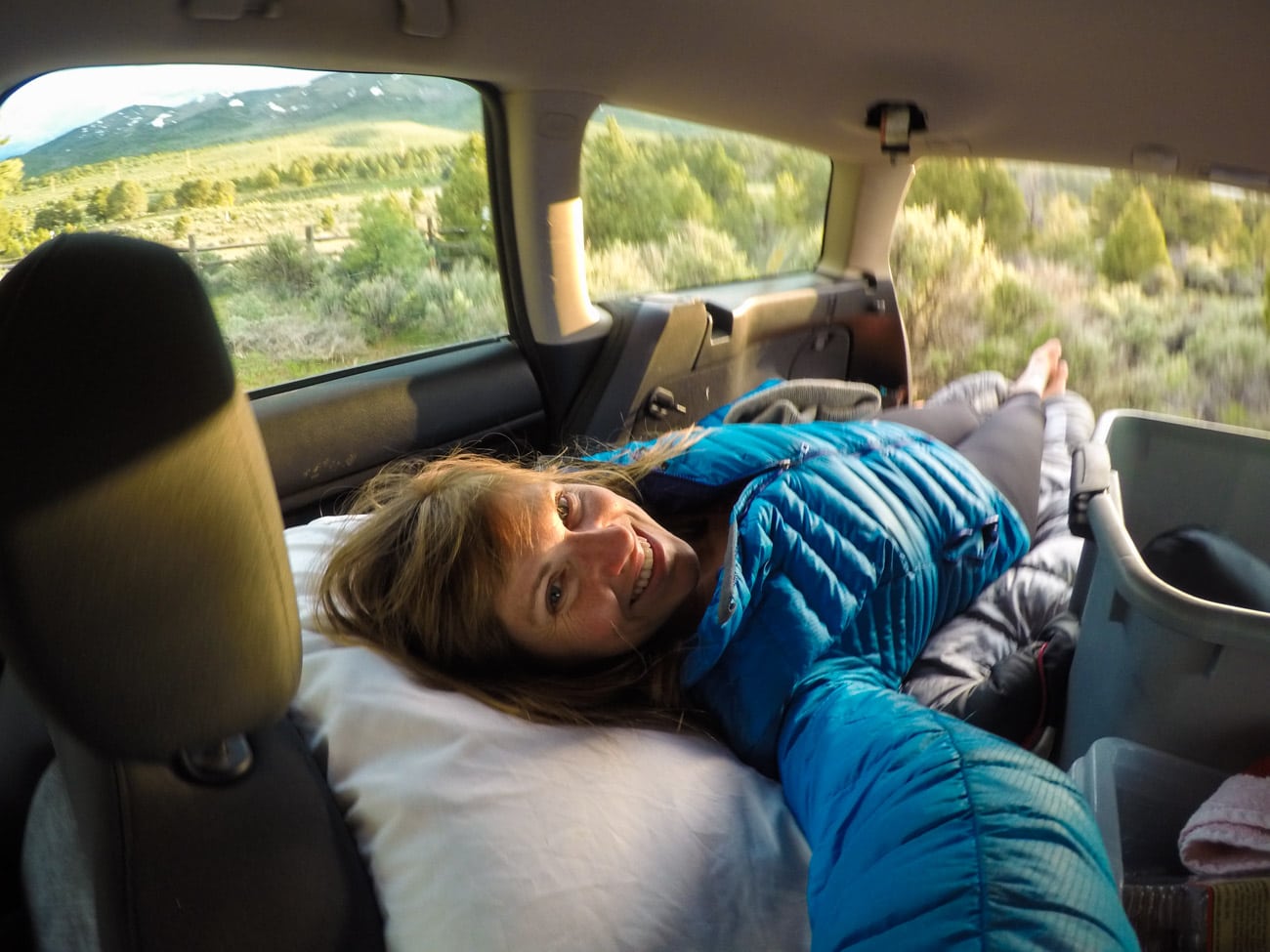
Keep an Eye on the Gas Tank
This may seem obvious, but if you are traveling in rural areas and you don’t know how far it is until the next gas station…fill up. Nothing can ruin your day faster than running out of gas in the middle of nowhere when it could have easily been prevented.
Have a Hide a Key
What happens if you accidentally drop your car key when you are out on a hike? Having a hide-a-key stashed somewhere outside your car could save you a lot of hassle. Just be smart about where you stash it so it’s not super obvious.
Finding Accommodation on Your Solo Road Trip
Finding good campsites.
Finding campsites while on the road can be a challenge, and you generally want to do so before you get out of cell service range so you can research your options. Check out our entire guide to finding free campsites for all the apps and the exact process I use to find campsites on the road.
Free campsites, also known as dispersed camping, generally have less (if any) amenities and also tend to be a little more isolated so make sure you’re prepared with everything you need and that someone knows where you’re going if you decide to go this route.
#1 campsite finder app
Try the dyrt pro free for 30 days.
Get a FREE 30-Day membership to The Dyrt PRO, one of our favorite apps for finding campsites.
Perks include: • 5,000+ free camping locations • 1,000+ campground discount network • $0 extra booking fees • Get reservations at sold-out campgrounds, and more
Use the code BEARFOOT to get 30 days free!
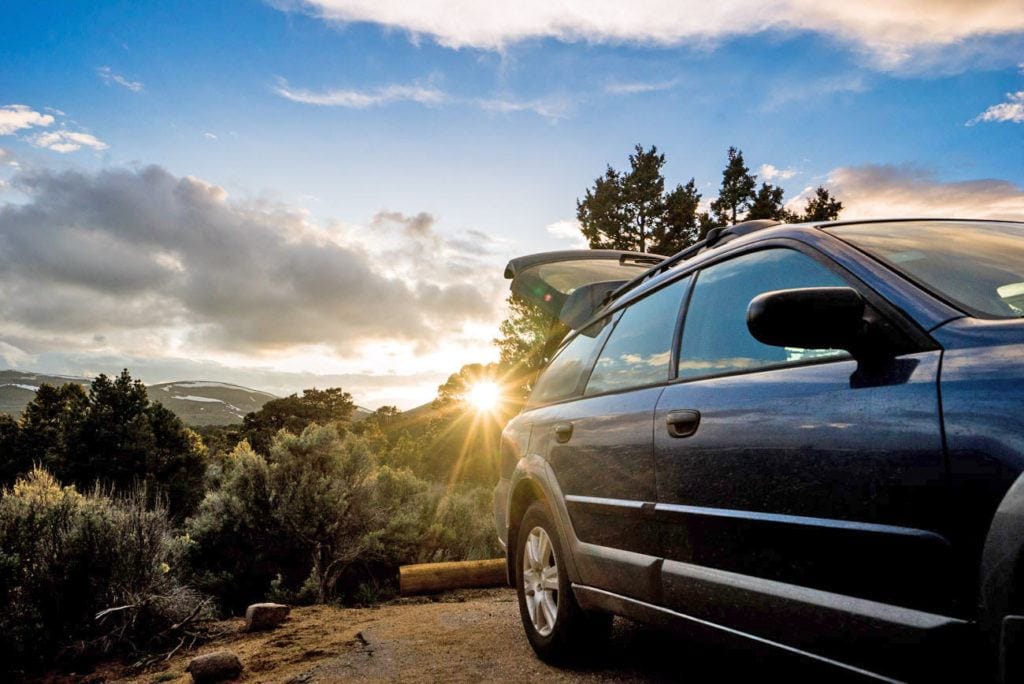
Finding a Last Minute Hotel or Airbnb
If you’d rather stay in a hotel, Hotels Tonight is a great app for finding last-minute deals…although you won’t always find a room especially in smaller towns. If there’s nothing on Hotels Tonight, check Hotels.com and Booking.com.
Check Airbnb too. Again, you won’t always find something in smaller towns, but Airbnb can be great for solo travelers. For the most economical option, check “Private Room” when searching which means you’ll get your own room in a home where someone else is living. When I’m going this route, I always try to find a place where the host has good reviews, and in lucky cases, you might even get some good local intel from your host and make a new friend.
Camp Cooking Tips for Your Solo Road Trip
Make meal prep easy.
Cooking for one during your road trip can be tough. Depending on the length of your trip, consider pre-cooking a few of your meals. Things like pasta salad and quinoa salad save well and can be easily eaten during a quick roadside break or when you get to your destination. Things like spaghetti sauce, soup, and other saucy dishes can be portioned out, frozen, and reheated. Veggies can be chopped and stored in reusable containers or a Stasher Bag for easy cooking. This makes dinner prep and cleanup easier and you’ll probably eat better than if you are making everything from scratch at camp.
Using non-stick pots and pans will simplify cleanup too. For dishes, pack a small dish brush or sponge and some biodegradable soap, and remember to always practice Leave No Trace principles .
If you like cooking at camp, consider making one-pot meals. My friends from Fresh off the Grid wrote a guest post with 6 killer one-pot recipes perfect for road tripping .

Pack Healthy Snacks
Bring plenty of healthy snacks to help avoid binging on chips, candy, and other gas station junk food. Easy to snack on fruit like grapes, blueberries, apples, bananas, and mandarins are nice to have (I wash everything before setting out so they’re ready to go). I also love bringing along pre-chopped veggies and dips like hummus and Bitchin Sauce and other snacks on the healthier side like light popcorn, nuts, and baked chips.
Have you ever done a solo road trip? How did it go? Share your experience in the comments below.
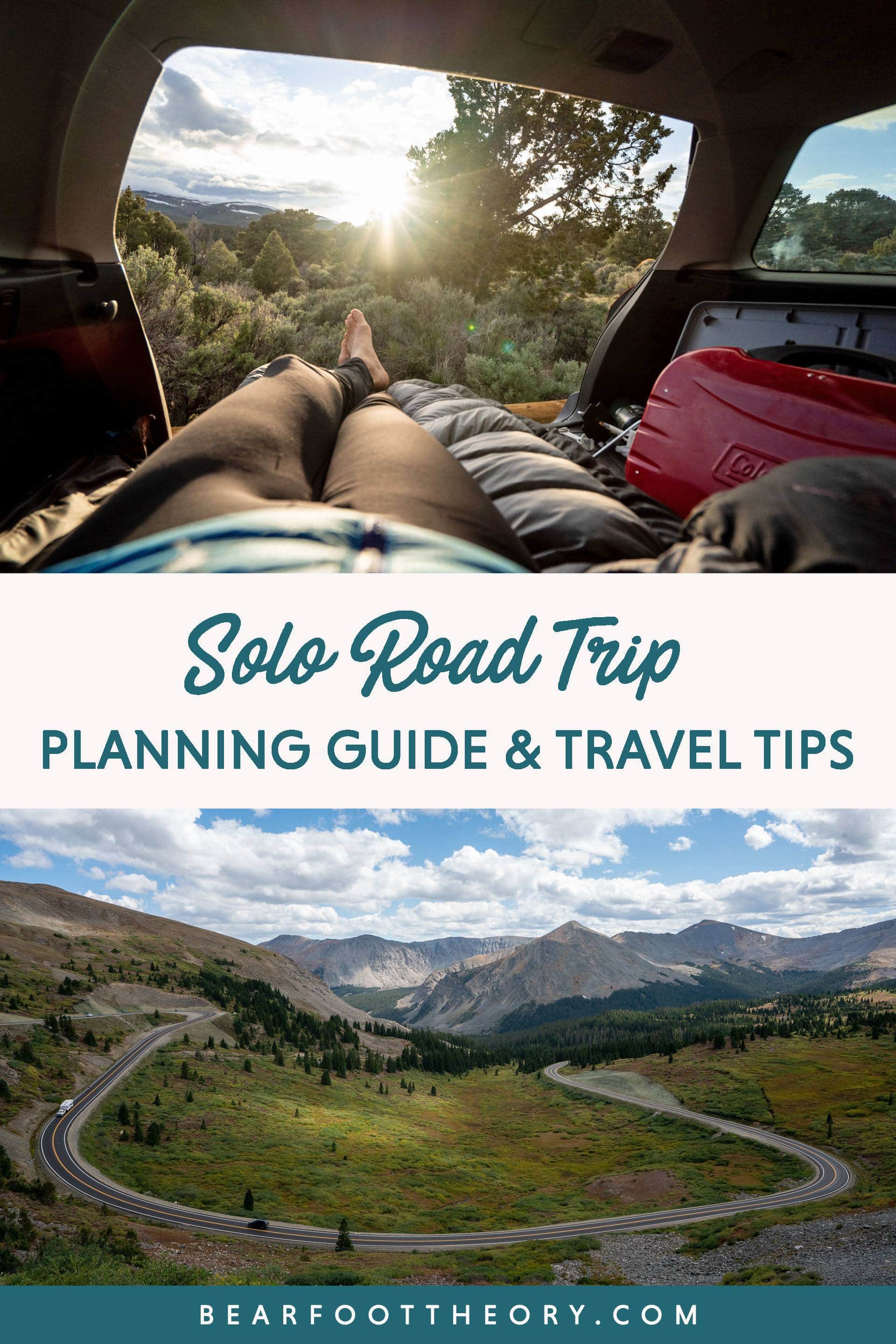
With two decades of hiking and seven years of van life under her belt, Kristen has dedicated her life to helping people experience the positive effects of nature. As a pioneer in the outdoor blogging space, she founded Bearfoot Theory in 2014 and has since authored more than 350 blog posts about outdoor travel, hiking, camping, and van life. Her work has been featured in National Geographic, Outside Magazine, and Backpacker, and when she’s not on the road, she lives in Park City, Utah with her partner Ryan, their son, and two adventure pups.
Leave a Reply Cancel reply
Your email address will not be published. Required fields are marked *
Save my name, email, and website in this browser for the next time I comment.
29 Comments
Great article full of useful information! I see you were driving combi – one question to that: do you think it would contain 2 people sleeping in it? Considering that the luggage would be stored on top of the car?
Myself and a friend were planning a road trip across Europe and wanted to use her combi. I’m just not sure if we would fit in 😉
Is a combi a van or a car with a hatchback? Is so, then I’m sure you’d be fine. Maybe bring a tent just in case you need some extra space?
I do a lot of solo hiking and was thinking of getting a phone tracking app so my husband can see where I am. Do you use one that you would recommend?
Hi Erica – Kristen brings a Garmin inReach Mini when she heads into the backcountry. It has two-way messaging and location sharing. Happy trails!
Sorry combi must be European expression 🙂 It’s the same type of car as your Subaru in the pictures. It’s good news two people can sleep inside. Tent is planned just in case yes. Thanks for your reply 🙂
Great post, lots of good info. I’m going to have to look into getting a SPOT. I plan to travel in a van solo in a couple years once both kids are off to college. In the meantime, we’ll be going to Colorado this summer and plan to do some hiking and camping. The SPOT would be a nice reassurance, just in case.
I got the same Outback as you and getting ready for a month-long trip in South cali, Az, Utah and Wyoming , great tips , thanks. Used to travel in VW bus but this time its a solo trip.
Thats so awesome! You’ll have to come back and tell me how it goes. Safe and happy travels!
I leave for my first solo road trip two weeks from today. I feel like I have done so much reading and research, but I am still super nervous for some reason. Your tips are awesome and I can’t wait to apply them and see where the road takes me!
How did it go? Can you provide any additional feedback or suggestions from your experience? I’m getting ready for my first solo trip in August to see majority of New Mexico!
This is great information! I’m doing a small road trip this winter with my dog, and I’ve been trying to work out all the details. This is definitely helpful so that I’m not missing anything!
I’m one of those solo road trippers and camp quite often. At first it was kinda freaky but got used to it. I do carry but I also have a clip on my keys that I use to clip the zippers together in my tent while I sleep. The keys will sound if someone is trying to open the zipper and it prevents the zipper from opening since the two are bound together by use of the clip.
This is a great idea, just need something in the tent to pee in as unclipping jangling keys to go outside is kind of counterproductive!
Wow great guide! I have always wanted to do a road trip, I think a lot of people are put off because they find it too intimidating, particularly the thought of going on your own, but in reality if you plan ahead you can put yourself in a much better position.
Very cool post. I will be doing a bunch of solo trips myself. I was surprised you took your Subaru and not the Sprinter. What was your motivation?
I didn’t have my Sprinter at the time 😉
I am going on a solo road trip, will be stopping a lot to do photography. Great tips Thank You
Hey there, I’m from Australia and spent two months road tripping around the west mostly tent and car camping. I liked forest service campsites, small, pretty, cheap and everywhere. They also have good clean facilities and often a camp host which can make it feel safer. Lots of families or older couples without kids camp here and are very friendly. Lots of hunters too, initially this made me feel a bit uncomfortable, just me and a bunch of men but I never had any problems. I would tent camp most times and cook at camp to keep costs down, I was travelling in sept/Oct so being able to make a fire quickly is a must and being able to set up camp with a head torch is useful. I slept in the car if it was wet or later in the trip when I parked in BLM areas alone so your tips about keeping the car locked and the driver seat clear make sense. Also important to have enough money to take yourself out to dinner now and again particularly on wet nights as trying to cook eat etc gets irky. And to stay in a motel to catch up on laundry and just veg in comfort for a bit like you would at home. Same with airbnb. Main concern for me was driving in cities on wrong side of road for me! So I hired a car from a regional airport in the middle of where I wanted to be and started in a town that did not feel to overwhelming. It was also quite possible to avoid major city centres for quite some time and when i did i would stay in suburbs and bus to city centre. This driving info will not be helpful to those in the US but may give other solo female travellers from other countries an idea of what is possible if you fear driving out of a major US city as soon as your plane lands!
Looks like the road to Mount Cook in NZ. This is a great and helpful Blog.
As I find your tip about going as off-the-beaten-path as possible in order to reduce stress, focus on the scenery, and be able to pull over wherever one wanted, what if one wants to do the solo trip around a certain city or country abroad? If I were to do this abroad, I would hire a taxicab ahead of time on the day one has to go to the airport and the day to head back. Doing this will help ease stress on the start and end of the trip.
Thanks for sharing this information and also for giving us a bit of guide when it comes to towing.
You’re welcome, Jeff. Thanks for reading!
I’ve never really thought of some of this guide. THanks for sahring.
Thanks for reading!
I love posts like this. I’m going to take any help I can get to drive.
Enjoy your adventures 🙂
Hi Kristen! My name is Angelina and I am planning my first solo road trip. I will likely be staying in my car and I will have a tent in case it is warm enough. Do you have any tips about road trips in the winter? I am currently planning to drive to the south/ south west to enjoy the outdoors more.
Exciting! Just be sure to pack layers so that you have plenty of clothing options to choose from. A warm sleeping bag is also an important thing to have and an insulated sleeping pad if you plan on sleeping outside.
Very helpful, I plan on taking my solo trip across America next year your guide and tips are awesome thanks
How to Plan a Camping Road Trip
Planning a Stargazing Road Trip
10 Helpful Budget Tips
Calculating the Cost of Gas
Budget for a 3-Day Road Trip
Best Road Trip Route By Interest
Mississippi River Road Trip
Atlantic Coast Road Trip
Southern US Road Trip
Northern US Road Trip
Pacific Coast Road Trip
US Route 12
Northeastern US Routes
Rocky Mountain Destinations
Warm-Weather Road Trip
The Longest Highway in the US
Car Rental Companies
Best Audio Books
Must-Have Emergency Supplies
Family Road Trip Toys and Games
Car Bike Racks
Getting Your Car Ready
Preparing for the Weather
8 Helpful Apps for a Road Trip
Common Mistakes to Avoid
Taking a Road Trip With Kids
Planning a Solo Road Trip
Top 10 Tips to Prepare for a Solo Road Trip
Road trips are often taken in pairs or big groups , but going for long drives alone can end up being even more fun. When you're on a solo adventure, you don't have to conform to anyone else's agenda or expectations. You're the driver, the navigator, the DJ, and the only one eating all those road trip snacks. And while it may get lonely at times, traveling alone has a way of pushing people out of their comfort zones. However, it can also be dangerous. Anyone planning a solo road trip should take extra steps to prepare and keep safety top of mind.
Talk to the People Around You
It would be easy for a solo traveler to go days without talking to anyone but drive-through workers and gas station clerks, but the lack of human contact can start to take a toll on your psyche. Make sure you keep communicating with others, whether it be regular check-ins with your family and friends or, better yet, meeting fellow travelers on the road. Ask whether you can join a group on a hike, sit next to another solo traveler at a coffeeshop, or strike up a conversation with your camping neighbor. You may even end up with a temporary travel partner, if that's what you want.
Tell Someone Your Plans
Image Source / DigitalVision / Getty Images
The number one safety rule is to always tell someone where you're going. Call a parent, friend, or spouse before embarking on a hike, spending a day at the beach, or settling into a campsite at night, then check in with your point-of-contact when you reach your destination so they know you've made it safely. Better yet, share your location with someone on your phone or purchase a wearable tracker, such as a Fitbit or a more budget-friendly alternative.
Try to anticipate when you might lose phone service and call beforehand, but in scenarios when you can't, at least leave a note on your car that says where you are. This is important in the event of an emergency that would require law enforcement to look for you.
Bring Your Four-Legged Friend
Evgeny Vasenev / Aurora Photos / Getty Images
Does it count as solo travel if you bring a pet along with you? Dogs and cats have been scientifically proven to relieve loneliness and depression in humans which must mean that they'd make great travel partners. You may run into limitations when traveling with a pet—there might be areas you want to explore that aren't dog-friendly—but on the flip side, you'll always have someone to talk to and to potentially protect you. Always talk to your vet and get a clean bill of health before embarking on a road trip with your pet .
Prepare Backup Resources
Hero Images / Getty Images
Your cell phone will act as a lifeline during your solo adventure, but it won't do much good if it's dead and you're in no position to charge it. It's a good idea to bring backups for your vital electronics like cell phone batteries and chargers. Put a charged-up old cell phone in your glove box for emergencies. Even if the cell phone isn’t connected to a network, dialing 911 will activate the emergency mode and allow you to communicate with first responders.
In the same vein, you should have backup resources on your devices, such as important documents (your passport, credit card information, driver's license) saved to your Cloud. It's best to pre-mark a route on whatever virtual navigation system you'll be using and have a backup of that, too. In addition to Google or Apple Maps, download Maps.me , which lets you download maps of certain areas and use the navigation offline. To keep an eye on tourist sites on the route, you can use an app like Roadtrippers or carry a National Geographic paper map .
Make Sure Your Ride Is Ready
The surest way to get yourself stranded is to not have your vehicle checked over before heading on a road trip . Go through the trouble of taking your ride to a licensed mechanic. Make sure the tires are good and you have what you need to handle any inclement weather. Get the oil changed, top off the fluids, check the brakes, and make sure the cooling system is in good shape. Have the manual handy in case a light comes on during your trip. Before you go, double check your car insurance plan and secure a membership to AAA for round-the-clock roadside assistance.
Stock up on Food and Water
Westend61 / Getty Images
It would also be wise to travel with a stock of non-perishable food items and water, just in case you must go miles without a suitable stop. You'll want to keep healthy, nutritious snacks on-hand and not just the standard road trip junk food. Be careful of your salt intake, as it can leave you dehydrated, and drink as much water as possible but avoid soda. For emergencies, keep trail mix, meal replacement bars, and dehydrated food packs in your car.
Pack an Emergency Kit
Accidents can happen, and if they do during your trip, you're going to wish you had made space for an emergency kit . The ideal kit would have first-aid essentials, blankets, and roadside hazard items such as flares and cones. Basic tools and jumper cables will come in handy if your vehicle breaks down and a flashlight is a must. In addition to car insurance, solo road trippers may also want to secure travel insurance, which covers things like medical emergencies, theft, and accident coverage while traveling. Allianz Travel Insurance , RoamRight , and Seven Corners all offer road trip-specific plans.
Don't Overdo It
Maya Karkalicheva / Moment / Getty Images
You should never operate an RV or vehicle for more than 12 consecutive hours without an extended break. In fact, eight hours of active driving is plenty for most. After a full day on the road, your eyes will be heavy and you'll start to lose focus anyway, making you prone to accidents. Most highways in the U.S. are dotted with frequent rest areas where you can take a nap or stretch your legs. Some even give away free coffee to keep drivers awake. Do some research before you go and plot the good stops on a map to make it more exciting.
Load up on Entertainment
If you're relying solely on the scenery to keep you alert, you may get bored. Boredom can lead to sleepiness and sleepiness can be detrimental to driving, so prepare some upbeat playlists, audiobooks, or podcasts before you go. If you know that the sound of talking may bore you even more, then make sure you have enough music to keep the tunes flowing. For your safety, try not to resort to talking on the phone.
Have a Little Fun
Nazar Abbas Photography / Moment / Getty Images
Make the most of burning the miles by yourself, whether it means getting your favorite guilty-pleasure dessert, stopping by a roadside attraction you wouldn’t usually see, or buying yourself a few trinkets at a roadside stand. Spoil yourself. And don't be afraid to go to a bar, a coffeeshop, or sign up for a tour on your own.
Planning a Road Trip: The Complete Guide
The Unexpected Perks of Solo Travel
Tips for Traveling Solo With a Tour Group
10 Tips for Road Tripping With an Infant
How to Plan for the Weather During Your Road Trip
Emergency Supplies for Road Trips
Traveling Safely in Greece
Green Tortoise Adventure Bus Tours
Glacier National Park: The Complete Guide
Driving on Maui
10 Travel Tips for Your Winter Road Trip
Driving in Florida
Scenic California Drives: 7 Routes That Will Make You Swoon
Driving in Denmark
20 Solo Trips in 2020: I Traveled Solo During COVID-19
What to Do If You're in an RV Accident
Join my monthly email! Sign up

25+ Top Tips for a Solo Road Trip You NEED To Know
Planning a solo road trip but don’t know where to start? I’ve done loads all over the world, so here’s my tried and tested advice for enjoying a road trip by yourself…
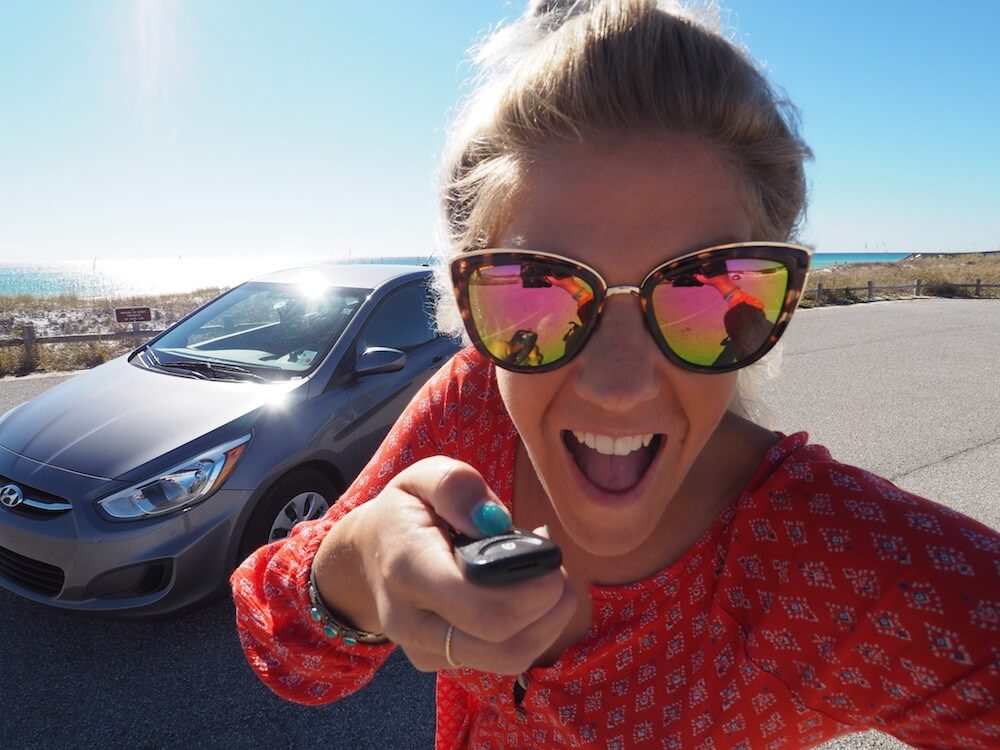
I like being by myself, and judging by the fact you’re on an article about doing a solo road trip, I’m going to assume you do too. Solo road trips can be so much fun – they give you freedom to explore without restraint. No more having to accommodate everyone else needs, instead focusing on what you enjoy and taking breaks when you desire.
Going on a road trip by yourself comes with some unique benefits and challenges. This is why I have come up with the ultimate tips for the best solo road trip experience!
Where to go on a solo road trip
Taking a road trip by yourself is a great way to explore the world. Whether you prefer to stick closer to home or go international, there are many incredible solo road trips to choose from.
When choosing a destination it is important to consider the area.
Is it safe?
Does it have fun solo activities?
What are the road conditions?
Based on experience and knowledge gained on my travels, here are my top destinations for solo road trip adventures.
The Lake District
Located in Northwest England, the UK Lake District is a great 3 to 7-day road trip. Voted as one of the best road trips in the UK, the UK Lake District is filled with wild swimming holes, quaint towns and breathtaking mountain views. If you are looking for an epic hike, then Scafell Pike, Helvellyn and Helm Crag are popular excursions for the adventurous at heart.
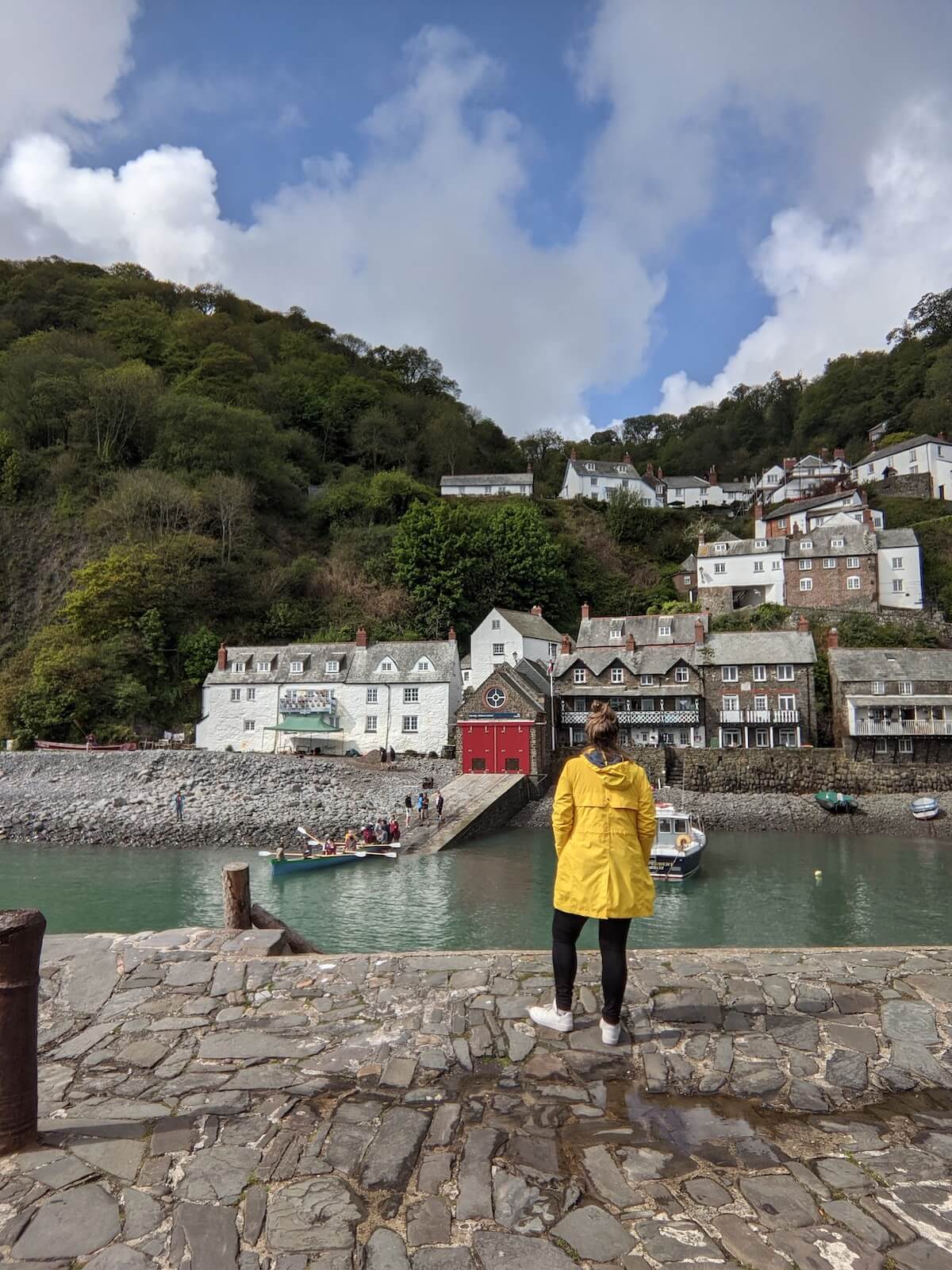
You could also try a Devon road trip , a Cornwall road trip , drive along the Jurassic Coast , or try driving along the Norfolk Coast . You can check out all my recommendations for UK road trips here . Oh, and can’t forget the time my friend and I did a wild camping road trip in the Outer Hebrides !
Iceland Ring Road
Iceland is a beautiful destination and fantastic for solo travellers. Safe, beautiful, and with plenty of activities, the Ring Road allows you to drive around the entire country of Iceland in one trip! Although you can technically complete the entire road trip in 13 hours, it’s best experienced over 10 days. This allows you to stop at all the amazing sites and villages along the way.
If you’re looking for solo road trip ideas, this is a great one.
Vancouver to Banff, Canada
The Canadian Rocky Mountains are a stunning site to behold, with a road trip being the best way to experience their wonder. Start your journey in the 2010 Olympic city of Vancouver, and end your trip by relaxing in a Banff hot spring. Along the way, there are many sites to explore, such as Johnston Canyon, Lower Falls, Lake Louise, Peyto Lake and Emerald Lake.
New Zealand
New Zealand is a relatively safe country, with a stunning landscape and little to no dangerous wildlife. This makes New Zealand perfect for solo road trippers! Although you can explore most of the Island of New Zealand in 2 to 3 weeks, there are many smaller road trips you can plan. If you have less time, try to focus on either the North or the South of the island. In the North, you have cities like Auckland, the Bay of Islands and Wellington to explore. While in the South, you will find Christchurch and Queenstown.
Route 66, USA
If you are looking to take a road trip across the USA, then Route 66 is perfect for your next solo road trip! At 3665km long, Route 66 starts in Chicago, Illinois, transversing 8 states and ending at the Santa Monica pier in California. With amazing stops along the way, such as Blue Hole, Calico Ghost Town, and the Petrified Forest National Park, Route 66 is calling you!
Take a look at this guide for the LA to Grand Canyon road trip for more route tips.
I’ve done quite a few road trips in America , including driving from Miami to Key West , road tripping along the Pacific Coast Highway in a Mustang and driving from Vegas to Yosemite.
READ MORE: All the Road Trip Essentials You’ll Need
What to take on a solo road trip
These are the most important solo road trip essentials you should consider taking with you.
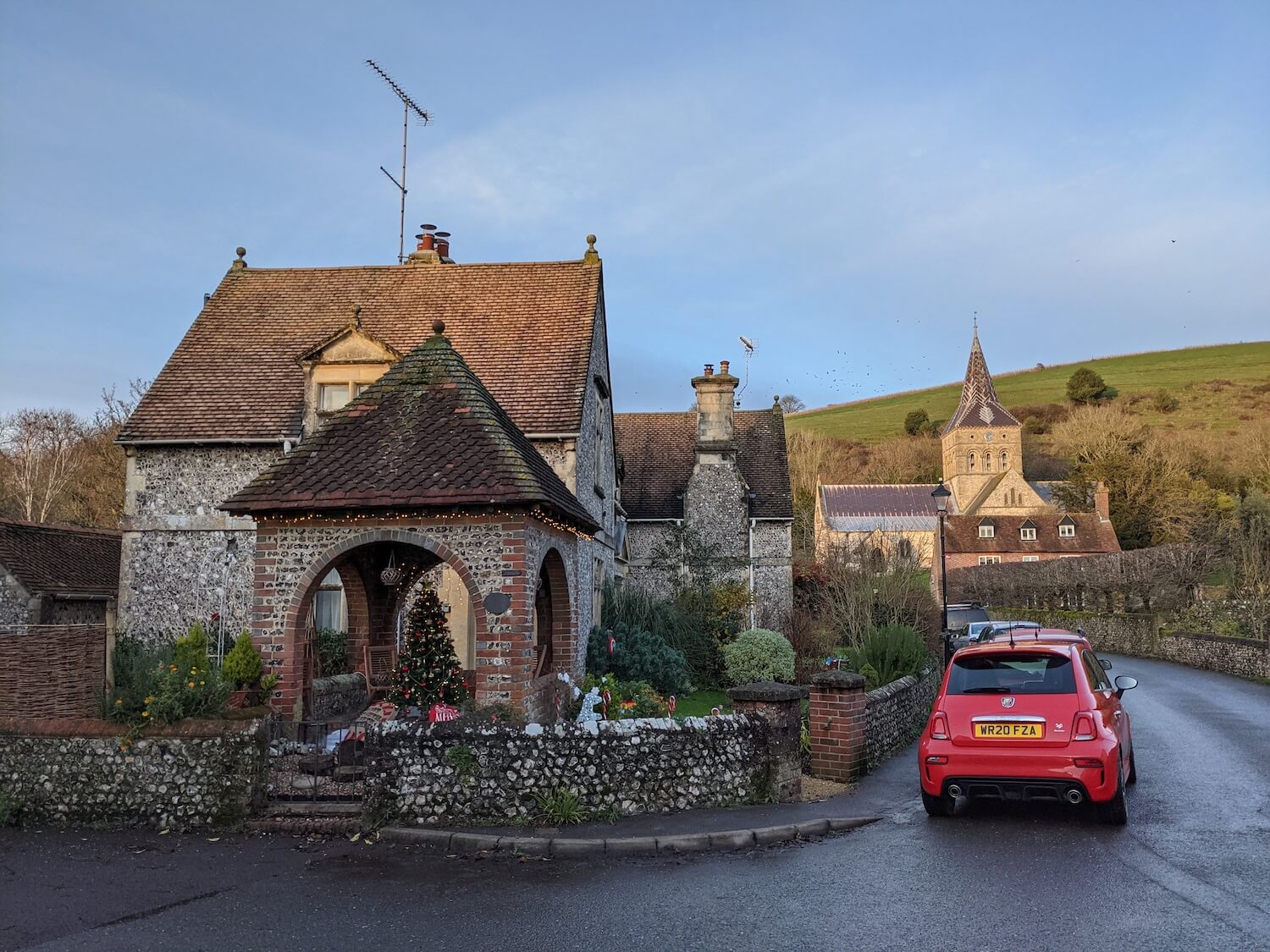
- Solar charger: Charge your phone while you drive, but instead of a car charger, use the sun! Solar chargers are a great way to power up, while being more eco-conscious. Plus they allow you to charge your devices almost anywhere!
- Dash cam: Dash cams have become extremely popular, due to the extra level of security they provide. They can also capture exciting events on your solo road trip, you may miss otherwise.
- Satellite phone: Are you an extreme adventurer? Are you planning a multi-day hike in the wilderness? Then you might benefit from a satellite phone. A satellite phone can be a great way of staying connected when in remote areas. Especially if you plan to venture out of mobile phone range for days at a time.
- Roadside emergency kit: A roadside emergency kit is very handy, especially in extreme weather. Check out the RAC website for information on what to pack in your roadside emergency kit.
- Powerbank: Although a car charger is a great way to charge your device on the go, just in case your car breaks down, invest in a power bank. There are many variations available, with some powerful enough to charge your cell phone, tablet and even laptop.
- Bucket with a waterproof seal: Did you know that you can wash your clothes as you drive? All you need is a bit of laundry soap, water and a bucket with a waterproof seal. Make sure to only fill the bucket 3 quarters of the way, to allow for movement. As you drive the water and detergent will slosh around the clothes, removing dirt and debris. After an hour or two of driving, switch out the liquid with clean water to rinse. Voila! Clean clothes, without the laundry mat.
- Carjack: No one wants a flat tyre, but it’s good to plan for one. Sometimes cell signals can be spotty on remote roads, making calling roadside assistance challenging. Having a carjack can make life easier, if you happen to get a flat.
- First aid kit: A first aid kit is always handy, no matter where you are. Pop a first aid kit in your vehicle, just in case an itchy bug bite or scraped knee tries to infringe on your fun.
- Paper map: Phone dead? No internet access? Although paper maps are not as popular as they used to be, they still are very handy in case of an emergency or even just for fun.
- Pack snacks : What’s a road trip without an epic snack fix? Sweets, chips, soda, and cookies are always fun, but try to pack healthy alternatives for the road, as they’ll be more difficult to find along the way. Nuts, canned fish, fruits and veggies can be great alternatives that do not require refrigeration.
Great apps for solo road trips
How to stay safe on a solo road trip? Use these apps!
My SOS Family Emergency Alerts: Planning a mountain hike or going to a remote area? When solo travelling it can be smart to set up a contingency plan in case something goes wrong. My SOS Family Emergency Alerts can notify your friends or family if you do not access your device in a set period of time or if you need to send out an SOS notification.
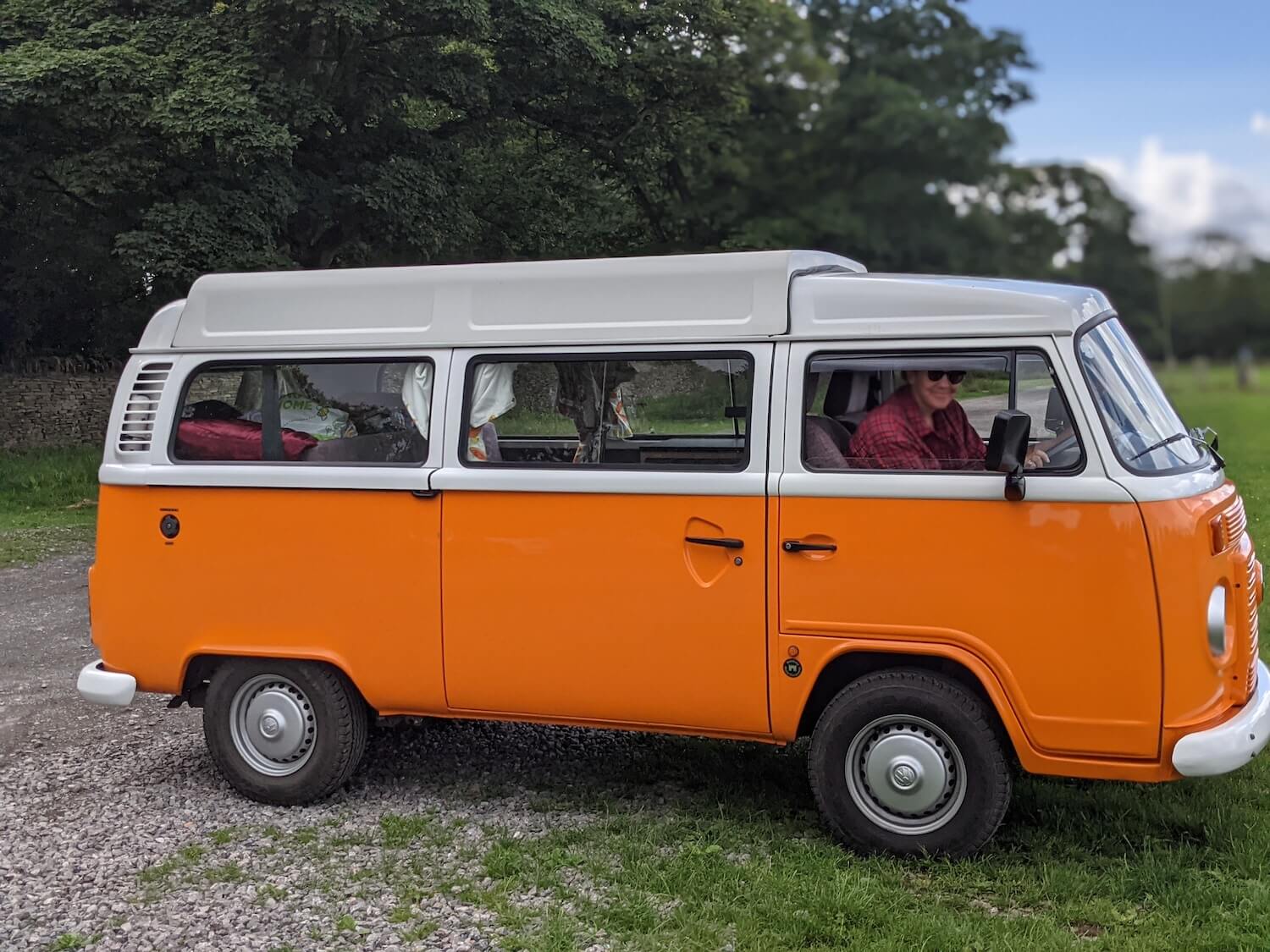
ICE – In Case of Emergency: As a solo traveller it is important to have safety measures in place in case of an accident. ICE allows you to display your essential personal information, such as name, birth date and allergies, on your phone lock screen. This way, if you are unconscious or unable to respond, the first responders still have access to vital information required to keep you safe.
Spotify: Every solo road trip requires an epic playlist and Spotify can help with that! Create your custom playlist or choose one of the many popular premade playlists available. For an ad-free experience, you only need to pay £9.99 / per month, making Spotify an affordable way to access all of your favourite artists and podcasts on the go.
Google Maps: An amazing thing about Google Maps is that you can access maps offline for free. No more worrying about finding a cell signal or WIFI, when you can just open the app and check your location live via GPS. You can also start a journey and add stops along the way, such as bathroom breaks or quick excursions. Label your must-see attractions with a green flag so you won’t forget or flag the restaurants you visited, so you can remember them for next time.
Headout: The Headout application allows you to book tickets for shows, concerts, excursions, tours and attractions. Explore activities available at popular destinations around the world and book your ticket straight from your device without waiting in line. Available for free on Android and iOS.
Make sure you get your travel insurance sorted before you go on a solo road trip. HeyMondo offer 24/7 worldwide assistance with travel cancellation and interruption cover. They also have tailor made policies and cover medical expenses up to $10 million. Click here and you’ll get 5% off your travel insurance with HeyMondo.com too. Check out their App for more details.
Good knowledge for a solo road trip
Schedule breaks: Solo road trips typically take longer, as you will be the only person driving. Driving for 12 hours straight is unrealistic, so make sure to schedule frequent breaks and stops to rest.
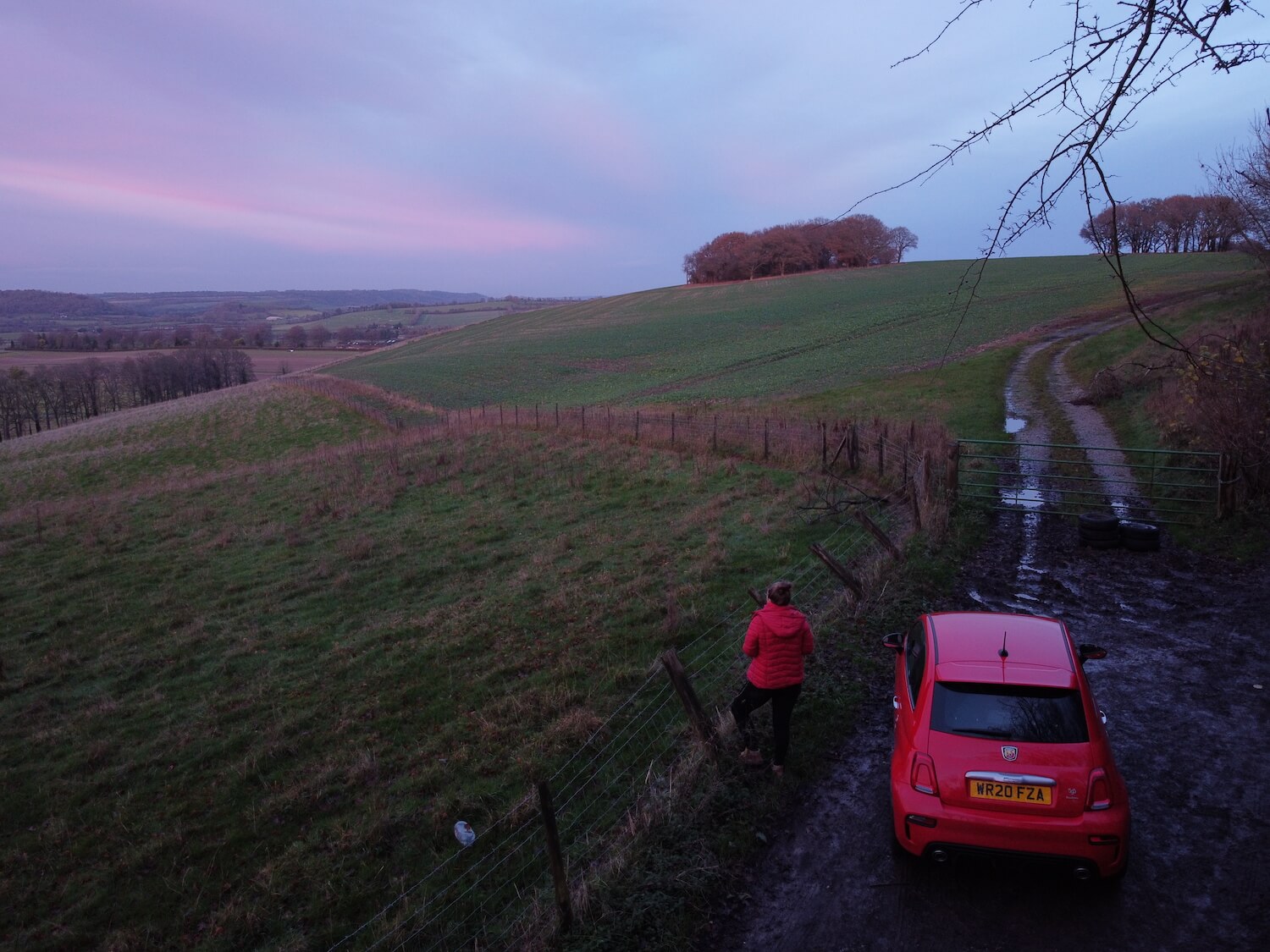
Sort your car shipping: If you’re planning on shipping your car out to your destination to drive, you can get car shipping quotes online here .
Driving permit: Depending on the country you visit, you may be required to hold an international driver’s licence, like I had to get when I drove round Jeju Island in South Korea solo . To confirm, check the destination’s government website or contact the local consulate.
Prep your vehicle: Before venturing out on a long solo road trip, make sure your vehicle is in tip-top shape! Check the oil levels, wind wipers, gas level and tyre pressure. You may also want to wipe the interior down and do a quick vacuum. Nothing better than starting your trip off fresh.
Morning start: Beginning your day early is the best way to start a road trip . Not only will you get most of your driving done early, but you’ll also be more alert and well-rested, making your drive safer and easier.
Check your insurance: Not all car insurance covers driving excursions, so make sure to double-check with your insurance provider. It’s also a good idea to sign-up for roadside assistance, in case of a flat tyre or sudden car trouble. I actually get mine through my bank with my account which is pretty sweet.
Solo road trip tips
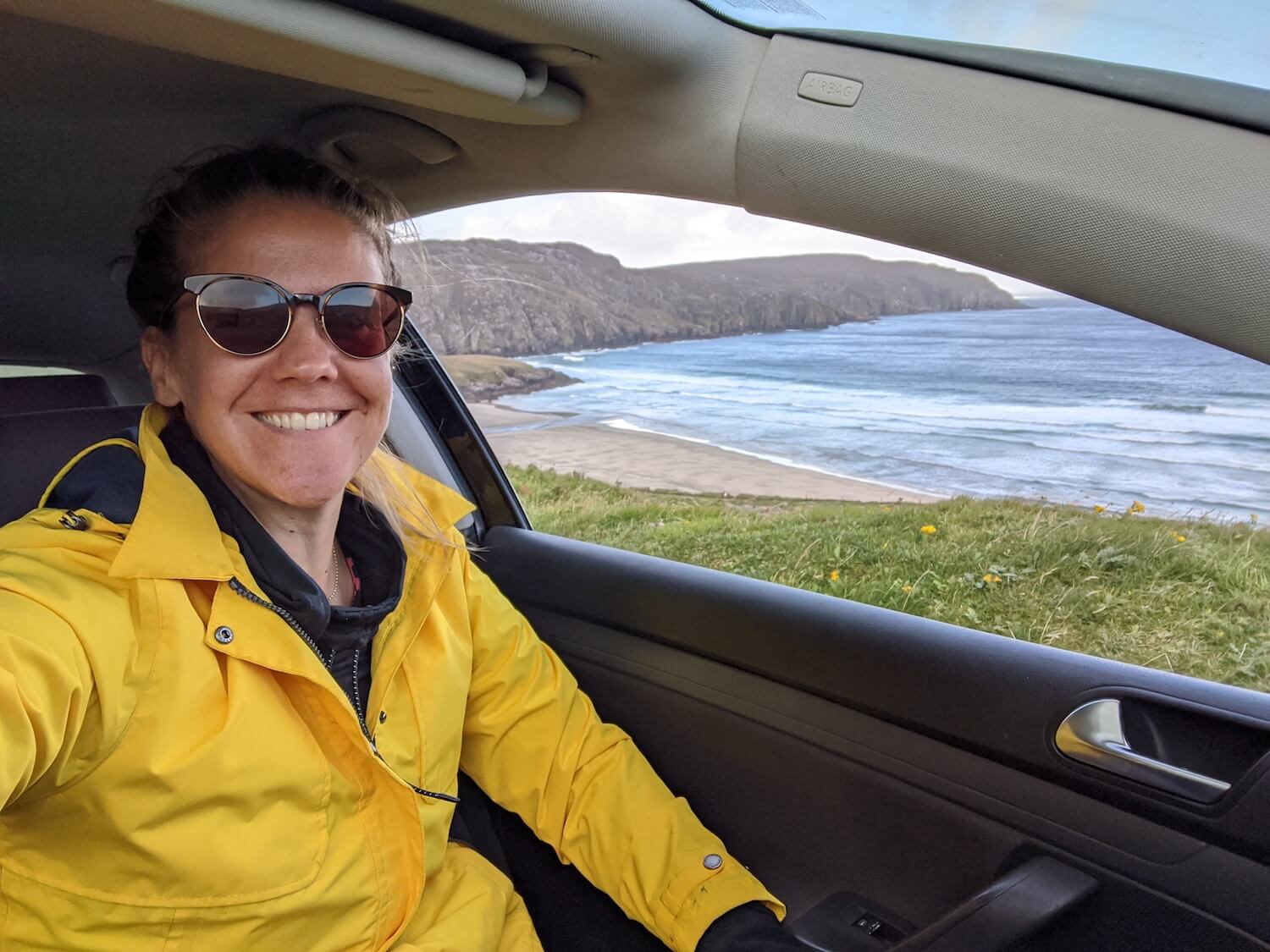
Have these solo road trip tips inspired you? Where would you like to go on your next solo road trip adventure? Let me know in the comment section below.
Related Posts:
- Going On a Dog Road Trip? Here’s 10 Tips For Success
- 60+ Driving Affirmations for Road Trip Confidence This Year
- 7 Ways to Make the Most of Your Road Trip Budget
- My Tips for Travelling Vietnam Solo
- 7 Eating Tips for Solo Travellers
- 19 Best Road Trip Gifts for Every Kind of Traveller
Hi, I'm Vicky! I wrote this. You can find me on all the social media @VickyFlipFlop. I love a bit of adventure, will try anything once, and have a strong passion for the local food and drink, whatever it may be. I'm here to help inspire you to travel to places a little out of your comfort zone, or at least to explore the usual destinations in a different way. Stay, have a look around, and if you have any questions – let me know below.
Leave a Reply Cancel reply
Your email address will not be published. Required fields are marked *
Sign me up for the newsletter!
- Destinations
- Female Travel
- Tips & Guides
- Solo Hotels
Select Page
How To Plan A Solo Road Trip
Posted by Kayla Booth | Tips & Guides

Embarking on a solo road trip can be a truly transformative experience, offering freedom, personal growth, and unforgettable adventures.
Before you hit the open road, it’s essential to choose the right destination, prepare meticulously, and create a detailed itinerary.
We will explore the reasons why taking a solo road trip can be so rewarding, provide tips on selecting the perfect destination, getting ready for your journey, and making the most of your solo travel experience.
Key Takeaways:
- Embrace freedom and flexibility by taking a solo road trip for personal growth and new experiences.
- Choose the right destination by considering your interests, researching the route and weather, and planning for safety and emergencies.
- Prepare for your trip by maintaining your vehicle, packing essentials, and budgeting. Create an itinerary by mapping your route, identifying must-see stops, and allowing for spontaneity. Stay safe and connect with others while documenting your journey.
Why Take a Solo Road Trip?
Embarking on a solo road trip offers a unique opportunity for personal growth, adventure, and experiencing new destinations at your own pace.
The freedom that comes with a solo road trip is unparalleled; you have full control over the itinerary, stops, and duration of your journey. There’s no need to compromise or adhere to someone else’s schedule.
Flexibility is a key benefit – you can change plans on a whim, take detours to hidden gems, or linger longer in a place that captivates you.
This personalized approach allows for deep introspection and self-discovery. Being alone on the road fosters a sense of independence and resilience, pushing you out of your comfort zone and encouraging personal breakthroughs. The solitude offers a chance for introspection and reflection, leading to a clearer understanding of oneself and one’s aspirations. It’s a journey not just through miles but through moments of profound self-awareness.
Freedom and Flexibility
One of the key reasons for opting for a solo road trip is the unparalleled freedom and flexibility it offers in driving, navigating, and enjoying serene sunrises on the open road.
When embarking on a solo adventure behind the wheel, you have the power to chart your own course, lingering in quaint towns or speeding through vast landscapes, all based on your whims. Route selection becomes a thrilling decision solely in your hands. With no set schedules to adhere to, you can pause at picturesque viewpoints, sip coffee at roadside cafes, or delve into spontaneous detours without any constraints. The luxury of setting your own pace allows you to relish the journey, soaking in the beauty of each moment as you traverse scenic highways and winding backroads.
Personal Growth and Reflection
Solo road trips can be transformative, fostering personal growth through interactions with strangers, immersion in local cultures, and culinary adventures with regional delicacies.
Travelling alone allows individuals to step out of their comfort zones, encouraging self-discovery and boosting confidence in navigating unfamiliar territories. Exploring diverse landscapes and communities can offer new perspectives, challenging one’s preconceived notions and broadening their worldview. The spontaneity of solo travel often leads to authentic encounters with locals, enabling deeper connections and a greater appreciation for different ways of life.
Sampling local cuisine not only tantalizes taste buds but also provides insight into the rich culinary traditions of a region, further enhancing the overall travel experience. Whether it’s savoring street food in bustling markets or indulging in fine dining at hidden gems, every meal offers a unique story and flavor that becomes a part of the traveler’s memories.
Adventure and New Experiences
Solo road trips are synonymous with adventure and the thrill of embarking on new experiences, aided by preparedness with emergency kits and energizing snacks for the journey.
Traversing the open road alone allows for a sense of freedom and discovery, where each mile holds the promise of something new and exciting. Being equipped with emergency kits ensures peace of mind in unforeseen circumstances, while having an assortment of nutritious snacks within reach keeps energy levels high and hunger at bay. Whether winding through scenic mountain passes or cruising along coastal highways, solo travelers revel in the spontaneity and independence that come with embracing the unknown.
Choosing the Right Destination
Selecting the ideal destination for your solo road trip involves considering your interests, conducting thorough research on routes and weather conditions, and prioritizing safety measures for unforeseen emergency situations.
When planning a solo road trip, it’s crucial to align your destination with activities that excite you the most, be it exploring remote landscapes, visiting historical sites, or immersing yourself in local culture.
Researching potential routes through reliable sources like travel guides, online forums, and GPS apps can provide valuable insights on road conditions, traffic patterns, and pit stops.
Packing essentials such as a first aid kit, emergency contact list, and roadside assistance membership can enhance your safety preparedness along the journey.
Consider Your Interests and Goals
When selecting a destination for your solo road trip, it’s essential to align with your interests and goals, whether it involves exploring the historical marvels of Europe or savoring the culinary delights of local food markets.
Imagine wandering through the cobbled streets of Rome, admiring the ancient architecture of the Colosseum and the Pantheon, or standing in awe before the majestic Eiffel Tower in Paris. These European landmarks offer a glimpse into the continent’s rich history and cultural heritage, making them ideal stops for history buffs embarking on a road trip.
On the other hand, if your taste buds lead the way, picture yourself meandering through bustling food markets in Barcelona, sampling authentic paella or indulging in decadent Belgian chocolates in Brussels. Such culinary adventures not only satisfy your appetite but also provide insights into the local gastronomic traditions that define each destination.
Research the Route and Weather
Thoroughly researching your planned route and weather conditions can enhance the success of your solo road trip, ensuring smooth navigation through iconic destinations like the Grand Canyon and effective planning for diverse terrains.
Route research enables you to uncover hidden gems along the way, such as lesser-known scenic viewpoints and charming small towns that add a unique flavor to your journey.
Weather consideration is crucial for a comfortable and safe trip, helping you pack the right clothing and gear for varying climates encountered during your adventure.
Strategic planning involves scheduling stops at key landmarks like the Grand Canyon, allowing you to fully immerse yourself in their beauty and history while maximizing your travel experiences.
Plan for Safety and Emergency Situations
Prioritizing safety measures and preparing for emergency situations is crucial when planning a solo road trip to any destination, necessitating essentials like travel insurance and a well-equipped emergency kit.
Having a comprehensive travel insurance policy can provide peace of mind in unforeseen circumstances, covering medical emergencies, trip cancellations, and other unexpected events.
An emergency kit containing essentials such as first aid supplies, basic tools, flashlight, water, and non-perishable snacks should always be on hand to handle any unexpected roadside situations.
Proactive measures like informing a trusted contact about your itinerary, keeping your vehicle well-maintained, and checking weather and road conditions before departure can significantly enhance your safety on the road.
Preparing for Your Trip

Credits: Onmyroam.Com – Charles Wilson
Proper preparation for your solo road trip involves thorough vehicle maintenance checks, strategic packing of essential items, and ensuring access to car chargers for uninterrupted travel convenience.
Vehicle maintenance is crucial before hitting the road. Check your oil levels, tire pressure, brakes, and lights to ensure a safe journey. Pack smartly with a focus on necessary items like clothing, snacks, first aid kit, and navigation tools. An emergency car kit can be a real lifesaver in unforeseen situations. Don’t forget to carry a car charger for your devices to stay connected and powered up throughout your trip. Planning ahead for these details can make your road adventure smooth and stress-free.
Vehicle Maintenance and Safety Checks
Ahead of embarking on your solo road trip, conducting thorough vehicle maintenance and safety checks is essential to ensure a smooth and secure journey, prioritizing car care and maintenance best practices.
Regular maintenance routines not only enhance the longevity of your vehicle but also contribute significantly to your safety on the road. By following safety inspections and adhering to proper maintenance protocols, you reduce the risk of unexpected breakdowns or accidents during your trip. Performing essential checks on your tires, brakes, fluids, lights, and engine before hitting the road can mitigate potential dangers and ensure that your car is in peak condition for the journey ahead.
Remember, investing a little time and effort in preventive measures before your trip can save you from major hassles and risks along the way. Being proactive in maintaining your vehicle is a key element in responsible road travel and ensures a stress-free and enjoyable adventure.
Packing Essentials
Efficiently packing your essentials, including booking confirmations, accommodation details, and a comprehensive packing list , is vital for a hassle-free solo road trip experience.
One of the first things to consider is organizing all your booking confirmations in a secure folder or digital app to have easy access when needed. Ensuring that you have clear and detailed accommodation information handy, such as addresses, contact numbers, and check-in/out times, can save you time and stress on the go. Creating a well-thought-out packing list with versatile clothing items , travel-sized toiletries, first aid essentials, and any necessary gadgets or maps can make your journey much smoother and enjoyable.
Budgeting and Finances
Effective budgeting and financial planning, including considerations for travel insurance, booking accommodations, and potential AAA or CAA memberships, are essential components of preparing for a solo road trip.
Having a structured financial plan for your journey can alleviate stress and unexpected expenses along the way. Travel insurance can provide a safety net in case of emergencies, protecting you financially during unforeseen circumstances. Booking accommodations ahead of time allows for better budget control and often results in cost savings. Exploring membership benefits like AAA or CAA can offer discounts on services, access to roadside assistance, and other perks that can make your trip more affordable and enjoyable.
Creating an Itinerary
Crafting a detailed itinerary for your solo road trip involves mapping out your route, identifying must-see stops along the way, and allowing room for spontaneity to embrace unexpected adventures.
When planning your route, consider factors like driving time, scenic routes, and any specific landmarks you want to visit en route.
Research the attractions and activities at each stop to make the most of your journey.
Remember that spontaneity can lead to some of the most memorable experiences – allowing for detours or unplanned stops can introduce you to hidden gems you might have otherwise missed.
Don’t forget to pack essentials like a map, snacks, water, and emergency supplies to ensure a safe and enjoyable trip.
Mapping Out Your Route
Mapping out a detailed route for your solo road trip is crucial for efficient planning and navigation, leveraging tools like Google Maps to explore diverse destinations and optimize your travel experience.
Google Maps, with its user-friendly interface and real-time updates, allows travelers to customize their routes based on preferences such as scenic detours, local attractions, or dining spots.
By strategically inputting waypoints and pit stops along the way, you can make the most of your journey and ensure a balance between driving time and sightseeing.
The ability to save maps offline can be a lifesaver in areas with spotty network coverage, providing uninterrupted guidance even in remote regions.
Identifying Must-See Stops
Identifying key must-see stops along your solo road trip allows for enriching entertainment experiences, curated playlists for the journey, and memorable dining options like iconic McDonald’s pit stops.
Planning your itinerary with deliberate stops not only breaks the monotony of the journey but also offers a chance to immerse yourself in unique experiences. From exploring quirky roadside attractions to discovering hidden gems off the beaten path, each stop can add a layer of excitement and discovery to your solo adventure. Creating playlists tailored to different landscapes and moods can enhance the scenic drive, elevating each moment with the perfect soundtrack. Combining these musical companions with visits to renowned dining establishments, like the historically significant McDonald’s locations, adds a touch of nostalgia and familiarity to your culinary journey.
Allowing for Spontaneity
Embracing spontaneity in your road trip itinerary opens the door to unexpected encounters with strangers and serendipitous moments reminiscent of stories from This American Life , adding a touch of unpredictability to your adventure.
Imagine the thrill of stumbling upon a hidden gem, a local diner with the best pie in town, or meeting a fascinating character with a captivating tale to share. These are the moments that make spontaneous travel truly special, weaving a tapestry of human connections and unforgettable narratives.
Inspired by the essence of spontaneous travel , you never know what remarkable stories will unfold as you venture off the beaten path. It’s about embracing the unknown, letting curiosity guide your journey, and creating memories that will last a lifetime.
Tips for Solo Traveling
Navigating solo travel successfully involves staying vigilant, connecting with local communities and fellow travelers, and documenting your journey to cherish the memories made along the way.
Ensuring your safety during solo travel is paramount. Before embarking on your journey, research the destination thoroughly, including its safety measures, common scams, and any local customs to be aware of. Emergency contact information and copies of important documents should be stored securely. Social interactions with other travelers and locals not only provide companionship but also valuable insights into the destination.
Documenting your adventures through journal entries, photographs, or videos not only serves as a memento but also allows you to share your experiences with others. Joining online travel communities enables you to connect with like-minded individuals, exchange tips, and even seek advice on safe travel practices.
Staying Safe and Alert
Ensuring your safety and staying alert during solo travel entails proactive measures like carrying emergency kits, maintaining vehicle safety, and staying vigilant in unfamiliar surroundings to navigate unforeseen challenges.
Traveling solo can be both liberating and adventurous, but it also comes with its set of responsibilities.
Safety awareness is paramount when you are on the road by yourself. Being equipped with an emergency kit that includes essentials like first aid supplies, flashlight, and basic tools can be a lifesaver in unexpected situations. Regular vehicle maintenance checks before embarking on a journey can prevent breakdowns and ensure a smoother ride. No amount of preparation can replace the importance of remaining situationally alert at all times.
Connecting with Locals and Other Travelers
Building connections with locals and fellow travelers enhances the richness of your solo journey , offering insights into diverse cultures, captivating stories reminiscent of National Geographic, and fostering lasting memories from shared experiences.
When you immerse yourself in the world around you, engaging in authentic conversations and listening to tales of tradition and heritage, the essence of human connections transcends language barriers, creating deep bonds that go beyond mere travel experiences.
Each interaction becomes a piece of a larger cultural mosaic, where every story shared and every smile exchanged becomes a cherished memory seamlessly woven into the fabric of your journey .
Documenting Your Journey
Capturing and documenting your solo travel experiences through journals, photographs, or digital platforms not only preserves cherished memories but also serves as a valuable resource for reflecting on your adventures and sharing insights with fellow travelers.
When you write down your thoughts and experiences in a journal, you create a detailed account that captures the essence of each moment, allowing you to revisit and relive those memories in vivid detail. Photographs freeze specific moments in time, helping you to visually recall the landscapes, people, and emotions that colored your journey. Similarly, sharing your travel stories on online platforms introduces you to a community of like-minded individuals who appreciate and resonate with your experiences, fostering connections and inspiring others to embark on their own adventures.
Frequently Asked Questions
1. what are some important things to consider when planning a solo road trip.
When planning a solo road trip, it’s important to consider factors such as budget, route, safety, and accommodations. Make sure to research the route you will be taking, plan for any necessary stops or detours, and budget for gas, food, and lodging expenses. It’s also important to have a backup plan in case of emergencies and to inform friends or family of your travel plans.
2. How far in advance should I start planning my solo road trip?
It’s recommended to start planning your solo road trip at least a few weeks in advance. This will give you enough time to research and plan your route, book accommodations, and make necessary arrangements. However, if you’re planning a longer trip or during peak travel season, it’s best to start planning a few months in advance.
3. Do I need a specific type of vehicle for a solo road trip?
No, you don’t need a specific type of vehicle for a solo road trip. However, it’s important to make sure your car is in good condition and able to handle long distances. Consider getting a tune-up, checking tire pressure, and packing emergency supplies such as a spare tire and roadside assistance kit.
4. How can I ensure my safety during a solo road trip?
There are several ways to ensure your safety during a solo road trip. Plan your route in advance and stick to well-traveled roads. Make sure to take breaks and stay alert while driving. Also, inform friends or family of your travel plans and regularly check-in with them. It’s also a good idea to carry a first aid kit and emergency contacts with you.
5. What are some budget-friendly options for accommodations on a solo road trip?
If you’re looking to save money on accommodations during your solo road trip, consider camping or staying at budget-friendly motels or hostels. You can also look into renting a room or apartment through websites such as Airbnb. Another option is to sleep in your car at designated rest stops or Walmart parking lots.
6. Are there any essential items I should pack for a solo road trip?
Some essential items to pack for a solo road trip include a map or GPS device, snacks and water, emergency supplies, comfortable clothing and shoes, and a camera to capture your journey. It’s also a good idea to bring some entertainment, such as music or audiobooks, for long stretches of driving.
About The Author

Kayla Booth
Hey fellow adventurers! I'm Kayla and I'm obsessed with solo travel and love nothing more than traveling and discovering new cultures and amazing destinations. If you love exploring as much as I do, you're in the right place. Let's talk destinations, travel hacks, and pure wanderlust.
Related Posts

Solo Travel Photography Tips
April 8, 2024

Solo Travel Safety Essentials
April 9, 2024

Solo Traveler Guide To Making Friends On The Road
March 7, 2024

Solo Travel Packing For Different Climates
March 8, 2024
Recent Posts


How to Plan a Road Trip by Yourself: Your Ultimate Guide to Solo Road Tripping
July 2, 2020
Hey, welcome to our inside guide on how to plan the perfect road trip by yourself. It’s a great way to explore.
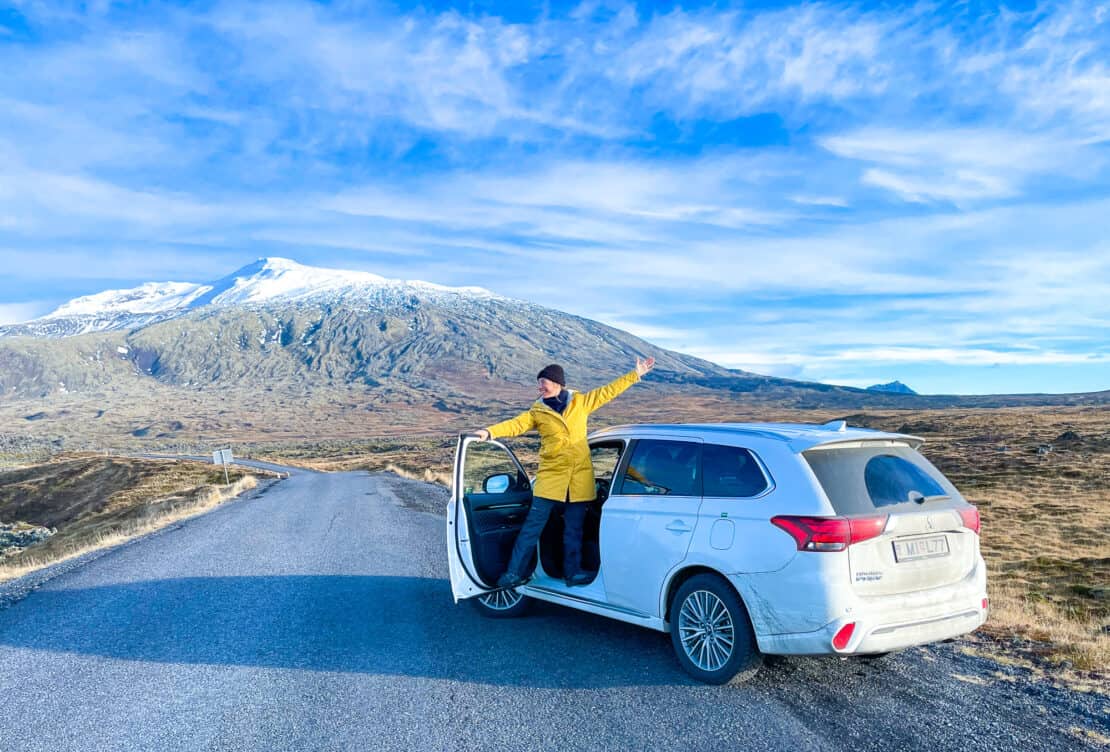
Table of Contents
Planning a Solo Road Trip
It’s no secret that we love road trips around here. They’re simply some of the best ways to explore a place. From the beginning to the end, you are the master planner. You decide for how long you will be travelling, where you will be staying, where you will be eating and so on. Plus, you can always be spontaneous.
If you are wondering how to plan a road trip by yourself then you’ve found the right place. I’ve driven solo through Europe and the US, through Africa and Australia, through deserts, mountains, cities and countryside. If you ask me, few things beat solo road tripping.
Learn from my mistakes. From my first solo road trip to my… hundredth. Probably. I lose count.
This guide will show you how to have a blast and come home with plenty of beautiful memories because each and every tip in this article has been tested. And tested and tested and tested…
Check out our list of road trip essentials before you go, don’t forget our road trip planner and, for fun, check out these road trip quotes!
Travel Tips for Your First Solo Road Trip at a Glance
- Plan Ahead:
- Research your route, destinations, and accommodations in advance.
- Ensure your vehicle is in good condition, and schedule any necessary maintenance.
- Safety First:
- Share your itinerary and expected arrival times with a trusted friend or family member.
- Carry a well-stocked first aid kit, and familiarize yourself with local emergency services.
- Pack Smart:
- Pack light and versatile clothing suitable for different weather conditions.
- Include essential items like a flashlight, multi-tool, and extra phone charger.
- Bring snacks, water, and a reusable water bottle for hydration.
- Navigation and Maps:
- Have a reliable GPS device or navigation app, and keep paper maps as a backup.
- Download maps offline in case of poor connectivity in remote areas.
- Stay Connected:
- Keep your phone charged and have a car charger.
- Consider getting a portable Wi-Fi hotspot for connectivity on the go.
- Rest Breaks:
- Schedule regular breaks to rest and stretch, especially on long drives.
- Plan overnight stops to avoid exhaustion and ensure a good night’s sleep.
- Budget Wisely:
- Estimate expenses for fuel, accommodations, meals, and activities.
- Have some extra cash for emergencies or places that might not accept cards. Though always bring credit cards with you.
- Embrace Flexibility:
- Be open to spontaneous detours or changes in plans.
- Allow for flexibility in your schedule to make the most of unexpected opportunities.
- Cultural Sensitivity:
- Research local customs and traditions to respect the culture of the places you visit.
- Learn a few basic phrases in the local language to enhance communication.
- Document Your Journey:
- Take photos, but also take time to enjoy the moment without the need to capture everything.
- Keep a travel journal to record memories and reflections.
- Prioritize your well-being by getting enough sleep and eating healthy meals.
- Listen to your body and take breaks when needed. Pit stops are vital. Audio books can help on long journeys too.
- Emergency Preparedness:
- Know the location of the nearest hospitals, police stations, and gas stations.
- Carry essential tools for minor vehicle repairs in an emergency kit. Know how to complete an oil change.
- Keep your roadside assistance details handy. And the paperwork from your insurance company.
- Solo Traveler Resources:
- Join online communities or forums for solo travelers to exchange tips and advice.
- Stay informed about local news and potential travel restrictions.
Remember to trust your instincts and have confidence in your ability to navigate and enjoy the journey.
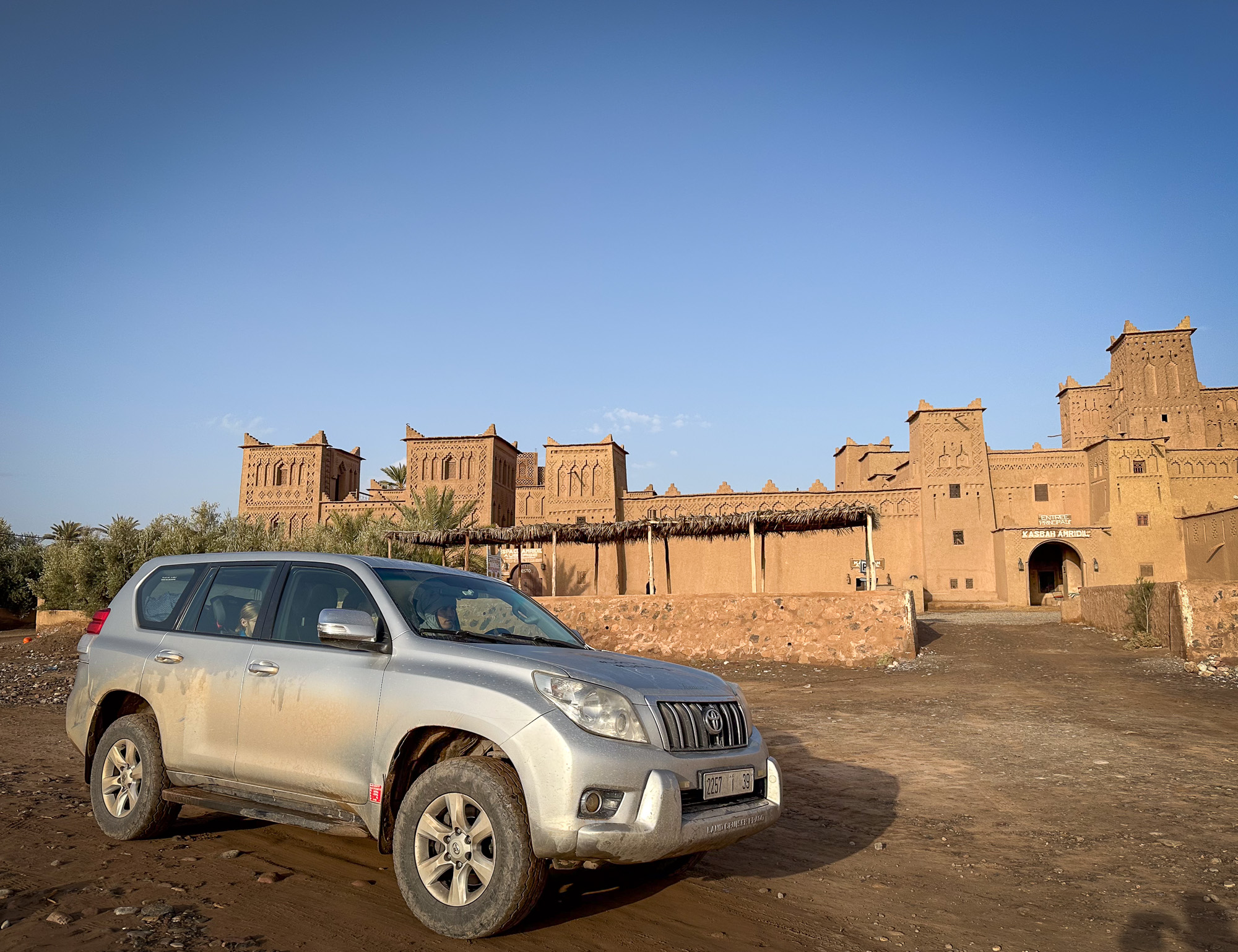
Step 1 – Where do you want to go ?
Every road trip begins with a dream. You are lying in bed thinking you’ve worked yourself too hard this year. Then you remember some old travel plans from when you wanted to drive around Italy or discover the stunning landscapes of Iceland. It’s time. This year you are taking your dream road trip, so let’s see how you can pick your destination wisely.
Home or Abroad?
Should your next road trip take place around the country, or should you drive beyond the borders? Many factors influence this decision, but if this is your first road trip, take it slow this time and visit places closer to home first.
It is a good way to test your limits and see if you enjoy hitting the open road alone.
If you’ve already had this experience, you are ready for a bigger adventure and to get out of your comfort zone, but take into account that travelling abroad usually implies extra planning. You may need to get a visa if you are travelling from the United States to Europe for example. You will also want to research more about the traffic rules if you don’t want to spend half your travel budget on traffic tickets.
Find Inspiration
Now the fun part of the planning process. You can spend a few hours reading travel blogs or checking out beautiful road trip destinations on Instagram.
Sometimes, a generic destination like Spain is all you need. You’ve already heard a lot about its main cities and it’s easy to find a pre-planned road trip itinerary (like this one on the best road trip through Andalusia or this one on the best road trips through Spain. )
On other occasions, you may spot a hidden gem like Ljubljana and learn more about it as you start planning.
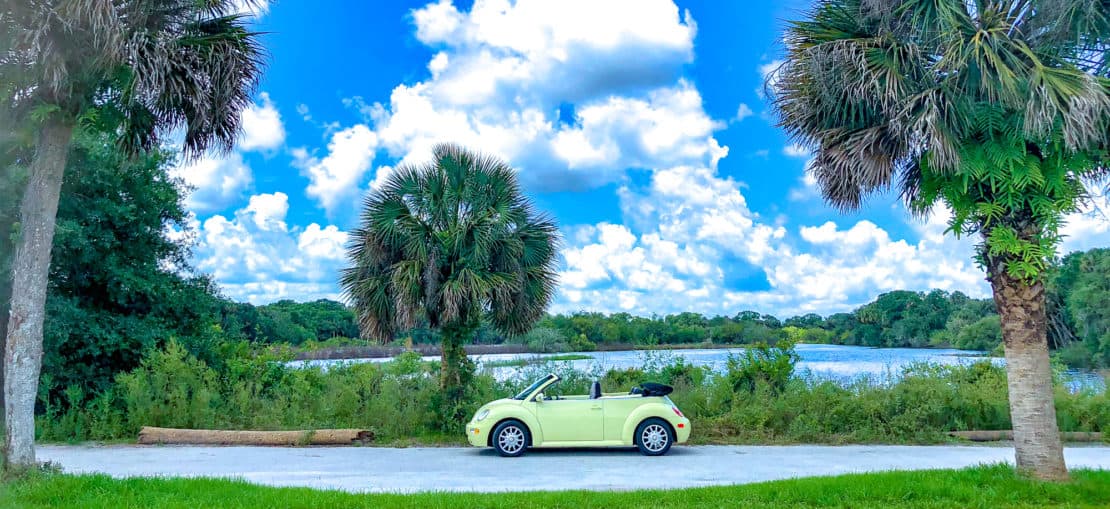
Step 2 – Choose Your Vehicle
Most people prefer to drive their own car but let’s face it, that’s not practical if, say, you live on an island as I do. Let’s chat through the advantages and disadvantages.
Your Own Car
Perfect for a solo road trip, a couple’s trip, or even a family trip if it is spacious enough, your own car offers one big advantage: it is yours. You are accustomed to it, and you will feel comfortable driving it once you hit the open road.
However, you need to make sure it is in good condition and can face the journey. If you plan on driving on mountain roads a lot, check that your car has enough clearance and can face steeper slopes.
Also, consider that not all vehicles have good gas mileage or petrol mileage. If this is the case with your car, it may be better for your travel budget if you find another option, even when you are planning only a one-day trip.
Of course, the obvious obstacle to using your own car is the difficulty in getting there. Iceland, for example, isn’t too user friendly when it comes to transporting cars from outside the country. In which case, when planning your road trip, you also need to consider renting or hiring a vehicle.
- Check out our car rental checklist here.
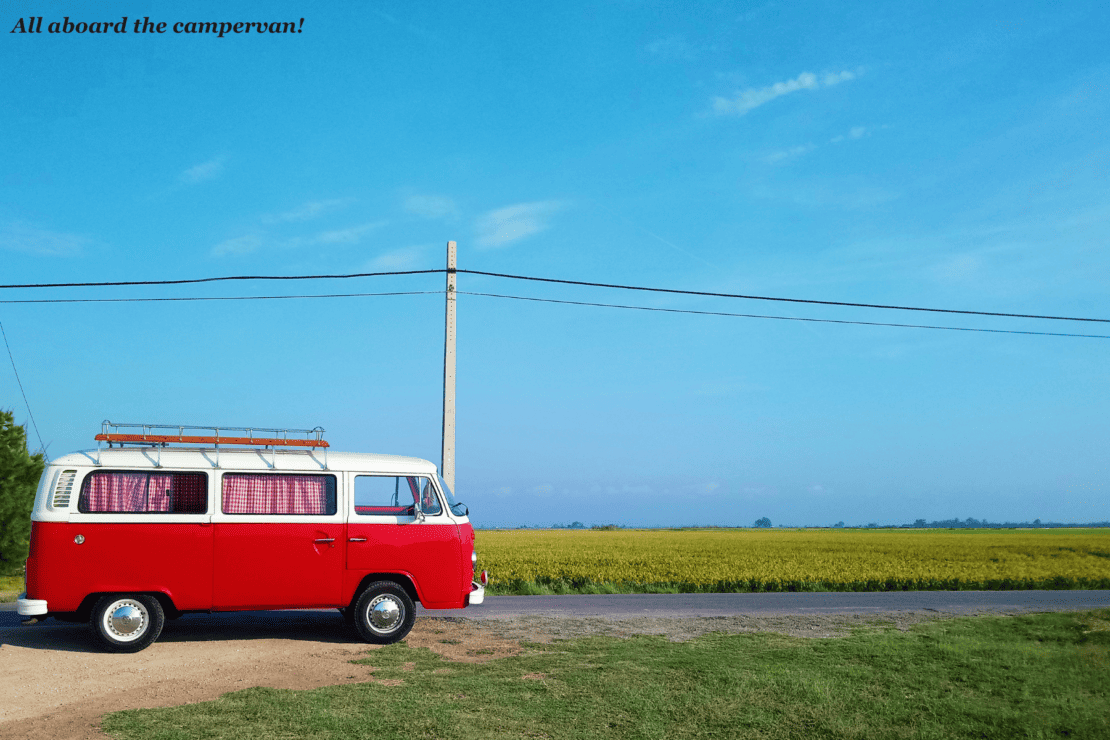
If you are taking a long road trip, maybe one that lasts months or years, it can be a good idea to invest in a campervan. It offers you a lot of freedom – you have a bed to sleep whenever you get tired, a kitchen to cook fresh food and save money, and you never need to go into the woods to wee.
Yet campervans are not for everyone. They are not as comfortable as a hotel room, and it can quickly get tiring to hunt for camping spots, not to mention emptying out the toilets.
- Read about the best campervan rentals in the UK here.
- Check out the best campervan routes in the UK here.
- And bookmark this list of the only campervan accessories you really need here.
Rental cars are typically a good choice if you are flying to another location and plan to start your road trip there. You can also rent a car if your own car is not fit for the itinerary you’ve chosen.
When you rent a car, you need to take into account the additional cost it generates and spend some time looking for the best deal. Otherwise, it can easily turn into an expensive way of travelling. If you plan on spending your first day or two in a city, for example, it’s often better to pick up your vehicle on day 3 instead of paying for parking in the city.
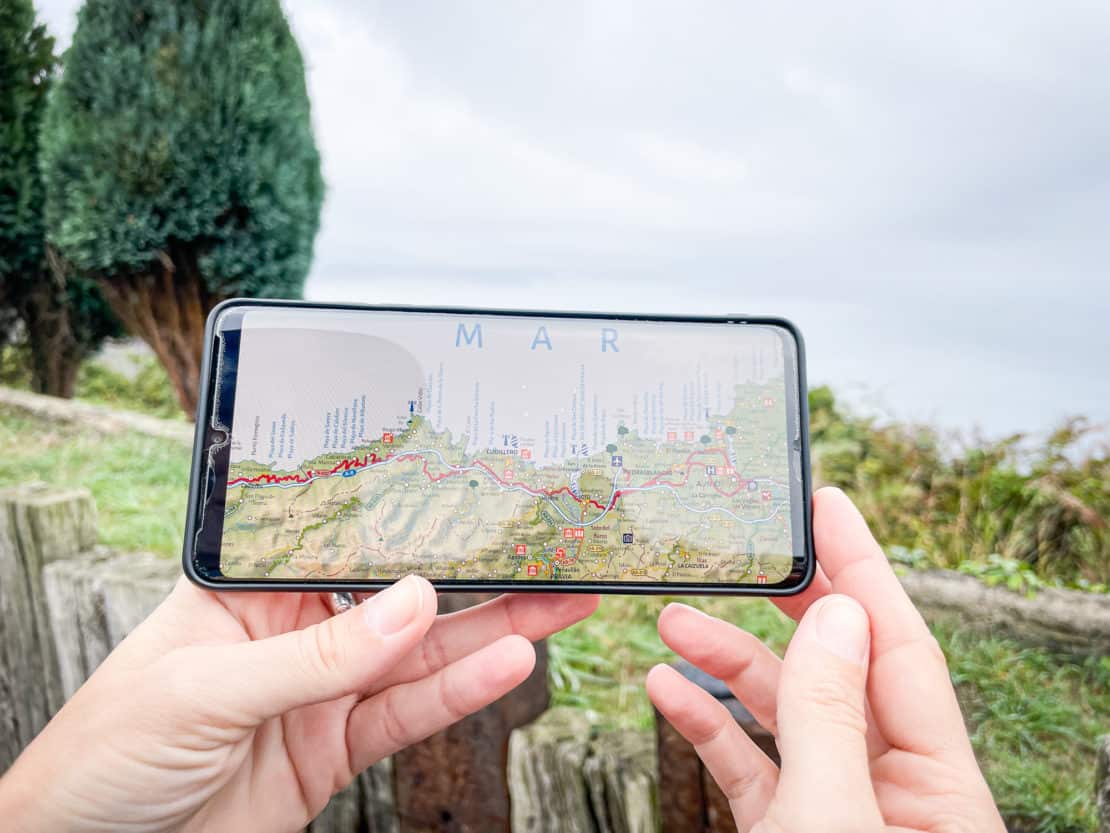
Step 3 – Draft Your Road Trip Itinerary
Start by deciding how much time you can feasibly spend behind the wheel. Consider how many miles or kilometres you need to cover. This time sketch will help you later in defining your itinerary.
To keep things organised, you can use a mobile app. You will find plenty out there, but unless you already have a favourite, it’s best to go with good old Google Maps. It’s there, it’s free, and well… it’s Google, so you know it won’t disappear the next day, taking all your planning efforts with it.
Go to Google My Maps and create an account. It will offer you access to some of the best tools for travel planning, starting with a custom map where you can add your starting point and build your road trip itinerary from there until you reach your final destination.
- Still stuck? Check out the method we talk you through in the Road Trip Planner and Toolkit©
First Draft: Establish the Most Important Landmarks
First, sketch out your overall plan. Note down your highlights, the places you simply must visit. Think of important historic sites and natural landmarks and let Google calculate your drive times. That’s your overview.
Second Draft: Refine Your Research
It’s time to establish the details, identify remote areas that don’t fit well in your itinerary and exclude them and find the best routes and places where you can have a good coffee while on the road.
Attractions per Town
Search the main attractions in each town on your list and add them to your itinerary (but only if you want to. There are so prizes for “seeing everything.”)
Look for castles, cathedrals, museums, parks, beaches, and so on. Each place is different, so read a bit more about it to see what is worth visiting. Also, consider roadside attractions and see if there is a more scenic route that can take you to your destination. Road trips are more about having a good time and less about getting to the final point as fast as possible, after all.
Restaurants and Cafes
Sometimes, stopping along the road to eat can be one of the best moments of the day. If you are hoping for a great road trip, don’t leave this to chance. Search for the restaurants and cafes on your itinerary and add them to your list. With Google My Maps, all you need to do is type the word ‘restaurant’ or ‘café’ in the search bar, and it will show you the best places in the area. It will also show you opening times, too.
Of course, you don’t need to stick to a specific place for each town. But it helps.
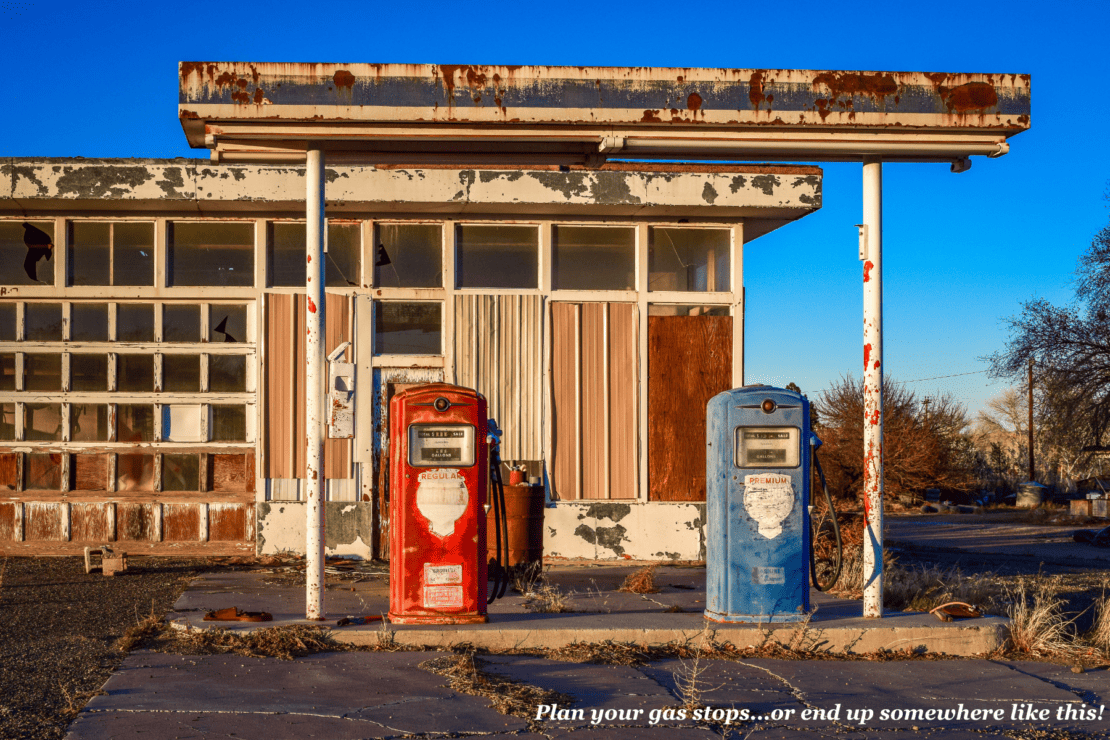
Petrol or Gas Stations and Supermarkets
Even more importantly, if you plan on driving off the main road, you must consider two essential aspects: where will the next petrol or gas station be and where you can stop for supplies. Add gas stations and supermarkets to your map and check it before heading into the mountains or taking a country road. The last thing you want is to be left without fuel in the middle of nowhere.
Step 4 – Set a Road Trip Budget
Even if you are not a big spender, for a successful road trip, it’s best to plan your budget in advance. There will be areas where you will spend more – big cities tend to be more expensive, so set aside more money for them. You can balance these expensive days with days spent outdoors where you usually don’t need to pay a fee.
Not a natural at budgeting? Me neither. There are two approaches – a predefined spreadsheet written for you or a totally different approach. You can find both in our Travel Toolbox© here.
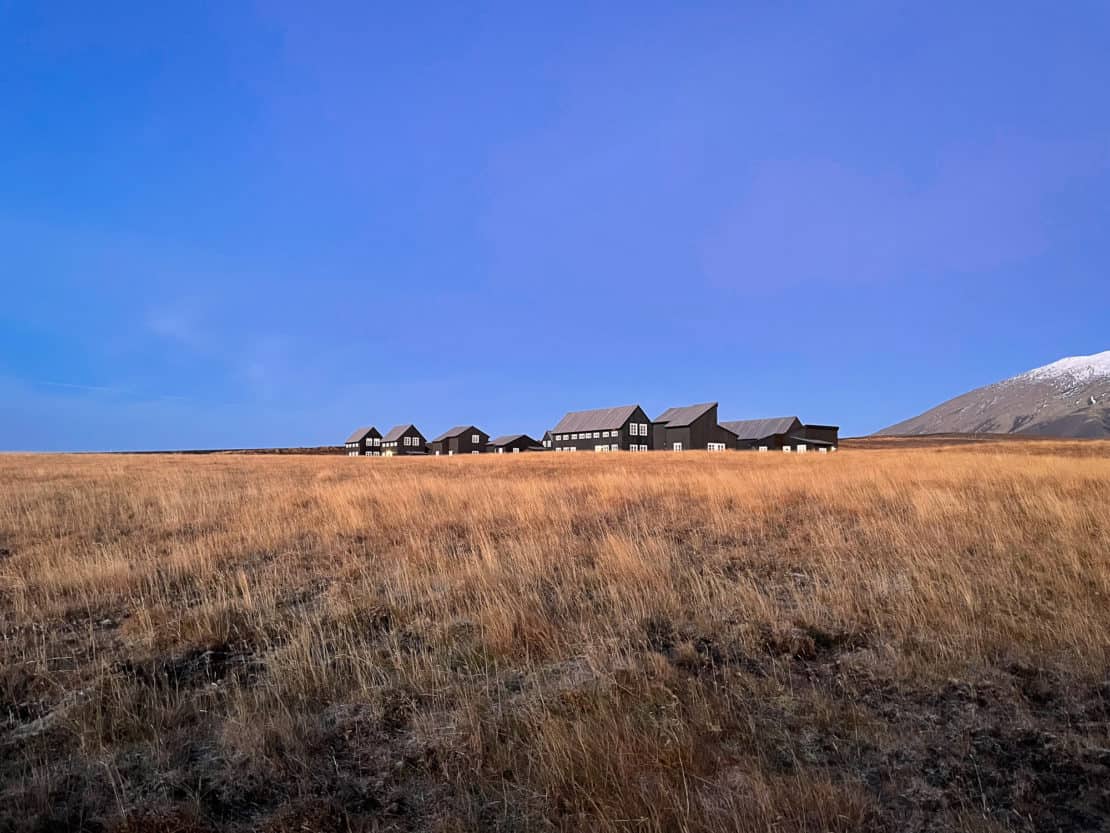
Step 5 – Where Will You Stay?
The golden rule is to book your accommodation in advance to make sure you have somewhere to sleep once you arrive. Where you will be staying depends a lot on your personal preferences, but here are your options:
Hotels offer the most comfortable road trip experience, in my opinion. You will have a cosy room at the end of the day, possibly a nice restaurant where you can have dinner, and best of all, you don’t need to make your bed or perform a thorough cleaning extravaganza before you check out. Hotels are often the best fit for travellers taking a short trip. They also often offer parking, which is often free outside the main cities, but check with them just to be sure.
A final bonus? They are usually staffed 24 hours a day so you don’t need to stress about what time you turn up.
Airbnbs or equivalent tend to be cheaper for those who will be on the road for a long time. You can book studios or apartments with a kitchen and cook your own food if you want to save money. Some of them are also equipped with washing machines and driers that you will definitely need to use if you’ve been on the road for more than a week or are travelling with very young children.
What’s not so great about Airbnbs, especially apartments, is that they don’t always offer parking. Also, you need to clean and sometimes restock everything before you check out. And finally, it can be tricky to sort out an arrival time and call someone in advance to get the key. With a hotel, you know there is always going to be someone there when you arrive.
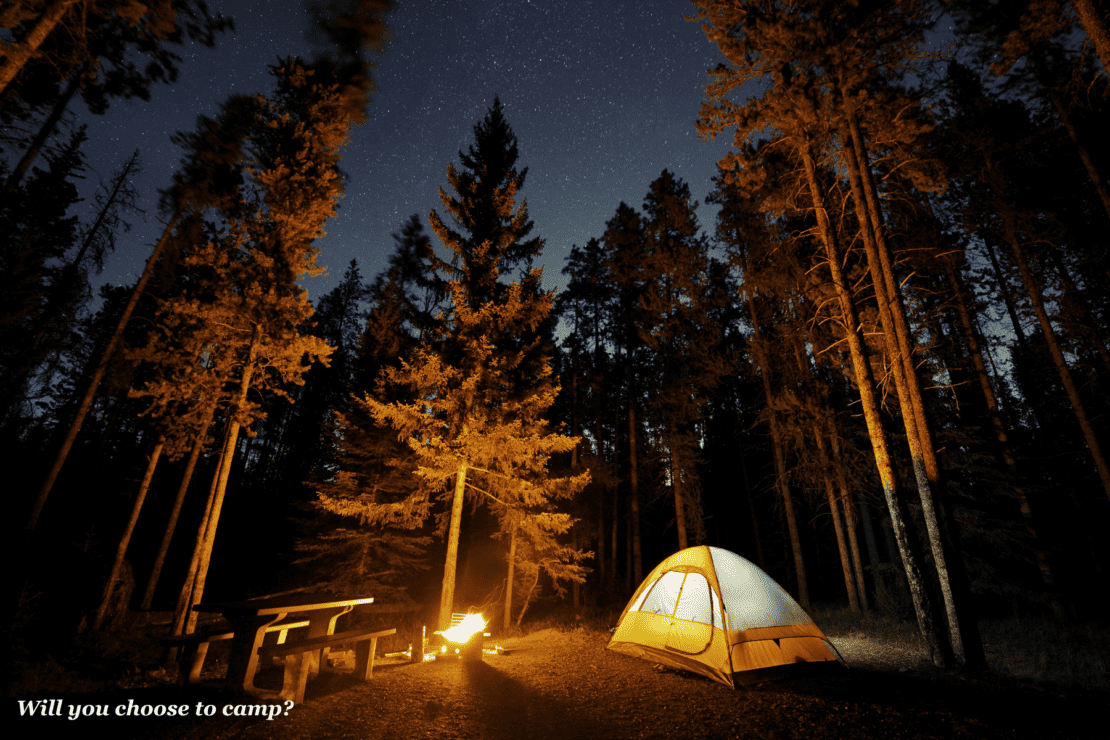
Driving a campervan may seem like an easy way to sleep in exotic locations. Want to wake up on the beach? You can have it. Sleep in the woods? Easy! Or is it?
Things are not always as easy as you think. You will need to find a camping park to make sure you stay safe and don’t get a parking ticket, and often the best ones aren’t free. Of course, there are camping areas where you don’t need to pay, but you will need to search for them in advance and sometimes modify your itinerary to accommodate them.
Plus, you need to maintain your campervan, deal with emptying the toilet waste and other, well, challenging activities.
What to Pack for a Road Trip
Check out our full road trip essentials packing list here. But in brief…these are some of the objects you will want to have in your car when you are travelling for days, especially on your first time.
- Car chargers – you will use Google Maps almost non-stop, so you will need to keep your phone charged.
- Paper map – you never know when you will be left without a signal, and you need to quickly find your way back to the main road.
- Cosy blanket – perfect if you are taking the kids with you. Keep them warm if they fall asleep on the road.
- Cooler – if your itinerary includes a solitary beach or an isolated mountain trip, carrying cold drinks and lunch is an excellent idea.
- Spare tyre – it goes without saying that you need to have your spare tyre with you. And if you’ve never changed one, it’s time to learn.
- Jumper cables or jump leads – you think it won’t happen to you. But it only takes a moment of distraction to leave your lights on before you start a 2-hour climb. You’ll return to a dead car, so you should at least have the jump leads with you in case you find some other driver to help you.
- Flashlight – you may never use it, but you should have one in your car. It can prove useful if you get a flat tyre while driving at night.
- Water – stock up on water whenever you can, especially if you are travelling during the summer.
- Snacks – if you get hungry, you get cranky. This is not the mood you want in your car during a road trip. Take some non-perishable food with you.
- Cash – some small towns and villages still rely on cash when it comes to transactions, so bring some with you if you want to keep things working smoothly.
- Tissues – useful in so many ways.
- Dry shampoo – being on the road for days can get tiring, and you may not feel like washing your hair every evening. A bottle of dry shampoo can get you looking clean for the photos the next day.
- Lots of clothes – some accommodation spots may offer a washing machine but most don’t. Pack plenty of clothes to stay clean and comfortable.
- Sunscreen – it’s always wise to pack sunscreen.
First Road Trip? Try to Avoid These Mistakes
We were all first-timers once. And this means we made mistakes. But we learned from them, and here we are imparting our experience with you, so you don’t have to deal with the problems we encountered over the years.
Not Planning for Free Time
You are excited, and you may be tempted to squeeze as many tourist attractions as possible into your itinerary, thinking that you may never go on this road again. Well, you may be right and wrong at the same time. Even if this is your only chance in this life to visit, let’s say, Iceland, you will gain more if you see less of it. Reduce driving time to have a great time and stay longer in one place. Give yourself a moment to just stroll around, be lazy, or try something that’s not on your itinerary.
Picking the Wrong Season
Most people go on holiday or vacation during the summer. It is understandable. The weather is warm, you hope to avoid rain, and all the restaurants and hotels are open for business. However, don’t overlook spring or autumn (or even winter for that matter!) Outside peak season, you don’t need to wait in line to visit a museum and often get better prices for your hotel rooms.
Sometimes, you don’t have other options though. Some national parks are open only in the summer, and some event dates are set in stone. If you do need to hit the road during the high season, book your stay well in advance and buy tickets to the attractions and events on your list before you reach your destination.
Forgetting to Download Offline Maps
This is a must! Whenever you are approaching a location that may have bad or no signal, stop and download the map to that area to your phone. It is easy to get lost when you don’t know the roads, and sometimes there’s nobody there to get you back on track. Imagine losing hours on a mountain road when the night approaches and you don’t know where to go.
Not Packing Nutritious Snacks
Throwing a few bags of chips and some soda in the trunk to keep you fuelled for more than half a day is simply not a good idea. They won’t keep you full, so you will quickly feel hungry again. If you know you won’t find a good restaurant on your way, pack real food to help you stay energised and happy. Think hummus, cheese, grapes, bread, sandwiches, and maybe some homemade cakes. Not only that you will avoid getting sick while on the road, but you will save money you would have otherwise thrown away on fast food. Pack extra snacks if you’re travelling with young children.
Not Bringing Enough Water
Buy a big jug of water and place it in the trunk. Yes, it will get hot, and you won’t feel like drinking it. And, yes, you can stop at service stations or gas stations to buy more fresh water. But you never know when your carburettor gets hot and you need a quick way to cool it down. Plus, if you forget to download the maps and get lost, a reserve of water can prove useful, even if it isn’t the freshest in the world.
Not Keeping a First Aid Kit in the Trunk
If you are travelling with kids, you will probably need it at least once during the trip. But from our experience, adults also tend to get hurt when they go out in nature. The first aid kit won’t help you if something really bad happens to you, but the bandaids and distilled water will come in handy if you hurt your knee in a fall. Make sure it includes painkillers and paracetamol, antiseptic cream, and antihistamine tablets if one of your fellow travellers is allergic to something.
Running Low on Gas (Or Petrol)
Know from the start when you are about to cross a rural area or find yourself close to the wilderness and fill up. The petrol and gas stations are rarer in these zones, and if you do find some, you will quickly realise that the fuel can be outrageously overpriced.
Strictly Following the Itinerary
Having a good plan is important. But you need to remember that you made it – and you can change it. Did a local tell you there’s a spectacular beach five minutes out of your way? Go for it, even if this means you’ll skip a museum in the next town that sounded boring from the start anyway.
Lavender fields or a romantic monastery with a lovely vineyard to the right? Go to the right.
You don’t want to have the same memories as every single traveller who drove on this route. It will always feel as though you don’t have much time for wandering around.
But you do because this is your trip and you decide on everything.
VIDEO : The 7 Best Road Trip Planning Tools
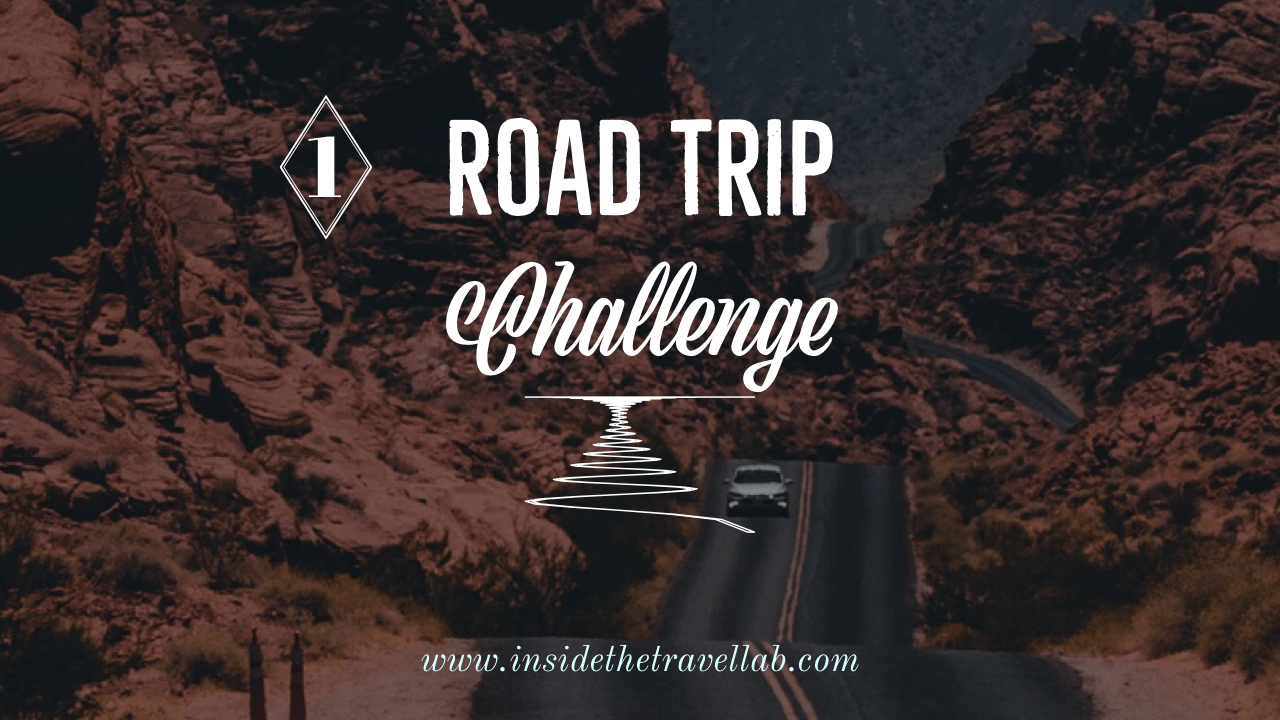
Buy the Road Trip Planner & Toolkit
Make your life easier with the Road Trip Planner and Toolkit. Shop for your copy here.
Road Trip Itineraries
Check out some of our most popular road trip itineraries, from driving the Deep South USA to the best road trips in Spain.
Road Trip Resources

- Road Trip Alone: Your Guide to Planning the Ultimate Solo Road Trip
by Samantha Burmeister | Jul 13, 2020 | Traveling
Ah, the great American road trip.
Just saying the words, “Road trip” conjures up images of people piled into a car, cruising Highway 66, and blasting sing-along music with the windows down.
But, what if the record scratches and the image of a road trip becomes just one person in the car?
As solo travel gains popularity, especially among women, the idea of the perfect road trip is changing. But, if it’s your first time taking a road trip alone, you probably have some questions, and perhaps a few fears to get over first.

So, You’re Interested in Road Tripping Alone?
First of all, THAT’S AWESOME!
I’m so glad that you’re here, and considering hitting the open road with you, yourself, and you. You’re going to find so much freedom in the journey, and will come back a more independent and interesting person. So cool.
If you aren’t sure where to begin, THAT’S FINE. Keep reading, because that’s what you’re going to learn!
My breakdown of the financial aspect of spending 6 weeks on the road Watch the video of my week-long drive through the Balkans Read about how I make friends while traveling solo
Here are the four areas that we’re going to cover to ensure that YOU have a successful road trip alone:
- Mindset – Your mindset is the foundation of doing anything well. We’ll talk about moving through your fears and getting EXCITED about this growth opportunity.
- Logistics – What you need to do BEFORE hitting the road to ensure smooth sailing.
- What to Bring – Ah, yes, packing lists galore. PLUS all the apps and other things that you shouldn’t leave home without
- On The Road – Doing the darn thing, and doing it well.
*Side note before we get started:
I do teach this in a course. In this article, I’m going to tell you what to do. If you want to get some 1:1 advice on how to do it, then join the course here .

1. Mindset: The Core of A Solo Road Trip
What is the reason that you have not yet taken a solo road trip?
1.1: Eliminate What’s Holding you back
For some, it’s the lack of opportunity: you’re young and haven’t been on your own long enough to hit the road without your parents. For others, it’s fear: you’d rather have someone alongside you in case anything goes wrong.
When you’re preparing to take a solo road trip, it is important to identify what has held you back from taking one in the past.
Once you’ve identified what is holding you back, think about what you can do to eliminate that risk.
For example, I was not looking forward to spending hours upon hours staring at the windshield. On top of that, I don’t know much about cars, so I was worried that if something happened to my car, I would be stuck in the middle of nowhere, plus have the expense of towing and getting my car fixed.
To decrease those reservations, I took my car in for a check-up, got the oil changed, and subscribed to AAA. To combat all the boring time behind the wheel, I downloaded e-books and podcasts to keep my mind busy.

1.2: Decide what will move you forward
Once you’ve figured out what’s holding you back and how to decrease or eliminate your fears, you can fuel that energy into excitement.
This means that you get to start planning your trip and creating ideas of what you’d like to do, and what you want to get out of your trip.
For example, do you want to hike a mountain alone? Do you want to spend hours driving Highway 1? Maybe you want to tour a bunch of breweries across the state of Montana (and then not drive afterwards, of course!).
When you think about what will move you forward, don’t just think of bucket list items. Instead, think about what will help you achieve your goals. For example, many people want to become more independent, so they decide to road trip alone.
- Will you feel more independent when you’ve stayed in an AirBnb solo?
- Will you accomplish that feeling after learning to paddleboard in Florida?
- Will you succeed in feeling more independent after finally figuring out how to use the self-timer feature on your camera to showcase your solo travels to the world?
It’s up to you!

2. Logistics: What to do before hitting the road
Besides moving through your mindset, the logistics can feel like the most daunting part of the road trip.
Want to know a secret? I rarely plan more than one activity per day when I’m traveling solo.
This lack of planning means that I only focus on the important things: What will be fun, and where will I sleep?
However, I know that there are lots of things that I need to do to have a successful road trip. Let’s break it down in to three less cumbersome categories:
- Where you’ll stay
- Preparing your car
- What to do along the way
2.1 What You’ll do
It might seem counter-intuitive to plan your activities before you plan your destination, but trust me here.
Think about this: If you decide that you want to road trip to Minneapolis from where you live in Chicago, that’s great. But, what if you find something super cool that you want to do, but it’s a couple of hours out of your way. If you went ahead and booked a hotel in Minneapolis, you might end up doing something completely different, just because you locked yourself into accommodation first.
Instead, take the time to plot out all the fun things that you want to do. You can find quirky roadside stops by searching RoadsideAmerica or SillyAmerica. You can ask your friends, locals, and blogs about cool spots in and around the places you’ll be visiting.
Once you have an idea of where you want to go, you’ll be able to decide where you want to stay.
I always caution people, though: Plan one big thing to do per day. This way, you don’t get bogged down trying to rush from activity to activity, rather than just enjoying the big-ticket items on your list.

2.2: Where you’ll stay
I’ll start by saying this: nobody can plan your dream trip for you.
Therefore, you need to stop and think about what you want this trip to look like. If your idea of fun is a 5-star hotel that you never have to leave that has a great view, then do that. If camping off the grid in a national park for a week is more your style, then do that.
Here’s how I recommend booking your accommodation:
- Figure out where you plan to enjoy yourself. This is important because if you want to climb mountains in Rocky Mountain National Park all day, staying in downtown Denver probably isn’t your best bet. Therefore, when you know where you want to spend your time, you can better plan your accommodations
- Use the map feature on sites like booking.com and airbnb.com to find accommodation close to where you want to be
- If you plan to camp, use reserveamerica.com, bookyoursite.com, pitchup, or hipcamp
While you don’t have to book your entire trip’s accommodation before you go, it’s a good idea to get a feel for what it will cost, and if the places you want to visit are booked out in advance.

2.3: The Drive
Now that you know where you’ll go during the day and where you’ll lay your head at night, you can plan the trip itself.
When it comes to driving, here are a few things to keep in mind:
- Know the laws about talking on the phone while driving, and adhere to them. Nothing bums out a solo trip like getting a ticket
- Download audiobooks, playlists, and podcasts in advance to avoid using a bunch of data
- Save your destinations in offline Google maps to make sure that if you lose signal, you can still get where you’re going
- You can save all your attractions as pins in your Google maps to make them easily accessible
Before you go, make sure to take care of your car:
- Get the oil changed
- Have an expert make sure it’s safe to road trip with
- Fix any headlights, etc.
- Know where your spare tire is and how to use it
- Make sure your AAA membership is up to date in case you need it
3. What to Bring: Technology & Packing to road trip alone
If you take one thing from this portion of the article it’s this: If you forget something, it’s okay. You can probably buy it or download it where you’re going, because other people who travel there need the same things that you do.
So, before you start creating your packing list and downloading these apps, take a deep breath. These are guidelines, and if you forget something, it’s okay.
That being said, there are a few things that I recommend every traveler do.

3.1: Download the right apps
First, you’ll need to make sure you have the right technology in your phone. The first thing I want you to do is download Google Maps, then do the following:
- Use Google Maps to plot the locations that you’ll be visiting
- Share that map with someone as an extra layer of safety
- Download offline maps of where you’ll be going in case you lose signal (here’s a how-to video)
Additionally, here is a list of the apps that I think every traveler should have.
Other apps you might want to download include:
- Accommodation – hoteltonight, hipcamp, reserveamerica
- For your car – AAA, gas buddy
- For listening – Apple Podcasts, Spotify, Stitcher, Audible, Libby
3.2: Now, let’s talk packing.
The best thing about road trips is that you don’t have to fit your world into a carry on. If you want to, you can fill your backseat with every piece of clothing that you own!
However, overpacking is still a thing, and I don’t recommend it.
The thing is, I can’t tell you what to pack, because a camper will need very different things than a city-based sightseer. And maybe, you’re going to be both of those things on this trip!

Here’s what I recommend:
- Write down the places that you’re going to visit, and what you’ll need at each
- See which activities need the same items. For example, you might need a sundress for sightseeing and also for lunch with friends. You might need a flashlight for camping and also if you visit a cave attraction.
- Then, make your list and see where you can use the same item for multiple activities.
- If you need someone to check over your list or give you additional help, reach out to me, or ask a friend that has taken a similar trip.
- Again, if you forget something – you can probably pick one up along the way!

4. Hit the Road!
This is the fun part!
You’ve done what you can to prepare yourself. Your car is set, your plans are made… now get out there!
Part of the growth experience of solo traveling and taking a road trip alone is the ability to maneuver when something goes wrong. Not everything will go according to plan. You might forget to buy a ticket for something and not be able to do it. You might sprain your ankle on a hike. Who knows, you might get tired and decide to skip activities altogether.
However, you’ll also be able to do something different than you originally planned. You’ll kayak instead of hike. You’ll drink a cup of coffee and do something different.
That’s the beauty of taking a road trip alone: you get to decide what you want. It’s all about what makes you happy, comfortable, and independent.
So get out there!
Recent Posts
- Is it Morally ok to Travel During the Pandemic?
- I decided to quit blogging
- Why Going On A Solo Road Trip Is Self-Care
- Best Places to Solo Road Trip: USA
- Destinations
- Digital Nomading
- Ethical Travel
- Sam's Thoughts
- Solo Travel
- Travel Finance
- Travel Planning & Resources
- Skip to content
- Skip to primary sidebar
This Rare Earth
A travel resource for the adventurous and often-solo female
Essential Tips for Planning a Road Trip Alone
Blog , North America , Solo Travel , Tips & Resources , USA / November 29, 2023 by Monica / 2 Comments
Taking a roadtrip alone can be a daunting experience if you don’t know where to start. How to prepare, what to pack, and how to stay safe are all valid concerns. Luckily, I’ve been taking solo road trips for years and have TONS of helpful tips to share, and a road trip checklist, too.
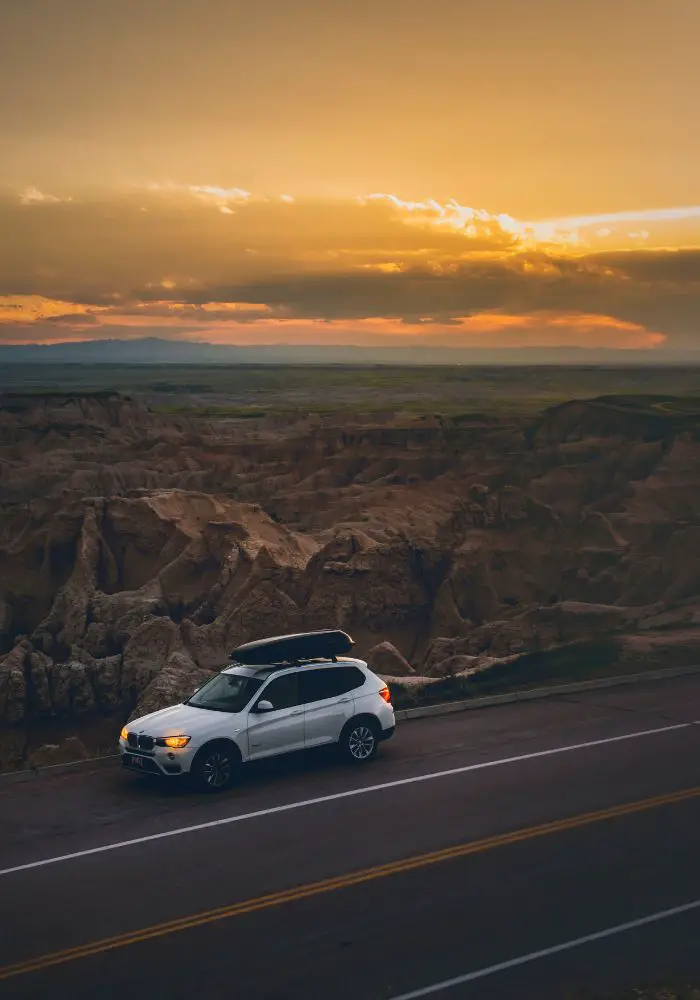
Road trips are the ultimate freedom. Whether you are road tripping solo or with friends , the undeniable feeling of independence is unparalleled.
You aren’t forced to operate on an airline’s schedule. You don’t need to sit in cramped bus seats next to strangers. And, you are free to stop and detour anywhere you like along the way.
Planning a road trip alone takes things one step further. You don’t need to compromise your schedule, stops, or how many hours you’ll drive in a day with any other human being.
Not to mention that all that time alone on the road offers some great time for reflection. That’s just one of the great benefits of solo travel .
It’s all up to you. And that is amazing.
Solo road trips are hands down one of my favorite ways to travel.
I have now completed a total of nine road trips across the United States (six of them solo), as well as in Lithuania , Mexico , Aruba , and more. At this point, I am pretty confident in my road trip skills and know exactly what my “essentials” are for any climate.
Here I will share some helpful tips on driving long distances alone, as well as how to prepare before you hit the road. By the end, you will feel ready to hit the road solo.
Bonus, I’ve even included a printable checklist to help you on your way. Let’s dive in!
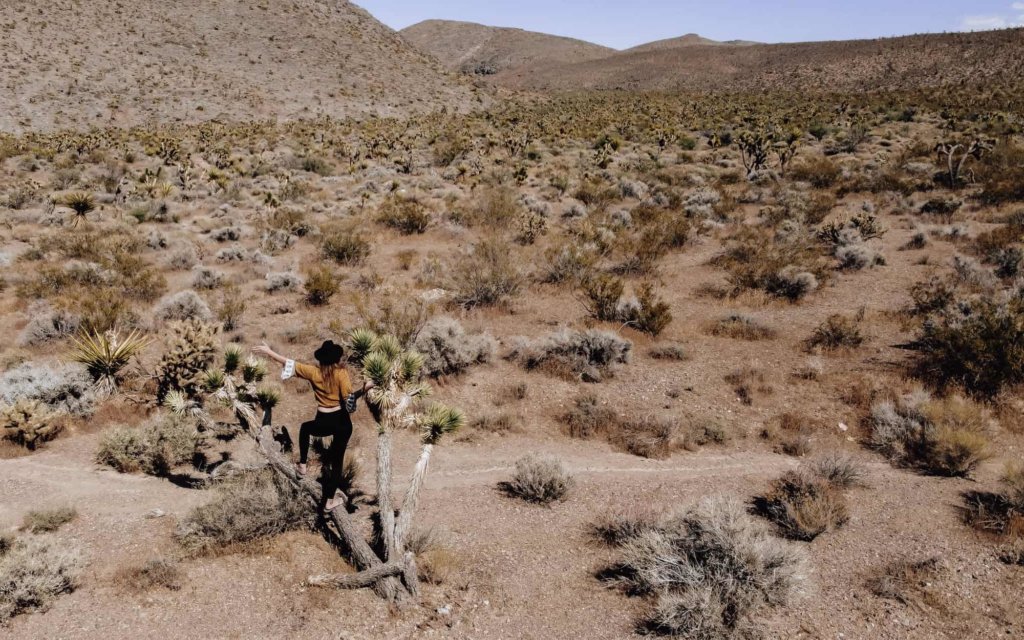
Table of Contents
Planning Your Trip
This section will cover how to plan and prepare for your trip.
1) Determine the length of your road trip.
Before you do anything else, you need to identify how many days you plan to be on the road. Are you taking a two week vacation from work? Are you setting out for a month? Or just for a weekend?
Identifying your time frame is an obvious but important step. You need to be able to realistically plan how many hours you are able to drive (especially alone) in one day.
You won’t have anyone to swap places with so be honest about how tired you get, how uncomfortable you get, and how far you need to get.
Which brings me to the next step.
You May Also Like: An Epic Road Trip from California to Arizona
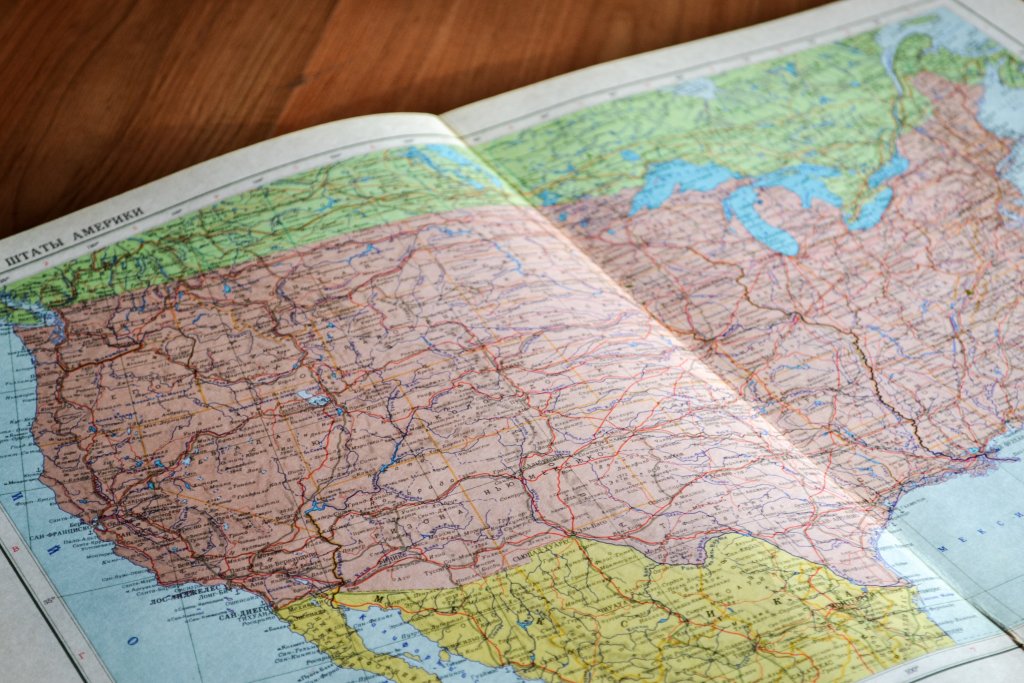
2) Choose your destination.
Do you have a specific national park or city that you are ultimately heading toward? Or are you going out for simple exploration?
Oftentimes we have a goal or a place we want to reach at the end of the line. For instance, I’ve recently traveled from southern California to see the unbelievable Seven Magic Mountains art installation and the Valley of Fire State Park in Nevada.
And, separately, I’ve driven from Los Angeles to Joshua Tree and then Joshua Tree to Death Valley .
But, if you have the time, you may want to plan a larger trip with multiple destinations along the way, spanning multiple states and multiple sites. Pull out the map and start your research.

This is important to think about up front because it will help you configure how many hours you will need to drive in a day.
If you are planning a long road trip, you will want to gather a fair idea of what sights you want to see along the way and how far apart those places are.
You don’t necessarily need to evenly split your drive time hours between days. In fact, that rarely works out, because some parks or sites might call for several hours of exploration and hiking , while others warrant a quick 15 minute photo stop.

3) Prepare Your Car.
If you are taking your own car on the trip, I highly recommend making sure everything is in top shape before you go.
Is your tire pressure correct? Do you have enough windshield wiper fluid? Are your brakes in good shape? Do you have a spare tire?
If you know how to do these checks yourself, great! Absolutely do it!
If you don’t, you should definitely book an appointment to have these quickly checked out at your local auto shop before you go. Your safety is important.
Taking an hour out of your day for a quick car checkup might save you hours of trouble later on. Being broken down, or stuck by the side of the road, possibly with no cell service, is not a great situation to be in.
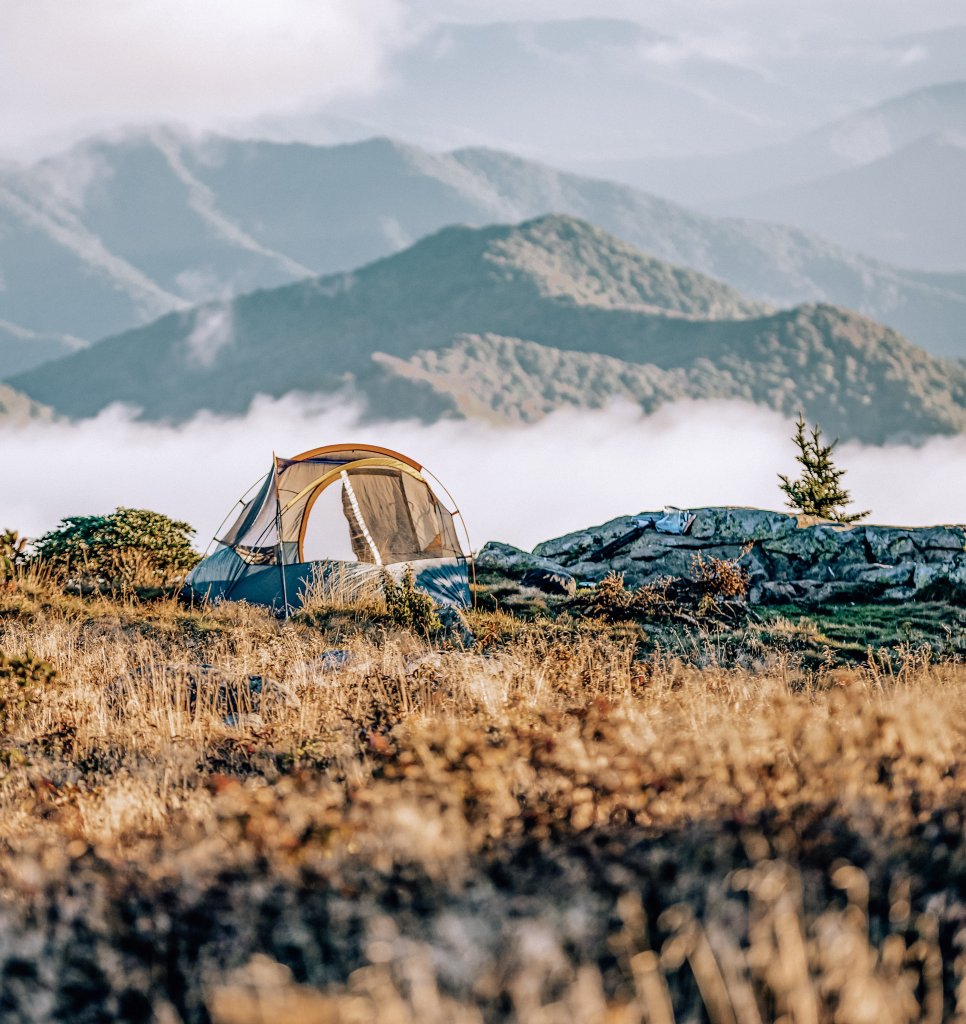
4) Know where you plan to sleep.
Will you be camping along the way? Will you need to book hotels ? Where do you plan to sleep?
This could also determine how many hours you need to drive in a day, particularly if you need to reach a certain campsite or hotel before nightfall.
There are some pros and cons to consider, too.
If you are a planner, you can book each of your stays before you even leave the house. But then you won’t have much wiggle room in terms or your location goal each day. If you want to go where the wind takes you, and not book any hotels in advance, that’s also fun to do.
Pro Tip: be mindful if you plan to go camping alone that you are reaching the sites before sundown. It’s pretty annoying to try and pitch a tent in darkness.
5) Be ready for emergencies.
Have you ever run out of gas in a deserted area? Or blew out a tire and didn’t have a spare? If so, learn from it! Or if you haven’t, learn from me.
Here are a few solo road trip essentials for a roadtrip alone:
- A Spare Tire
- A Tire Pressure Gauge
- An Extra Canister of Gas (if you are in a truly deserted spot)
- A Paper Map (or a downloaded one). Don’t rely on cell signal alone.
- An Extra Set of Keys
- A Car Battery Jump Box
- License / Insurance / Registration (and/or car rental papers and passport)
- CASH for tolls
- Share Your Itinerary With a Friend (particularly if you’re feeling nervous or it’s your first time road tripping alone)
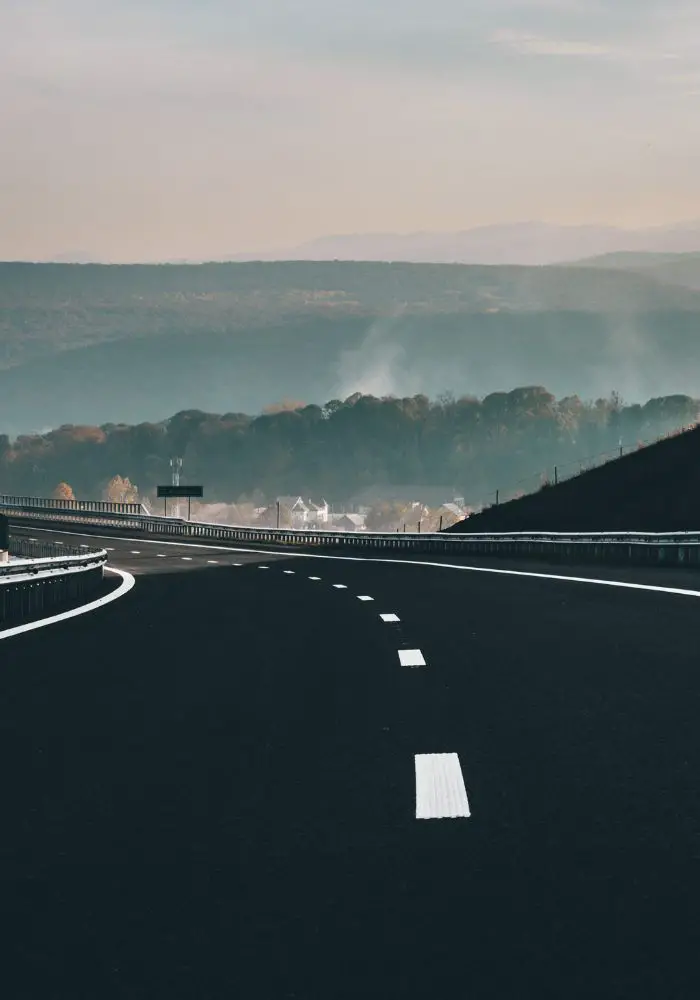
On The Road
Now that you have determined your trip destination, length, route, and prepped your car, it is time to hit the road.
While the information above will set you up for safety and help you prepare, there are also a number of things you should keep in mind while on the road.
1) Pack some entertainment.
While on some of my solo road trip adventures I prefer listening to great music, there are also many trips nowadays that I’m more interested in podcasts.
Podcasts and audiobooks are a great way to go. They can make the time fly between sightseeing, and I like to get wrapped up in whatever the topic of choice may be.
Pro Tip: Check out my full list of the best travel apps here!
I recommend downloading a few podcasts and audiobooks in advance, because you will probably hit areas with no reception. Check out the linked apps list above for the best podcast and audiobook options.
2) Don’t forget cables and chargers.
Nowadays we have all kinds of electronics we carry, from cell phones to cameras to iPods to tablets. Be sure to bring the correct cable for each item you plan to bring.
If you’re camping, keep these plugged in while you drive so that when the car is off overnight, you already have a full battery.
If you are staying in hotels, it’s less of an issue. No matter if I stay in a tent or some other accommodation, I always carry a portable power bank . It is a complete “must” for me.
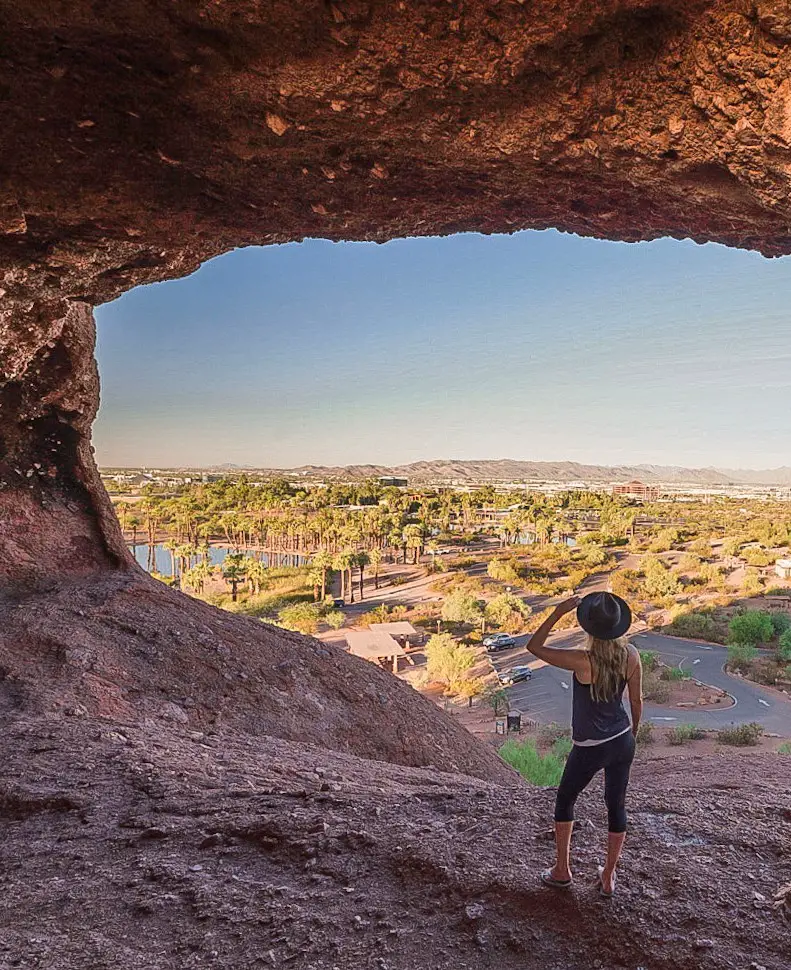
3) Definitely pack your hiking gear.
You probably know by now, I love the outdoors. I’m always ready for outdoor exploring in any climate and on every trip. I simply pack my favorite hiking gear and keep it in a separate day pack on the go.
Pro Tip: The following articles can help you plan your hikes:
- The Best Hiking Gear for Women
- How To Plan a Hiking Trip
- 23 Hikes in Southern California
- 100 Hiking Captions and Quotes
- Health Benefits of Trekking and Hiking
4) Have camping gear handy in the trunk.
If you plan on camping (and perhaps even if you don’t intend to!) you will want to stash your sleeping bag and tent in the trunk.
Make sure that you know how to pitch that tent solo, too! If you’re feeling rusty, absolutely go through the process before you leave home, silly as it may seem.
You’ll also want to pack a flashlight or a headlamp whether you are camping or not. This can come in handy both inside the car and out, and is lightweight and barely takes up any space. I even recommend leaving one in your glovebox permanently.
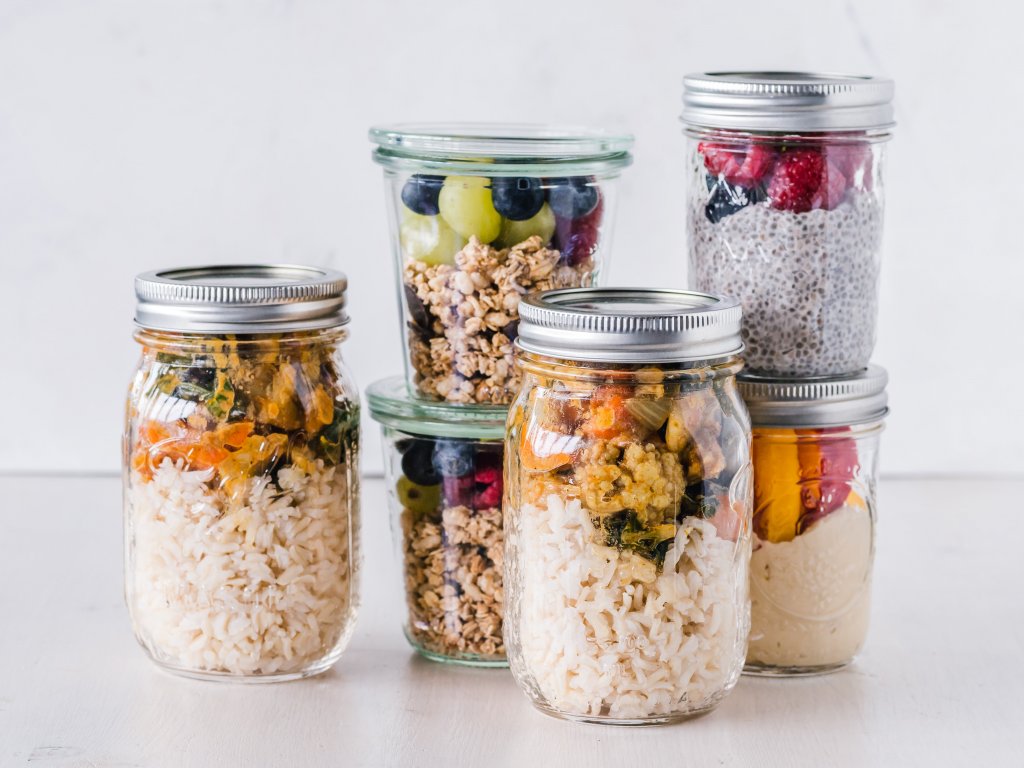
5) Bring your own snacks!
What’s a road trip without some good car snacks?
You need some tasty fuel for your body while on the road! In my opinion, gas station food just doesn’t cut it for breakfast, lunch and dinner.
I recommend to pack a cooler with your favorite drinks and portable food before you leave, and replenish at the grocery store as you go. This is what I always do myself.
Pro Tip: make a road trip food list and go shopping the day before you hit the road.
I’m a huge fan of packing my own food because I know I’m giving my body something healthy, which will keep my mind alert and focused. It will save me money, too.
Some great options for food on the go are: carrot sticks and hummus, peanut butter and jelly sandwiches, apples, and trail mixes. I even sometimes pack full meals in jars and tupperware.
Finding this list helpful? Sign up below to get a free PDF copy sent straight to you inbox!
Sign Up To Get The FREE Road Trip Checklist For Download!
No Spam. All the Best Travel Tips! Unsubscribe at any time.
6) Pack all the basics.
You obviously will need to being your necessities like clothing and toiletries. Be sure to pack either enough clothing items to make it to the end of your trip or bring a small travel batch of laundry soap with you.
I like to use a bag for dirty laundry that I keep separate from my clean clothes, and a plastic bag for your dirty hiking shoes. I also recommend flip flops no matter the season, particularly if you will be in a public shower at the campsites.
Be sure to check out my travel essentials to see my top-used items.

7) Leave room for spontaneity.
Last but not least, be sure to leave some room for spontaneity on your trip.
Even if you are a meticulous planner, don’t try to micromanage every second of your trip. Some of the best adventures I’ve been on were due to accidental finds, spur of the moment stops, and purposely driving off-course.
Do something just slightly outside of your comfort zone so that you have the opportunity for happy accidents. Some “happy accidents” I’ve experienced:
- I met another girl while hiking a volcano in Nicaragua, and our friendly chatting resulted in attending her father’s birthday weekend in their San Juan del Sur beach house.
- A spur of the moment decision in United Arab Emirates allowed me to sit in the VIP section (with the sheiks!) at a camel beauty contest.
- A spontaneous boat ride in Sri Lanka resulted in an invite to a local’s house for tea, where he lived with his wife and granddaughters.
And so on. You get the point.
If you pre-pay and pre-book too much, you actually might end up counting yourself out of spontaneous adventures just trying to meet too many deadlines.
It’s all about balance. Plan enough to make you feel comfortable, and leave open enough for chance.
Where will you be headed on your solo road trip? Let me know below!
Pin Me For Later!
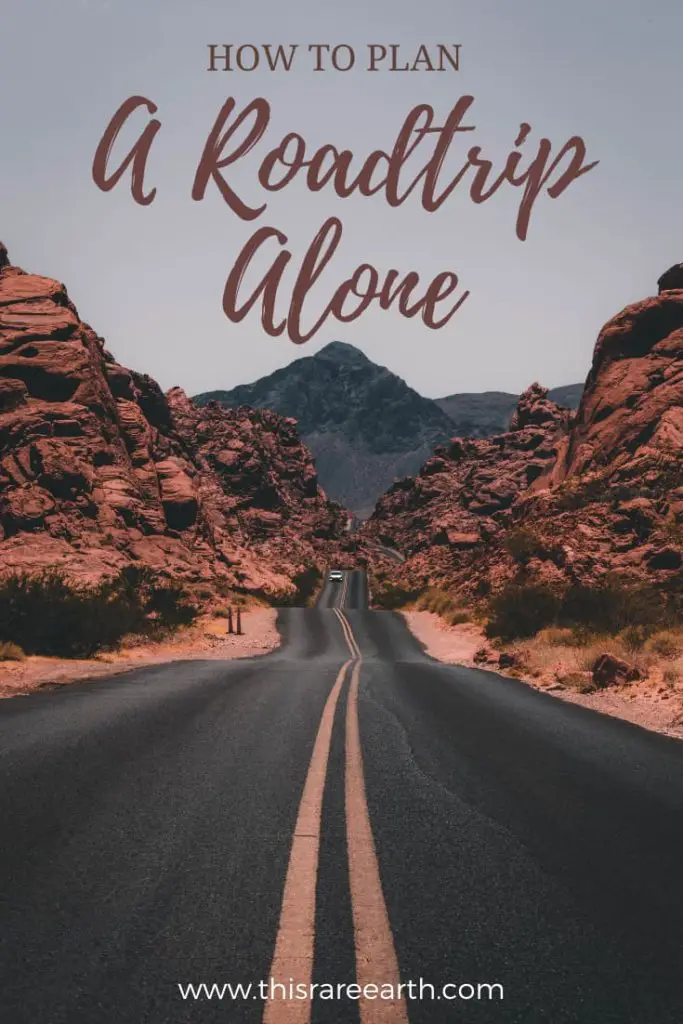
- Cabo San Lucas vs San Jose del Cabo Travel: Which Is Better?
- Cancun vs Cabo: Which is Better, Los Cabos or Cancun?
- 10 Tips for Visiting Joshua Tree National Park
- The Ultimate Guide to Visiting El Matador Beach, Malibu
- The Perfect Day Trip to Malibu: A One Day Itinerary [2024]
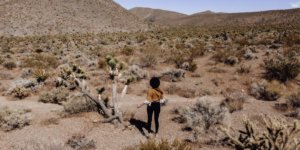
About Monica
Monica has been a solo female world traveler for over 15 years. She is an expert on outdoor adventures, solo female travel, and off the beaten path destinations. She is the founder of This Rare Earth and is a firm believer that the world is not as scary as the media might have you think! Learn more about her here . Connect with her on Instagram .
Reader Interactions
February 2, 2021 at 7:07 pm
Bravo Monica!
Happy Trails!
With love, Dana
February 3, 2021 at 8:39 am
Thank you so much Dana! I appreciate the support and love. Hope you are planning some amazing adventures this year!
Leave a Reply Cancel reply
Your email address will not be published. Required fields are marked *


for Solo Travel Over 50
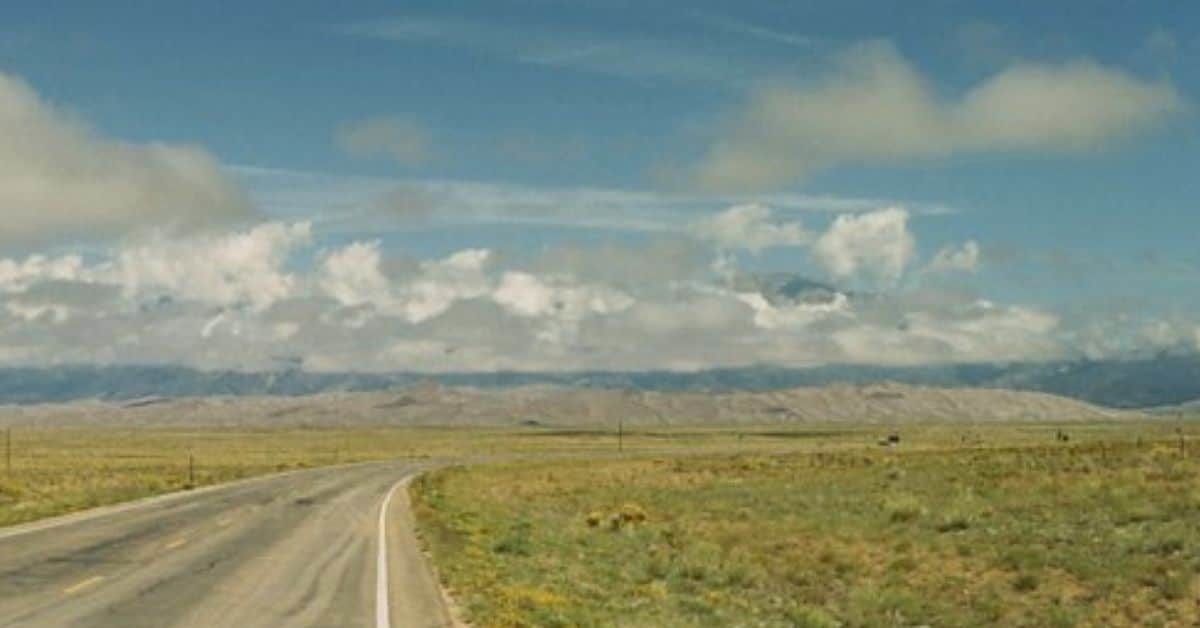
The Expert Tips for Planning a Solo Road Trip
Planning a trip by car cross country alone but have no clue where to start? Here are the expert tips for planning a solo road trip across the U.S. from the female solo traveler who’s driven about 40 thousand miles across America. No joke.
Like this? Share it with others!
This post may contain affiliate links for your convenience. For products, the goal is to first provide direct links to eco-friendly, ethical, and sustainable companies, and then to those same type (i.e., Climate Pledge Friendly Certification ), of brands that use Amazon, if possible. Therefore, you may see multiple links for one option. Should you make a purchase through any link, I will receive a small commission at no additional cost to you. See my Disclaimers & Disclosures and Privacy Policy for more information.
Is it Weird to Take a Road Trip Alone?
Where can i go for a solo road trip in the u.s., is it safe to drive cross country alone, how do you do a long road trip alone, planning for a solo road trip: my expert tips.
Not at all. I’ve done solo road trips for decades and clocked just about 40,000 miles across my country.
Road trips aren’t just for taking a vacation. There have been numerous reasons I have taken solo road trips across America, or just across a state. Mainly because I wanted, or needed, to see family or friends, go to concerts, get back and forth from college, or relocate permanently (I’ve lived in more than one city within eight states).

Anywhere. We don’t have check points between states so it’s easy to road trip by yourself.
I’ve been to 46 states, so using any of the above reasons to travel alone in the U.S. has also been a great opportunity to see and do new things, like visit national and state parks or go to an annual music festival or holiday celebration in a new city.
Being solo has never stopped me from road tripping in the U.S.
More USA Solo Travel Ideas
- 3 Days of the Best Hiking in Southwest Virginia
- Best of New York City in 4 Days
- Top San Francisco Sights in 1 Day On Foot
- How to Tour the Hoover Dam
- Amazing 4 Days in Maui Solo
- How to Spend a Long Weekend in Alaska Solo
- US States Travel Guides
Yes, just as long as you are smart about it.
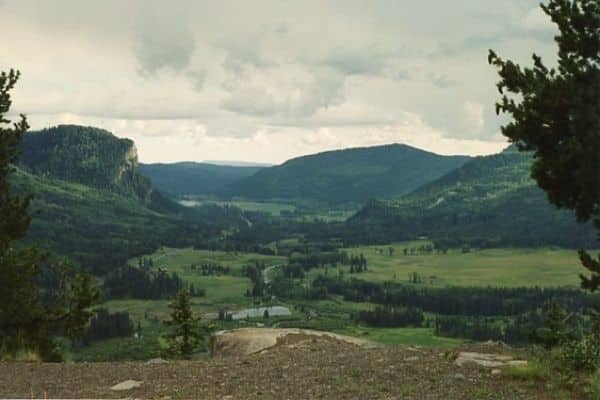
You do a long road trip alone successfully with very good planning. The more time you have to plan, the better.
If you don’t have much time to plan, focus on the items involving safety first, like planning your route and making sure your vehicle is up to snuff.
More Solo Travel Tips
- Top 10 Tips on How to Do a Solo Beach Trip
- How to Plan Your First Solo Trip: Step 1
How to Choose Your First Solo Trip Destination
- How to Create a Solo Travel Budget
- How To Save Money for Solo Travel
- How to Travel Carry-on Only
- 6 Tips on How to Avoid Airport Lines
Here are my tips to plan a long solo road trip (more than one day), but they can also apply to shorter road trips (less than a day).
These are tried and true tips I still use today. If you are a female or novice road tripper, this post is ideally for you. If you are not, these are still good solo road trip tips to know.
Picking Your Road Trip Destination
This post is not about giving you solo road trip ideas. You’ve done that. This post is here to help you in plan road tripping alone. If you still need assistance on a location explore how to choose your first solo trip destination .
Or, you can use some of my expert tips to work backwards to find a road trip destination.

Build a Solo Road Trip Itinerary
It’s important to do as much research in advance as possible for a long road trip. Safety is always your first consideration. Top things to consider in planning your route and itinerary are:
Stop Locations
Weather / time of year, accommodations.
Once you know where you want to go to, find overnight stopping points by knowing you’re not driving too much in one day. You want to stay fresh and alert for continual days of driving.
Within each driving day, calculate how many times you’ll need to stop for gas. If you want to make good time, it’s best to incorporate bathroom and eating breaks in your fueling breaks.
Always check your fluid levels, including oil, every time you stop for gas and never let your car get below a quarter of a tank.
If you’re feeling uber-cautious, document your mileage covered at each fueling stop so you know your car’s gas mileage is consistent. I do this when I’m driving really long distances.

Depending on time of year, it’s best to route your travel to avoid routes that will be more impacted by weather (i.e., avoiding extreme heat the South or summer and avoiding the extreme cold or snow in the North or winter).
I definitely plan my trips around the weather, not just for safety but also for enjoying activities and sites along the way.
Keep an eye on the weather report, in advance and while traveling, of your upcoming locations so you can mitigate being stuck in bad weather, or traffic, and cause problems for your vehicle.
Remember, time of year impacts how much daylight you have. It’s always safest to drive during the day. These days, on long solo road trips, I stick to driving only during day light. I didn’t always use to do this.
My record stretch of solo driving is 17 ½ hours from Boulder, Colorado to San Antonio, Texas. Straight. Only stopping for gas. Yah, I don’t do that anymore. I get up earlier if I know I have a particularly long day of driving.
Will you be driving across terrain you are unfamiliar with, like the desert or mountains? If so, it is a good idea to brush up on the rules of the road and tips for the area you’ll be in.
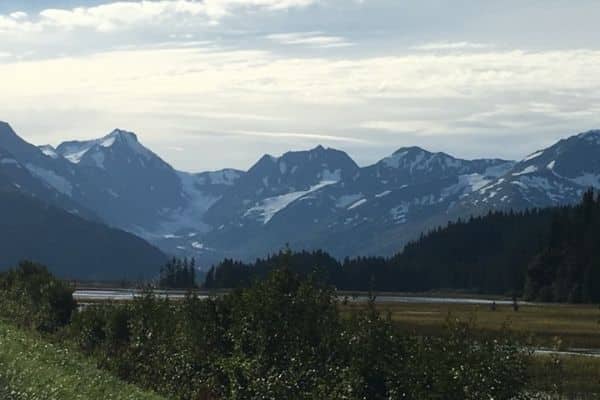
When mapping out your route, you could consider smaller highways than just traveling on the interstate. Interstates have the advantage of getting you to your destination quicker and usually provide many rest stops, gas stations, restaurants, and the like.
Smaller highways, however, provide more opportunity to see more of the countryside, quaint towns and off the beaten path attractions you may not initially consider.
The smaller the highway, however, the more of a chance you could be without any services close by. They also require longer the drive times – you could constantly be slowing down for town speed limits and lights – so, take that into consideration when planning your itinerary. Google is a great way to calculate this.
Make your hotel reservations as soon as you know your itinerary to get the best deals.
I personally would not bother with Airbnb to get to my final destination. I recommend getting a hotel reservation that includes late check-in and a free cancellation option just in case you have an emergency or decide to take do a diversion that delays your hotel arrival.
If you’re traveling with a pet, definitely make a reservation. Not all hotels or motels will allow a pet. Even if they take dogs, they may not take cats. You must specify your pet and get the confirmation in writing (email).
Before you book your accommodations, review the establishment’s images and do a Google street view to get a better understanding of the building and its surroundings. This will help you know if you need to request a room on a higher floor (which is always safer), or nearer the street, which is more important in an establishment in a sparsely populated area than in a city high-rise hotel.
If you’re unloading a lot from the car, you may want a room closest to the main door and your parking spot. Always try to park in a well-lit area of the hotel.
Remember how I said I only drive during the daylight on long road trips? That daylight time includes arriving to my hotel, checking in, unpacking the car, and eating dinner before it gets dark. As a female solo traveler, it’s just safer than doing all of that in the dark in a strange location.
Also, try to pick a room that’s quieter where you’ll be apt to get a good night’s sleep. Driving long distances can be tiring.
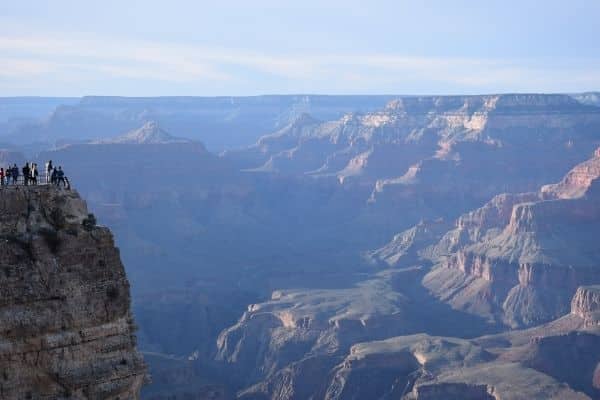
Share Your Itinerary
When your details are nailed down, share your full itinerary, with all contact information, with family and/or friends.
Make a plan on how you’ll contact them daily so they know you’re on schedule.
If traveling in the U.S. is a domestic trip, there is no need to copy your ID or anything for your family and friends.
If the U.S. is an international trip , provide your loved ones a copy of all of your travel documents and ID in case of emergency. Also see my USA Travel Guide if you’d like more travel tips.
Road Tripping with Pets
If you have a pet, pack all pet essentials as if you could not make a stop to buy more.
Consider planning your stops for them to take a pee break as well.
Budgeting for a Solo Road Trip
Budget for all hotel, gas/oil, food necessities, and attractions you’ll see along the way, if any.
Build in at least a 10% emergency fund , bring a back-up credit card, and ensure you have a card you can get cash from. You never know if you run into one of those places that don’t take credit cards.

Know Your Car Insurance Coverage
I’ve been with the same car insurance company ever since I bought my first car at the age of 20. I’m fully knowledgeable on what my policy provides and doesn’t.
Make sure you know your policy well. Have full 24-hour roadside assistance that includes long-distance towing. If you’re in the middle of nowhere, coverage for towing 100 miles is not going to help you if it takes 200 miles to get the closest mechanic.
If your car insurance does not cover such things, consider getting AAA for your solo trip.
Of course, have your car insurance policy and car registration in your car.
With the appropriate car insurance coverage, I’ve NEVER purchased travel insurance for a road trip in the U.S., no matter how long it is. Over the past 30 years, I’ve never needed it.
Using a Rental for Solo Road Tripping
It’s possible your vehicle is not long road trip worthy or you just don’t want to put the miles on your vehicle. In any case, you do have rental options that can take your long road trip to a whole new level.
Camper Vans, RV’s and Motor Homes
These are a great way to do more off the beaten path road tripping and enjoying state and national parks, especially if you don’t like sleeping in a tent.
I loved traveling in my VW bus that I could sleep in. It was very convenient.
If you do decide to rent one of these larger vehicles, ensure you get the full vehicle review with the rental professional so you know how to use it. You may want to also practice driving it a bit before your trip if you’re unfamiliar with such a large vehicle.
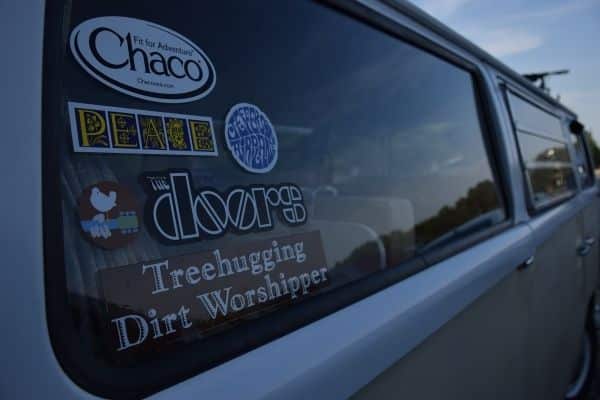
Regular Vehicle Rentals
No matter what type of vehicle you rent, check that your car insurance policy covers the vehicle no matter what your destination. This avoids unnecessary rental insurance through the rental company and saves you money.
If yours doesn’t, you’ll have to get rental insurance through the rental company.
Use a credit card that covers any damages to your rental. This saved me when someone hit my rental car. I didn’t have to pay a dime to get it fixed nor have a ding on my car insurance premium.
Get familiar with the vehicle before leaving the rental lot. Know how to pop the hood; how to operate the mirrors; know where the owner’s manual, spare tire and jack are; and, know where all of the basic fluids go.
Can you get satellite radio and online roadside assistance? Great. Get them. These options can make or break a long solo road trip.
Last, don’t forget the full inside and outside check of any rental with the rental agent, and get a signed copy of the inspection before you drive away.

Preparing Your Vehicle for Your Solo Road Trip
Get your vehicle inspected.
If you haven’t had your oil changed or car serviced in a few thousand miles, do it before you go to be better safe than sorry.
At minimum, I always get my tire tread and pressure, fluids, windshield wipers, and lights checked.
Prepare Your Roadside Emergency Kit
I keep the following car kit items in the back of my car, which I also recommend for your long road trip.
Solo Road Trip Packing Essentials
If you already have these items in your car, go through them to make sure nothing’s too old or inoperable.
If you don’t already know, get your mechanic to help you identify where all fluids go, how to check your tire air pressure, and, by all means, how to change your own tire.
In-the-Car Essentials
With your travel gear and roadside emergency kit safely tucked away in the trunk (or in the back covered by your luggage visor), keep only the essentials in the vehicle cabin with you on your road trip.
When I set off, I only have my day bag, phone, phone charger, packed cooler, pocket knife, water bottle, coffee mug, reusable utensil set, maps, itinerary, and entertainment in the cabin.
Road tripping with out-of-state plates and a lot of belongings in view inside the car screams, “Hi, I’m not from here!”, and can invite quick grab-and-go break-ins, which can be a huge bummer.
Also, always bring your purse/day bag and other non-replaceable essentials with you when you stop at a restaurant, gas station, rest stop, national park, or other attraction. It doesn’t matter if it’s well populated or not.
Navigating Solo
For navigation, I will use GPS on my phone periodically, but I find it’s best to write down (or take screenshots of) the main travel roads and directions before I take off to have as a back-up in case I don’t have cell phone/GPS service.
Always pull off the road if you’re fishing for directions. Best not to do that at high speeds road tripping solo.
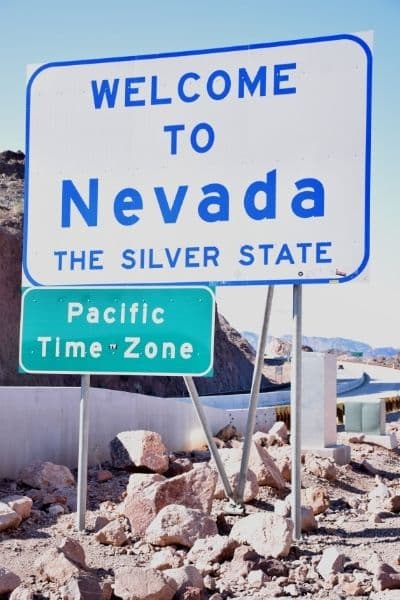
Solo Road Trip Entertainment
One time driving from Washington, DC to Colorado with a roommate, we had a Cosmopolitan magazine that got us through three states. Alas, when you’re solo, you don’t have anyone to read you good articles or love quizzes.
Like directions, having your road tripping entertainment picked out and handy is a must before driving alone long distances.
Whether you choose the radio or satellite radio, CD’s, a play list on your mobile device, or an audio book, just have it ready. Again, it’s possible to lose cell service in isolated areas so have a back-up so you’re not digging around for entertainment while driving.
Know the Driving Rules and Etiquette
I’m not going to preach here but simply point out some key driving issues I have seen, and still see, when road tripping. This is for your safety. If you already know this, just ignore it.

Be Prepared
The last thing you want to do is be involved in an automobile accident simply because you didn’t know the road rules or weather conditions of any terrain you’re unfamiliar with. If you have to, peruse a DMV handbook before your solo road trip.
Be Alert at High Speeds
Use your mirrors at all times. Don’t just always look ahead – always be looking around you. You never know when that crazy person appears out of nowhere driving 100 miles an hour and weaving in and out of lanes to pass slower traffic.
“Slower Traffic Keep Right”
Contrary to popular belief, they do not make these signs because they’re pretty. They make them for a reason. Especially when going up steep inclines.
Nothing can cause an accident more than by people driving slower than the flow of traffic in the left hand (i.e., passing) lane causing others to have to pass them in the righthand lane (where the on and off ramps are).
Driving slowly in the left lane also causes traffic congestion, which can increase risk of accidents. For the love of all that’s holy, if you must drive slower than others, do it in the righthand lane.
Emergency Stops
Always try to stop in a public, well-lit area for safety. If you are being pulled over by a cop, here are some good safety tips for solo female drivers to know .
If you can’t wait for a rest area or highway exit, pull off as far to the right of the road as possible, even if it’s in the grass. You do not want your vehicle to be near that white line.

Do I Pick Up a Stranger?
Let’s talk hitchhikers and emergency assistance. My advice on this will always be do not pick up a hitchhiker for safety reasons pure and simple.
Driving alone, I would also advise not pulling over for road side assistance. Now that we have cell phones, make note of the nearest mile marker and call to 911 so a professional can provide them assistance.
That’s it. Now that you have my expert tips on how to plan for a solo road trip, you should be set to hit the open road. Happy trails.
Let Me Hear From You
I would love to hear if my expert tips for planning a solo roadtrip were helpful to you. Post me your thoughts or questions in the Comments section below. Thank you!
More Travel Tips You’ll Like
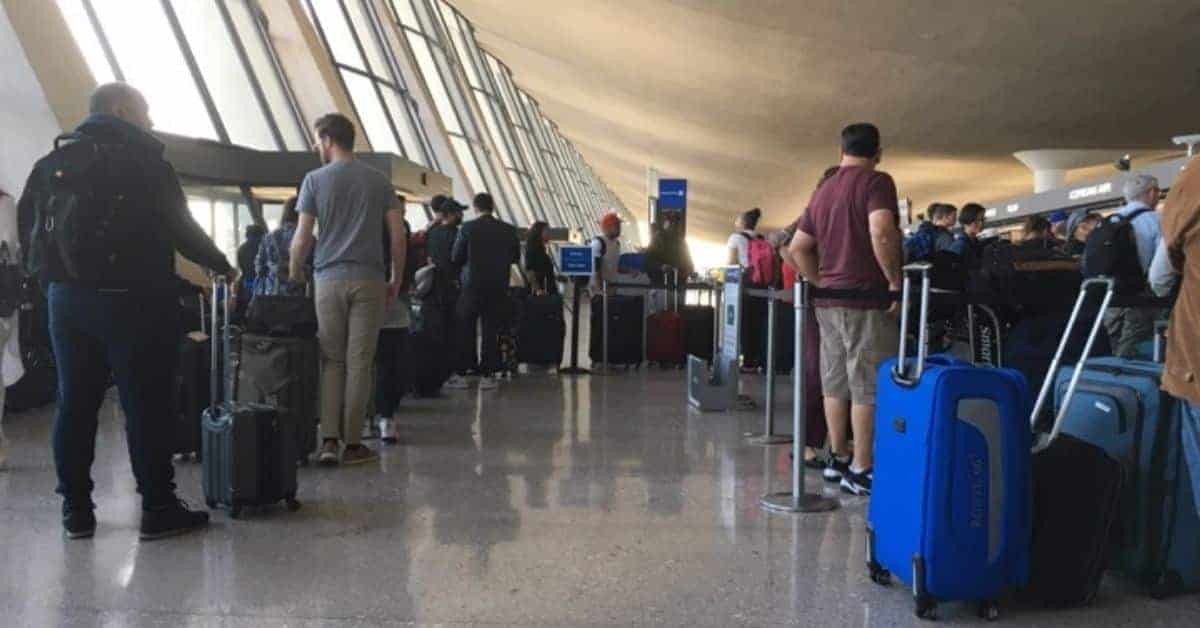
6 Tips to Save Time in Airport Lines
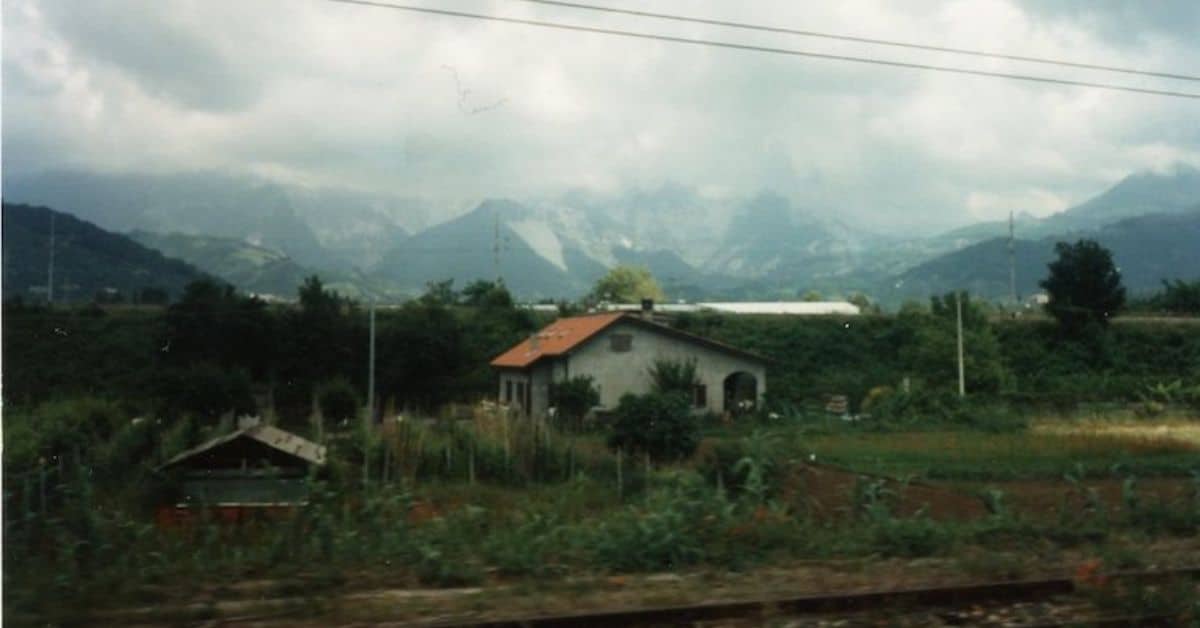
Why Learn a Language for Travel: One Travel Story

Solo Travel During Covid-19: 15 Planning Tips To Know

10 First Time International Travel Tips to Know (2023)

2 Tips to Improve International Solo Travel

Day Trip from Paris to Versailles Tips and Tricks

The Step Not to Miss to Plan Your First Solo Trip
Leave a comment cancel reply.
Your email address will not be published. Required fields are marked *
Save my name, email, and website in this browser for the next time I comment.

10 Best Solo Road Trip Ideas and tips for traveling solo

Are you looking for solo road trip ideas? You’ve come to the right place. Traveling solo can be the ultimate quest for freedom and self-discovery. Our curated list of solo road trip ideas steers you through the USA’s most spectacular drives and hidden gems. From serene coastal escapes to awe-inspiring national parks, you’ll gain invaluable tips to navigate these adventures confidently. Whether it’s your tenth or first solo trip , solo road-tripping is an experience you won’t forget.
Key Takeaways
- The USA is a diverse, breathtaking road trip destination perfect for solo travelers. Stunning road trip destinations like the Pacific Coast Highway, Grand Canyon National Park, Death Valley National Park, Blue Ridge Parkway, Yellowstone National Park, and Utah’s Mighty 5 National Parks.
- Essential preparation for road trips includes vehicle maintenance, planning, packing, rental cars, staying connected for safety, and budgeting for all trip-related expenses for a hassle-free experience.
- Embracing flexibility and spontaneity on solo road trips leads to great experiences and unexpected discoveries.
Top 10 Best Solo Road Trip Ideas in the USA
There is something liberating about a solo road trip. It’s just you, your vehicle, and the open road, with the freedom to explore at your own pace. There are no compromises or schedules, only possibilities. With its diverse landscapes and iconic highways, the USA offers many destinations perfect for solo road trips.
From the scenic Pacific Coast Highway in California to the historic Route 66, these journeys offer more than just a drive. They are experiences that captivate the senses, with stunning vistas, quirky roadside attractions, and the thrill of discovering new places. We’ll now explore these incredible destinations and what sets each one apart.
Pacific Coast Highway, California
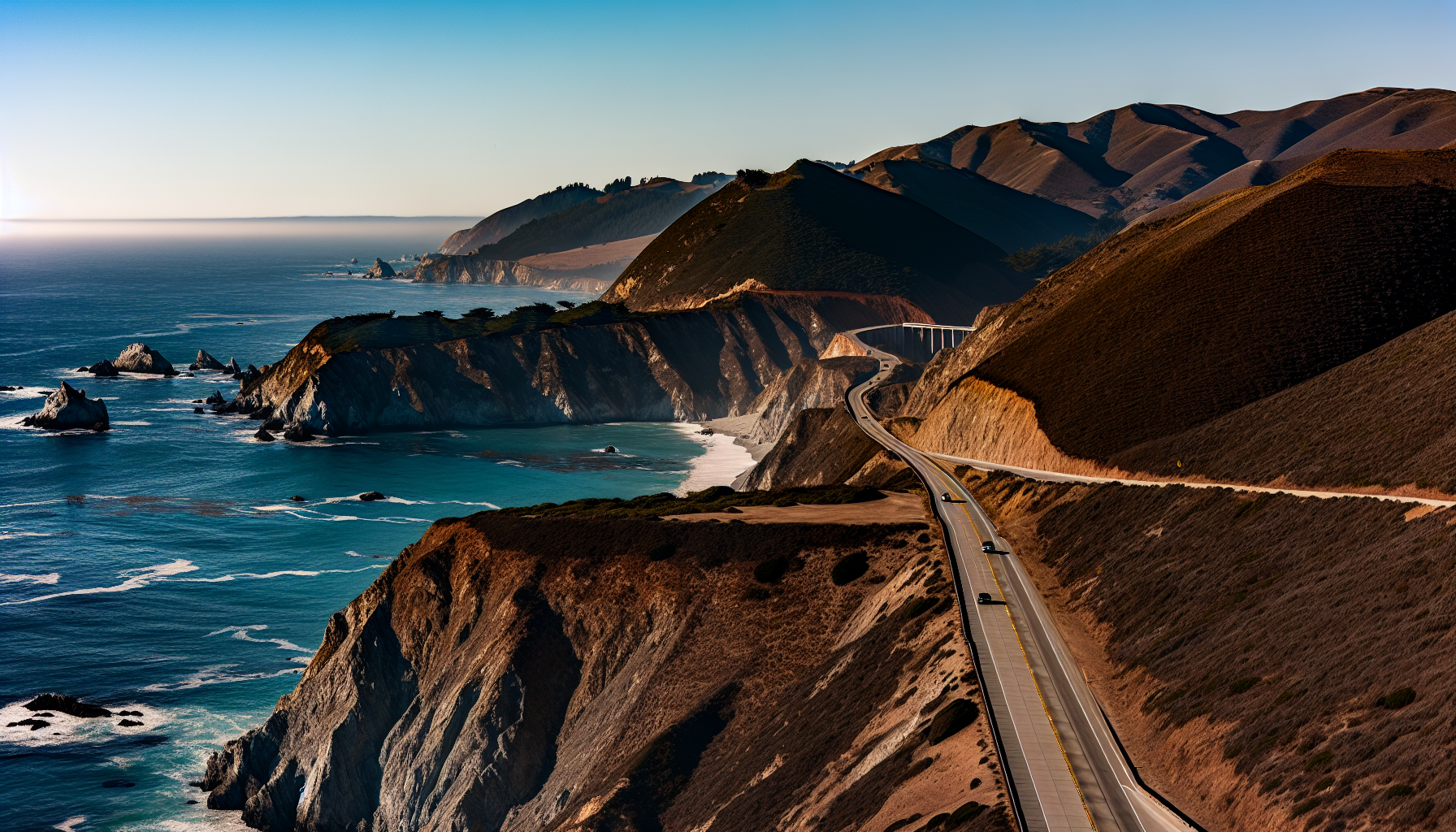
The Pacific Coast Highway, stretching along California’s coastline, is more than just a road. It is a journey through breathtaking coastal views and charming towns. As you navigate the twists and turns of this iconic highway, the Pacific Ocean serves as your constant companion.
From the bohemian spirit of Santa Cruz to the rugged beauty of Big Sur, the Pacific Coast Highway is a treasure experience. As you venture south, each town reveals its unique character, offering a glimpse into California’s vibrant landscape. On this solo trip, you can experience the beachside charm of Santa Barbara and the picturesque vistas of Mendocino. There’s always something to discover on this amazing solo road trip.
Blue Ridge Parkway, Virginia & North Carolina
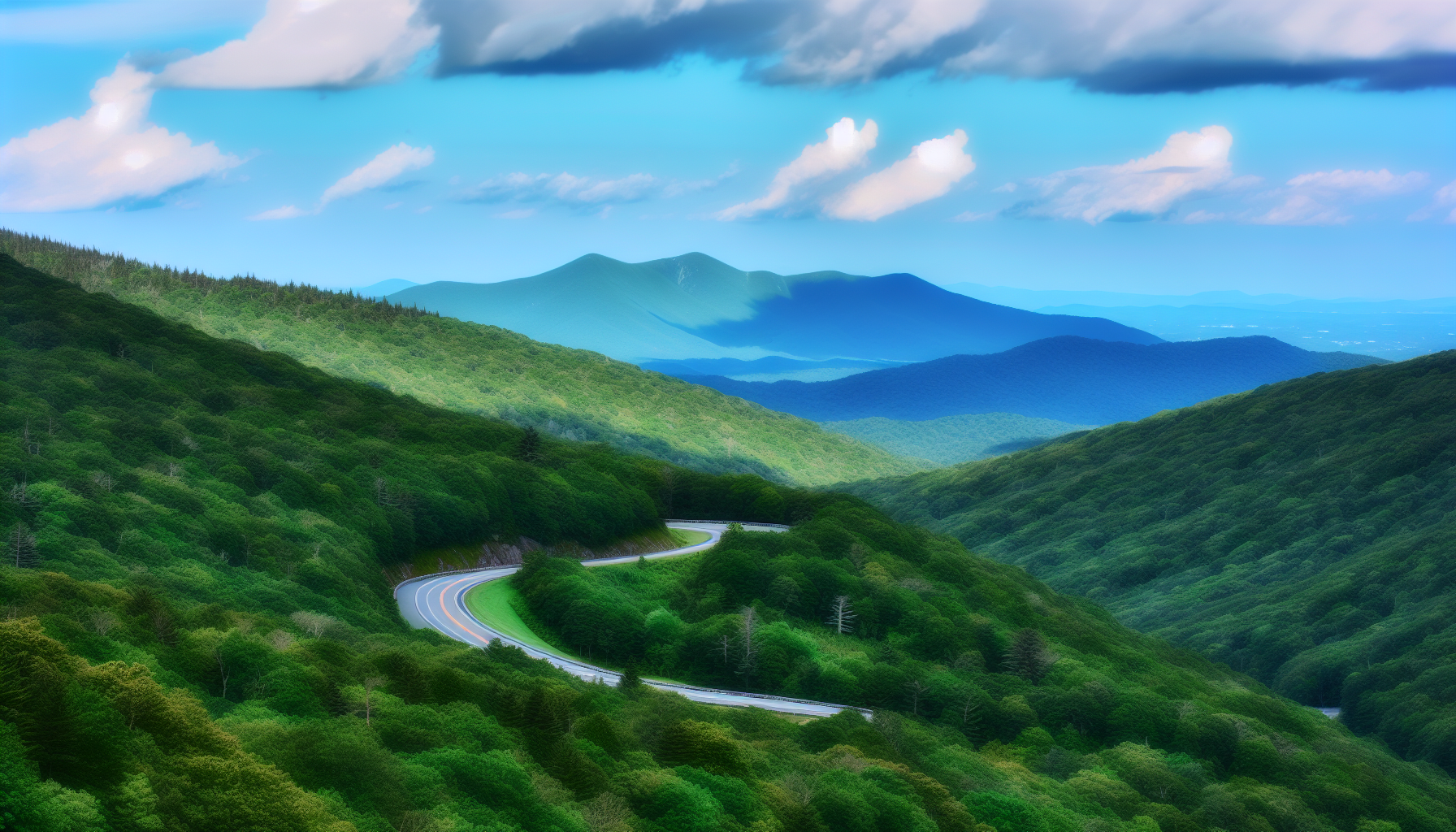
The Blue Ridge Parkway, spanning Virginia and North Carolina, is a journey through picturesque landscapes. Known as “America’s Favorite Drive,” this scenic route offers stunning overlooks, hiking trails, and charming mountain towns that captivate with their rustic charm. It’s a feast for the senses, with each turn revealing a new scene of natural beauty.
This is a great solo or day trip just for the breathtaking views. Enjoy the Humpback Gap Overlook or the historic charm of towns like Linville Falls and Blowing Rock. The Blue Ridge Parkway is a road trip destination that never ceases to amaze. Prepare for solo road-tripping overflowing with stunning landscapes and unforgettable moments.
Utah’s Mighty 5 National Parks

Utah’s Mighty 5 National Parks offer the state’s diverse and stunning landscapes. Rivaling the Grand Canyon National Park’s beauty. The parks include:
- Arches National Park, known for its towering sandstone arches
- Bryce Canyon, with its high-elevation hoodoo formations
- Canyonlands National Park, featuring dramatic canyons and mesas
- Capitol Reef National Park is home to colorful sandstone cliffs and domes
- Zion National Park, famous for its towering red cliffs and narrow slot canyons
Each park offers a unique and enriching experience that makes for one of the best solo road trips.
The best times to visit are spring and fall, when the weather is milder, and the scenery changes with the seasons. By dedicating more time to your journey, you can fully immerse yourself in each park’s unique landscapes and experiences, turning your road trip into an unforgettable adventure.
The Florida Keys Overseas Highway
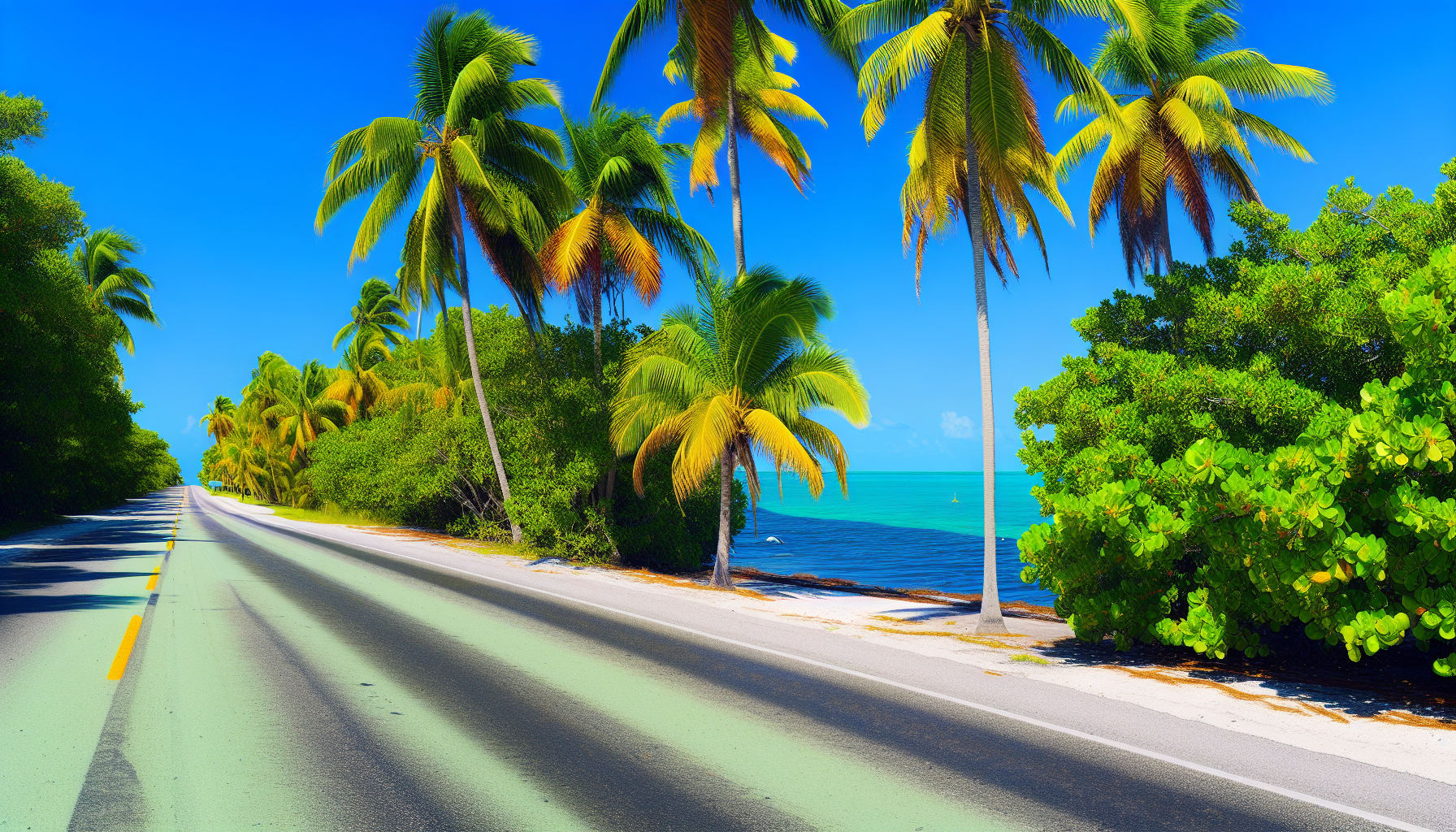
The Florida Keys Overseas Highway is a unique road trip experience that offers:
- Stunning ocean views
- Island-hopping opportunities
- Countless bridges
- Breathtaking oceanic vistas
Stretching 113 miles from Miami to Key West, this highway takes you on a thrilling journey. While the drive is an adventure, the various islands along the route offer multiple attractions. Some highlights include:
- The underwater wonders of the John Pennekamp Coral Reef State Park
- The colorful and quirky culture of Key West
- The opportunity to spot a variety of wildlife, including manatees, Key deer, and herons
There’s no shortage of experiences to enjoy on this road trip.
New England Fall Foliage Tour
There’s nothing quite like New England’s vibrant display of fall foliage. As summer fades, the region becomes a canvas of fiery reds, radiant oranges, and golden yellows. This natural spectacle provides the perfect backdrop for a solo road trip, offering breathtaking scenery at every turn.
The first week of October is usually the best time to witness this stunning display. As you drive through the picturesque landscapes, visit quaint villages like Stowe, Vermont, and North Conway, New Hampshire. Don’t miss the chance to explore the area’s picturesque covered bridges, adding a touch of charm to your fall foliage tour.
Great River Road, Mississippi River
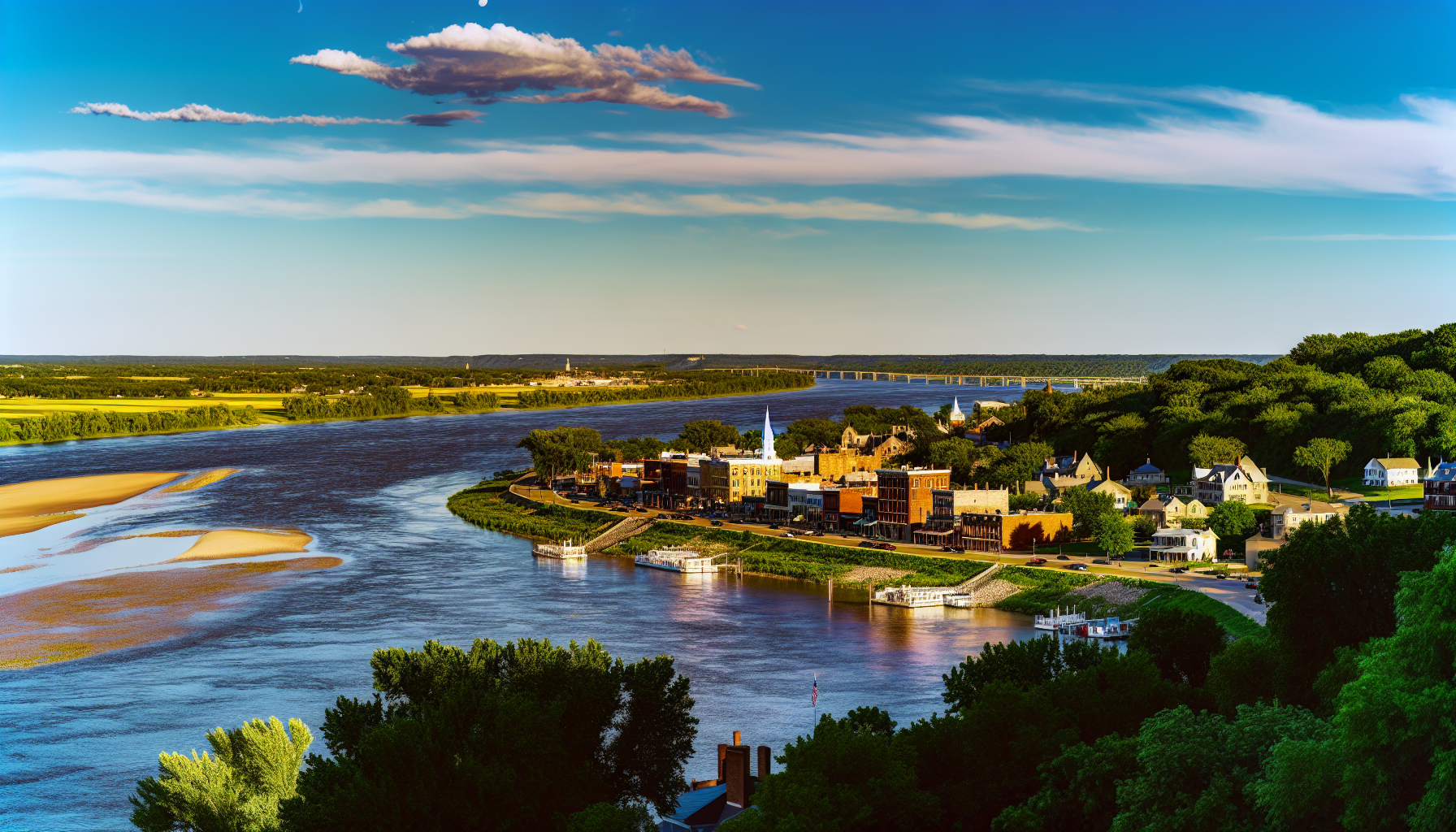
Following the Great River Road along the Mississippi River is like traveling through time. This iconic highway presents diverse landscapes, historic sites, and regional cuisine. This road trip offers a unique perspective of America’s heartland. It is a journey through the country’s cultural heritage, from the bustling cities to the tranquil farmlands.
Enjoy activities like sampling regional cuisine or exploring historic sites. And with the best time to visit is in September or during the fall season; you can also enjoy the stunning fall foliage along the river, adding another layer to this unforgettable road trip.
Southwest Desert Adventure
Venturing into the Southwest Desert offers an adventure like no other. This road trip is a journey of discovery, taking you to:
- The awe-inspiring landscapes of Arches National Park
- The unique art installations of Marfa
- The iconic landmarks of the region
- The rich history and natural beauty of the Southwest Desert
Get ready to explore rocky mountains and be amazed by this rugged landscape.
The best time to enjoy Southwest Desert Adventure is fall and spring when the weather is milder. With the freedom to make decisions on the spot, solo travelers can fully enjoy themselves in the desert’s unique landscapes, leading to surprising findings and personal growth.
Oregon Highlights
Oregon’s diverse landscapes offer a feast for the senses, including:
- The picturesque Pacific Coast
- The stunning Crater Lake National Park
- The rugged trails of the Columbia River Gorge
- The charming coastal towns
This Pacific Northwest state is a paradise for nature lovers, offering breathtaking vistas and many outdoor activities. Whether hiking or exploring Oregon, it promises an unforgettable solo road trip.
The best time to visit is during summer when the weather is perfect for outdoor adventures. Oregon offers stunning landscapes and diverse attractions. And Oregon offers a road trip experience is exhilarating.
Route 66: The Mother Road
Route 66, often called the “Mother Road,” is an iconic highway that once connected Chicago to Los Angeles. Traveling along this historic route is like stepping back, offering a glimpse into America’s past. See quirky roadside attractions and stunning landscapes. Route 66 uniquely blends history and adventure.
The best times to embark on a Route 66 road trip are during the months of:
These months offer ideal weather conditions and smaller crowds, making it the perfect time to explore this iconic highway. Whether you’re a history buff or a wanderlust-filled adventurer, Route 66 offers a road trip experience like no other.
Idaho’s Scenic Byways
Idaho’s Scenic Byways offer a peaceful and nature-filled journey through picturesque landscapes. Explore hot springs and charming small towns. Soak up soaking in the warmth of a natural hot spring or exploring a lovely small village. The byways offer a tranquil escape from the hustle and bustle of everyday life.
The byways are a year-round wonder, with December eagle watching to stunning fall foliage and unique rustic solitude from mid-April to October. Prepare for exploring Idaho’s Scenic Byways’ natural beauty on your upcoming solo road trip.
Essential Solo Road Trip Tips
Going on your first solo road trip, or simply a solo trip, is an adventure filled with freedom and self-discovery. Traveling solo teaches you to enjoy your own company. Safety is also essential for a solo traveler. Specific considerations are vital to ensure a safe, enjoyable, and memorable journey. These essential tips, from planning and preparation to vehicle safety and staying connected, will prepare you for what lies ahead.
In the following subsections, we’ll discuss each aspect of preparing for your solo road trip. Here’s what we’ll cover:
- Vehicle safety and maintenance
- Staying connected and safe
- Entertainment and comfort
- Budgeting and accommodations
- Embracing flexibility and spontaneity
Planning and Preparation
Proper planning for a road trip can be all the difference between an incredible journey and an anxiety-ridden ordeal. From researching your route and attractions to packing the right gear, planning and preparation are critical to a smooth road trip.
Consider using Google Maps or a GPS device to plan your route. Also, research the driving distances and the location of the next gas station. Consider your accommodation options and book in advance to secure the best deals.
Don’t forget to pack essential gear like a first aid kit, a spare tire, and a road map – these resources can come in handy in unexpected situations.
Vehicle Safety and Maintenance
Your vehicle is your primary mode of transportation on a road trip, and ensuring its safety and maintenance is paramount. Maintaining your vehicle, which includes checking fluid levels and tire conditions, can greatly improve your road trip experience.
Before setting off on your road trip, make sure to:
- Schedule a tune-up and inspection for your car to address any necessary repairs
- Pack an emergency kit, including a first aid kit, flashlight, spare tire, and jumper cables
- Consider investing in a roadside assistance plan for added peace of mind during your journey
Staying Connected and Safe
Maintaining connection during your solo road trip serves dual functions- keeping you in touch with your loved ones and ensuring your safety. In today’s digital age, staying connected is easier than ever, even on the road.
Share your itinerary with a trusted person and update them on your whereabouts. Use technology to your advantage by using GPS for navigation, keeping your devices charged, and using safety apps. Remember, staying connected is more than just social media updates – it’s about ensuring your safety and peace of mind during your solo journey.
Entertainment and Comfort
Though long drives can sometimes become monotonous, the right entertainment can transform them into pleasurable experiences. From music playlists to audiobooks, engaging entertainment can make the miles fly by.
Another fundamental aspect of a road trip is comfort. Here are some tips to ensure maximum comfort:
- Adjust your seat for maximum comfort
- Wear comfortable clothing
- Bring pillows and blankets for added comfort
- Take breaks to stretch and relax
- Play relaxing music or podcasts to create a calming atmosphere
Remember, comfort on a road trip isn’t just about physical comfort – it’s also about ensuring you’re mentally comfortable and relaxed throughout your journey.
Budgeting and Accommodations
Early budget planning can help preclude unwanted financial surprises during your trip. Consider all potential costs, including:
- accommodations
This will help you manage your expenses and ensure a stress-free journey.
Regarding accommodations, there are numerous options to fit every budget. Some options include:
- Airbnb rentals
Choose accommodations that fit your budget and provide the comfort and amenities you want.
Embracing Flexibility and Spontaneity
The freedom to be spontaneous and flexible is one of the significant joys of a solo road trip. While planning is important, allowing room for spontaneity can lead to:
- unexpected discoveries
- unique experiences
- meeting new people
- exploring off-the-beaten-path destinations
This can significantly enrich your road trip experience. Don’t be afraid to take an unplanned detour or spend an extra day in a town you’ve fallen in love with. Embrace the unexpected and remember you’re in control on a solo road trip. So, let your curiosity guide you and embrace the adventure that awaits on the open road.
Embarking on a solo road trip is a journey of self-discovery and freedom. From the stunning Pacific Coast Highway to the historic Route 66, each destination offers a unique experience that promises to leave you with lifelong memories. With the proper planning, safety measures, and an open mind, your solo road trip can be an unforgettable adventure. So, pack your bags, fuel up, and hit the open road – because the journey is just as exciting as the destination.
Frequently Asked Questions
What can you do on a road trip by yourself.
You can make the most of your first solo road trip by being selfish and doing a few things you enjoy, such as listening to audiobooks, writing, composing music, and having deep conversations with yourself. Let the journey be an opportunity for self-discovery and enjoyment.
Is it a good idea to go on a solo road trip?
A solo road trip can be a thrilling and empowering adventure that tests your independence and self-reliance. It’s a great way to challenge yourself and experience freedom.
What traveling alone is a great idea?
Traveling alone is an excellent idea because it allows you to plan your trip exactly as you want and discover a piece of yourself with each new adventure. Your extensive experience is waiting for you – take the next step!
What is the best part of traveling alone?
The best part of traveling alone is getting to know yourself better. You’ll discover your preferences and what truly brings you joy when you can make your own decisions. Enjoy your next solo travel adventures!
How can I ensure my vehicle is ready for my solo road trip?
Make sure to conduct essential vehicle maintenance checks like fluid levels and tire pressure, and also be realistic about your driving limits and schedule for a safe solo road trip adventure. Good luck!

Grace Ashi is the founder and Editor of Metropolitan Girl.
18 best restaurants in Arlington, VA, you need to try 2024
75+ must have best travel essentials for women in 2024, related articles, how to plan a european trip: step-by-step guide..., 30 best cities to visit in the usa..., best things to do in arlington, va, from..., georgetown dc travel guide: things to do, dining,..., 75+ must have best travel essentials for women..., 19 cheapest european countries to visit 2024, 13 best travel safety apps for secure and..., 41 best places to visit in the usa..., arlington, virginia travel guide by a local, which washington dc airports should you fly into....
Winter is here! Check out the winter wonderlands at these 5 amazing winter destinations in Montana
- Travel Guide
How To Plan A Solo Road Trip
Published: December 4, 2023
Modified: December 28, 2023
by Gerhardine Moy
- Plan Your Trip
- Travel Tips
Introduction
Are you ready for an adventure of a lifetime? Planning a solo road trip is an exhilarating experience that allows you to embrace freedom, explore new destinations, and create unforgettable memories. Whether you’re a seasoned traveler or new to the road trip scene, this comprehensive guide will provide you with all the essential steps to plan an epic solo road trip.
Embarking on a solo road trip offers a sense of independence and the opportunity to discover hidden gems off the beaten path. It allows you to set your own schedule, explore at your own pace, and immerse yourself in the beauty of the open road.
Before you hit the road, it’s important to plan ahead and consider various factors such as your destination, route, accommodations, safety, and entertainment. By following these steps, you’ll be well-prepared to embark on an adventure that will ignite your wanderlust and leave you with memories to last a lifetime.
So, buckle up and get ready to embark on a solo road trip like no other. From choosing your destination to staying connected on the road, this guide will provide you with all the tips and tricks you need to make your journey a success. Let’s dive in and start planning your ultimate solo road trip adventure!
Step 1: Choose Your Destination
The first step in planning a solo road trip is to decide on your destination. Consider what kind of experience you want to have and what landmarks or attractions you want to visit along the way.
Are you dreaming of driving along the rugged coastline of California? Or perhaps you’ve always wanted to explore the breathtaking national parks in Utah. Whatever your preference may be, choose a destination that aligns with your interests and provides ample opportunities for adventure.
Do some research and make a list of potential destinations that pique your curiosity. Consider factors such as distance, weather, and the time of year you plan to embark on your road trip. Keep in mind any specific activities or sights you want to see, whether it’s hiking, wildlife spotting, or simply enjoying stunning scenery.
Remember, a solo road trip is your chance to explore a destination at your own pace and on your own terms. Don’t be afraid to think outside the box and choose a lesser-known location that may surprise you with its beauty and charm.
Once you’ve decided on a destination, consider creating a rough itinerary that outlines the route you’ll take and the key places you’ll visit along the way. This will help you stay organized and ensure you don’t miss any must-see attractions or experiences.
Choosing the perfect destination is the first exciting step in planning your solo road trip adventure. Take your time, do your research, and let your wanderlust guide you to a destination that will make your heart sing.
Step 2: Plan Your Route
Now that you’ve chosen your destination, it’s time to plan the route for your solo road trip. Planning your route in advance will help ensure a smooth and enjoyable journey.
Begin by mapping out the most efficient and scenic route to your destination. Consider using a GPS or navigation app to help you navigate unfamiliar roads and avoid traffic. Take into account the duration of your trip and factor in breaks for rest, meals, and sightseeing.
As you plan your route, don’t be afraid to take detours and explore off-the-beaten-path destinations along the way. This is your opportunity to discover hidden gems and make unexpected discoveries. Research attractions, landmarks, and scenic drives that are in close proximity to your planned route and add them to your itinerary.
Additionally, consider the time of year you’ll be traveling and any seasonal road closures or weather conditions that may affect your route. Stay up-to-date with local information and road conditions to ensure a safe and hassle-free journey.
It’s also a good idea to have some flexibility in your route planning. Leave room for spontaneous stops or changes in itinerary based on recommendations from locals or fellow travelers. Embrace the unknown and be open to unexpected adventures that come your way.
Lastly, think about breaking up long stretches of driving by planning overnight stays at interesting locations. This will not only give you a chance to rest and rejuvenate, but also to explore new places and immerse yourself in local culture.
Planning your route is an essential step in ensuring a successful solo road trip. Take the time to research, map out your journey, and allow for flexibility along the way. With a well-planned route, you’ll be ready to hit the road and embark on an unforgettable adventure.
Step 3: Research Accommodation Options
When planning your solo road trip, it’s important to research and consider various accommodation options along your route. Where you choose to rest your head at night can greatly impact your overall experience.
One popular and budget-friendly option for solo road trippers is camping. If you enjoy being one with nature and have the necessary camping gear, consider staying at campgrounds along your journey. Research and book campsites in advance to secure your spot, especially during peak travel seasons. Camping allows you to immerse yourself in the great outdoors and enjoy beautiful scenery at minimal cost.
If camping isn’t your cup of tea, there are plenty of other accommodation options to consider. Hotels and motels offer convenience, comfort, and extra amenities such as Wi-Fi and swimming pools. Look for accommodations that offer free cancellation in case your plans change or you decide to stay longer at a particular destination.
Another popular choice for road trippers is renting vacation homes or cabins. These options provide a more homey and private experience, and are especially great for longer stays or if you prefer a kitchen to prepare your own meals.
For a unique and social experience, consider staying in hostels. Hostels are budget-friendly, offer shared rooms or private rooms, and are a great way to meet fellow travelers along your journey. They often have communal kitchens and common areas where you can connect and share stories with other road trippers.
As you research accommodation options, make sure to read reviews, compare prices, and consider the location’s proximity to your planned activities. It’s also a good idea to book accommodations in advance, especially during peak travel seasons, to secure the best deals and ensure availability.
Remember, your choice of accommodation can greatly enhance your road trip experience. Choose an option that suits your preferences, budget, and desired level of comfort. Whether it’s camping under the stars or enjoying the luxury of a hotel room, make sure you have a comfortable and enjoyable place to rest after a day of adventure on the road.
Step 4: Prepare Your Vehicle
Before you hit the road on your solo adventure, it’s vital to prepare your vehicle for the journey ahead. Proper vehicle maintenance and preparation ensure a safe and stress-free road trip experience.
Start by scheduling a thorough maintenance check-up for your vehicle. Take it to a trusted mechanic who can inspect the tires, brakes, fluids, and overall mechanical condition. Make sure everything is in good working order and address any necessary repairs or replacements.
Check your tire pressure and inspect the tire tread to ensure they are in optimal condition. Properly inflated tires not only improve fuel efficiency but also provide better traction and handling on the road. Don’t forget to pack a spare tire and the necessary tools to change it, just in case.
Next, ensure your vehicle is equipped with essential safety features such as a functioning seatbelt, airbags, and a working horn. Double-check that all exterior lights, including headlights, taillights, and turn signals, are in proper working condition.
As you prepare your vehicle, consider investing in a GPS or navigation system to assist with directions. This will help minimize the chances of getting lost and eliminate unnecessary stress during your road trip. Additionally, make sure you have a reliable phone charger and a portable power bank to keep your devices powered up on the go.
It’s also important to have the necessary documentation and emergency supplies in your vehicle. Make sure you have your driver’s license, vehicle registration, and proof of insurance readily available. Pack an emergency roadside kit that includes items such as a first aid kit, flashlight, jumper cables, and a reflective warning triangle.
Lastly, declutter your vehicle and create a comfortable space for your road trip. Remove any unnecessary items that may impede your visibility or take up valuable space. Organize your belongings in a way that allows easy access to essential items while on the road.
By properly preparing your vehicle ahead of time, you can embark on your solo road trip with peace of mind, knowing that you’ve taken the necessary steps to ensure your safety and the reliability of your vehicle.
Step 5: Pack Essentials
Packing the right essentials is crucial for a successful solo road trip. Here are some key items to consider when preparing for your adventure:
1. Clothing: Pack a mix of comfortable and weather-appropriate clothing. Consider layering options, as temperatures can vary throughout your journey. Don’t forget essentials like underwear, socks, and a swimsuit.
2. Toiletries: Bring a toiletry kit with essentials like toothbrush, toothpaste, soap, shampoo, and any other personal care items you may need. It’s also wise to pack a first aid kit with basic supplies like bandages, pain relievers, and any necessary prescription medications.
3. Food and Water: Stock up on non-perishable snacks and water bottles to keep you fueled on the road. Consider packing a cooler with perishable items for longer journeys. Remember to stay hydrated and avoid excessive caffeine or sugary drinks.
4. Entertainment: Pack items to keep yourself entertained during the trip. Bring a good book, download podcasts or audiobooks, and make a road trip playlist with your favorite tunes. Don’t forget chargers for your electronic devices.
5. Navigation Tools: While GPS or smartphone navigation apps are handy, it’s always wise to have a physical map as a backup. This can come in handy if you venture into areas with limited signal or encounter technical difficulties.
6. Comfort Items: Make your road trip more comfortable by packing items like sunglasses, a cozy blanket, a travel pillow, and a portable fan or heater depending on the weather. These small comforts can make a big difference during long drives.
7. Emergency Supplies: Prepare for potential emergencies by packing items like a flashlight, roadside flares, a spare tire, and a basic toolkit. It’s also advisable to have a roadside assistance contact number saved in your phone.
8. Miscellaneous Items: Don’t forget other essentials such as cash, a reusable water bottle, a camera to capture your memories, and a trash bag to keep your vehicle tidy. It’s also wise to have a spare set of car keys stored separately from your main set.
Remember, packing efficiently and only bringing essential items will help ensure you have enough space in your vehicle for a comfortable journey. Be mindful of weight limits and distribute items evenly for optimal safety and stability.
By packing these essentials, you’ll be well-prepared to tackle any adventure that comes your way during your solo road trip.
Step 6: Create a Budget
Creating a budget is an important step in planning a solo road trip. It helps you estimate and manage your expenses to ensure a smooth and financially responsible journey. Here are some tips to help you create a budget for your road trip:
1. Determine your total trip budget: Start by deciding on the total amount of money you are willing to spend on your road trip. This will serve as a guide for planning other aspects of your trip, such as accommodation, food, and activities.
2. Calculate fixed expenses: Consider the fixed expenses that you need to account for, such as gas, accommodations, and any pre-booked activities or attractions. Research estimated costs and factor them into your budget.
3. Plan for meals: Decide on the amount of money you want to allocate for meals. Consider whether you’ll be dining out at restaurants, cooking your meals, or a combination of both. Research the cost of groceries or estimate the average cost of eating out to help you plan accordingly.
4. Include miscellaneous expenses: Don’t forget to budget for miscellaneous expenses, such as parking fees, tolls, or souvenirs. It’s better to overestimate these expenses to be on the safe side.
5. Allocate funds for unexpected expenses: It’s always a good idea to set aside some money for unforeseen circumstances or emergencies. This can provide peace of mind and help you handle unexpected situations without impacting your overall budget.
6. Track your expenses: While on your road trip, keep track of your expenses. This will help you stay within your budget and identify areas where you may need to adjust your spending. There are many smartphone apps available that can assist you with expense tracking.
7. Look for cost-saving opportunities: Be savvy and look for ways to save money during your road trip. This could include using gas reward programs, opting for free or low-cost activities, and taking advantage of discounts or coupons.
Remember, creating a budget and sticking to it will allow you to fully enjoy your solo road trip without financial stress. It ensures that you have enough funds for all the activities and experiences you want to embrace along the way.
By taking the time to carefully plan and budget for your road trip, you can make the most of your adventure while maintaining financial stability.
Step 7: Plan for Safety
While embarking on a solo road trip can be an exciting and liberating experience, it’s important to prioritize safety. Here are some essential safety measures to consider when planning your journey:
1. Vehicle Maintenance: Ensure your vehicle is in good condition before hitting the road. Regular maintenance checks and servicing will help prevent breakdowns and keep you safe on your trip.
2. Emergency Kit: Pack a comprehensive emergency kit that includes items such as a first aid kit, flashlight, extra batteries, roadside flares, and a basic tool kit. Familiarize yourself with how to use these items in case of an emergency.
3. Communication: Let someone know about your travel plans, including your intended route and estimated arrival times. Regularly update them on your progress and notify them of any changes. This ensures that there is someone aware of your whereabouts in case of an emergency.
4. Roadside Assistance: Consider enrolling in a roadside assistance program or making sure your car insurance includes this service. Having assistance readily available can provide peace of mind and help you deal with unexpected issues on the road.
5. Personal Safety: As a solo traveler, it’s crucial to prioritize your personal safety. Research the areas you’ll be visiting and choose well-lit, well-populated accommodation options. Be aware of your surroundings, especially at night, and trust your instincts.
6. Weather Conditions: Stay informed about the weather conditions along your route. Be prepared for sudden changes and adapt your plans accordingly. Avoid driving in hazardous weather conditions and have alternative routes in mind.
7. Stay Connected: Ensure you have a fully charged phone and a car charger for emergencies. Keep your phone within reach and have important contact numbers saved. Consider carrying a portable power bank for extra backup.
8. Travel Insurance: It’s wise to invest in comprehensive travel insurance to protect yourself and your belongings. This will provide coverage for medical emergencies, trip cancellations, and any unforeseen circumstances that may arise during your road trip.
9. Safe Parking: When choosing places to park your vehicle, opt for well-lit and secure areas. Avoid leaving any valuable items in plain sight, store them in the trunk or glove compartment.
10. Trust Your Instincts: Lastly, rely on your instincts throughout your journey. If something feels off or unsafe, trust your intuition and make the necessary adjustments to ensure your safety.
By planning and prioritizing safety, you can enjoy your solo road trip with confidence, knowing that you’re prepared for any situation that may arise.
Step 8: Entertainment for the Road
Keeping yourself entertained on long stretches of road is essential to make your solo road trip enjoyable. Here are some entertainment ideas to make the most of your journey:
1. Curate a Road Trip Playlist: Create a playlist of your favorite songs that will keep you energized and in high spirits throughout the trip. Include a variety of genres and tunes to match different moods and settings along the way.
2. Listen to Audiobooks or Podcasts: Audiobooks and podcasts are a great way to pass the time and learn something new while on the road. Choose genres that interest you or explore educational podcasts, true crime, or captivating storytelling to keep you engaged.
3. Engage in Language Learning: Use your travel time to pick up a new language by listening to language learning CDs or mobile apps. This can be a productive way to make the most of your journey and enhance your language skills along the way.
4. Play Road Trip Games: Engage in classic road trip games like “I Spy,” 20 Questions, or the License Plate Game. These games not only pass the time but also add an element of fun and interaction to your solo adventure.
5. Embrace Audiobooks or Stand-Up Comedy: Laugh your way through those long drives by listening to stand-up comedy albums or humorous audiobooks. Laughter is a great way to boost your mood and relieve stress while on the road.
6. Document Your Journey: Bring a camera or use your smartphone to document the beautiful scenery and memorable moments along your road trip. You can later create a scrapbook or share your experiences through a travel blog or social media.
7. Take Breaks for Exploration: Plan regular breaks during your journey to explore interesting attractions or scenic spots along the way. This not only provides a change of scenery but also adds excitement and adventure to your road trip.
8. Embrace Mindfulness: Use the solitude and serenity of the open road to practice mindfulness. Listen to relaxing music or guided meditation to find inner peace and increase self-awareness during your journey.
Remember to prioritize safety while engaging in entertainment activities. Ensure that your attention remains primarily on the road and use hands-free options for audio entertainment.
By incorporating these entertainment ideas, you’ll have a delightful and engaging experience on your solo road trip, making the most of your time on the road.
Step 9: Stay Connected
While a solo road trip offers the opportunity for solitude and disconnecting from the daily grind, staying connected to loved ones and having access to important information is still essential. Here are some tips to help you stay connected during your journey:
1. Mobile Data and Wi-Fi: Ensure you have a reliable mobile data plan that provides coverage in the areas you’ll be traveling through. This will allow you to access maps, check weather updates, and stay connected with family and friends. If possible, download offline maps or use Wi-Fi at cafes or rest stops to minimize data usage.
2. Frequent Check-Ins: Make it a point to regularly check in with someone back home to let them know your whereabouts. This can be a quick text or call to ensure that someone is aware of your safety and can provide assistance if needed.
3. Emergency Contacts: Save important emergency contacts in your phone, including local authorities and roadside assistance. It’s always better to be prepared and have easy access to help if any unexpected situations arise.
4. Social Media Updates: Share your journey through social media platforms if you wish to keep friends and family updated on your adventures. Share photos, stories, and highlights of your road trip to stay connected virtually.
5. Public Places with Wi-Fi: Seek out places with free Wi-Fi along your route, such as cafes, libraries, or hotels. Utilize these opportunities to catch up on emails, browse the internet, or connect with loved ones through video calls.
6. Travel Apps: Use travel apps to enhance your road trip experience. From navigation apps to weather forecasts and travel guides, there are plenty of helpful apps that can keep you informed and connected throughout your journey.
7. Emergency Preparedness: Familiarize yourself with local emergency services in the areas you’ll be traveling through. Know the proper procedures to follow in case of accidents, breakdowns, or medical emergencies.
Remember to strike a balance between staying connected and fully immersing yourself in the road trip experience. Embrace moments of solitude and disconnecting from technology to fully appreciate the beauty and serenity of the open road.
By following these tips to stay connected, you can ensure that you have peace of mind, maintain relationships, and have access to important information while enjoying your solo road trip adventure.
Step 10: Embrace Spontaneity
While planning is essential for a successful solo road trip, it’s equally important to leave room for spontaneity and unexpected adventures along the way. Embracing spontaneity can add an element of excitement and make your journey even more memorable. Here’s how you can embrace spontaneity during your road trip:
1. Take Detours: Allow yourself to deviate from your planned route and explore off-the-beaten-path destinations. Keep an eye out for signs or recommendations from locals that pique your curiosity. These unexpected detours can lead to hidden gems and unique experiences you wouldn’t have discovered otherwise.
2. Follow Your Instincts: If you stumble upon a scenic viewpoint or an intriguing roadside attraction, follow your instincts and stop to explore. Sometimes the best memories are made in those unplanned moments where you give in to your curiosity and go with the flow.
3. Chat with Locals: Engage in conversations with locals you meet along your journey. They can offer insider tips, recommend hidden local gems, or share interesting stories about the area. Interacting with the locals allows you to gain a deeper understanding of the destination and its culture.
4. Stay Flexible: Avoid over-planning every minute of your trip. Leave plenty of open spaces in your itinerary to accommodate spontaneous activities or extended stays at places that captivate you. This flexibility allows you to fully immerse yourself in the present moment and seize unexpected opportunities.
5. Embrace Adventure: Say yes to thrilling experiences that come your way. Whether it’s trying a new outdoor activity, joining a guided tour, or embarking on an impromptu hike, embracing adventure adds an element of excitement and spontaneity to your road trip.
6. Capture Memories: Keep a journal or start a travel blog to document your spontaneous adventures. Take photos, write about your experiences, and recount the special moments that arise from embracing spontaneity. These memories will be cherished for years to come.
7. Trust the Journey: Embrace the uncertainty and unpredictability of the road trip experience. Allow yourself to surrender to the journey and let it unfold naturally. Some of the most incredible moments and unexpected surprises happen when you let go of control and trust in the path ahead.
Remember, while it’s important to have a general plan in place for your solo road trip, leaving room for spontaneity can lead to some of the most memorable experiences. Embrace the unknown, follow your intuition, and be open to the magic that awaits you on the open road.
Congratulations! You have now reached the end of this comprehensive guide on planning a solo road trip. By following the steps outlined in this article, you are well-equipped to embark on an epic adventure filled with freedom, exploration, and unforgettable experiences.
From choosing the perfect destination to staying connected on the road, each step plays a crucial role in ensuring a successful and enjoyable journey. Remember, your solo road trip is a chance to embrace solitude, discover hidden gems, and create lasting memories.
As you plan your road trip, be sure to choose a destination that aligns with your interests and fuels your sense of adventure. Map out your route, research accommodation options, and prepare your vehicle for a safe and smooth journey. Don’t forget to pack essentials, create a budget, and prioritize safety throughout the trip.
But it’s not all about planning. Embrace spontaneity along the way, allowing yourself to deviate from the planned route and seize unexpected adventures. Stay connected with loved ones and take time to enjoy the journey, immersing yourself in the beauty and serenity of the open road.
Remember, a solo road trip is not just about the destination—it’s about the entire experience. Cherish the freedom, the moments of self-reflection, and the joy of discovering new places and meeting new people. Let your road trip be a reminder of your resilience, independence, and the boundless possibilities that await you.
So, get behind the wheel, buckle up, and let the open road guide you to new horizons. Embrace the adventure, cherish the memories, and enjoy every moment of your solo road trip. Happy travels!

- Privacy Overview
- Strictly Necessary Cookies
This website uses cookies so that we can provide you with the best user experience possible. Cookie information is stored in your browser and performs functions such as recognising you when you return to our website and helping our team to understand which sections of the website you find most interesting and useful.
Strictly Necessary Cookie should be enabled at all times so that we can save your preferences for cookie settings.
If you disable this cookie, we will not be able to save your preferences. This means that every time you visit this website you will need to enable or disable cookies again.
The Ultimate Guide To Planning A Road Trip Alone
Keeping your wits about you on that solo car trip
Mazda 3 Hatchback
Do you relish those long drives or do you dread spending that much time behind the wheel and just want to get it over with? Most of us will have to drive a long distance by ourselves some time or another, so why not ensure you're well-prepared with these useful tips for long driving stints cross-country? When you plan a road trip by yourself, there are a few things you can do to ensure it's trouble-free and enjoyable. You never have to fret about a solo road trip again, even if it's across the entire USA.
Important Things to Remember
Long-distance driving requires proper planning. How to drive a long distance is easy if you simply plan it out step by step. Here are the most important things to remember on your car trip:
- Road planning with rest stops. You should map out your route beforehand and know which roads to follow to your destination, how far it is, and how long it should take. Stopping points for refueling should be planned, too. Keep paper maps handy, in case you lose cellphone signal and can't use your phone's navigation. Schedule your rest stops every two hours to avoid getting drowsy behind the wheel - read through our article on how to avoid falling asleep behind the wheel here . If it's a multi-day trip, plan each day's distances and stops. Give someone your itinerary and periodically check in with them, and keep emergency services and/or roadside assistance numbers handy.
- Food and drinks. Take along fluids and snacks to stay refreshed while driving and keep them within easy reach. Excessive salty snacks might dehydrate you, though, so try to avoid them. There are many healthy options, like fruits and vegetables, crackers, nuts, and energy bars. Avoid overly sugary snacks and caffeine if these make you jittery or anxious. Water is always the best, but tea, decaf coffee, or juice are great too.
- Self-entertainment. There are many things to do on a road trip to keep yourself entertained but alert. Load playlists or podcasts on your phone or music player beforehand. If you have a music-streaming subscription service, download your playlists for offline use, so you save phone data while on the road and can listen to music when the phone signal falters.
Preparing Your Car for the Trip
We offer comprehensive advice on pre-road trip inspections here , but this is a summary of how you can ensure your car is also ready for your road trip alone:
- Have it thoroughly checked before your trip by a professional mechanic
- Have it serviced if its next service is not far off
- Check your tires - including the spare
- Do all of this preventative maintenance a week or two in advance, so you can address any issues that crop up, following that initial check
The best car for long-distance driving is comfortable and reliable. A truck or SUV can be a great road-trip vehicle with plenty of space, but their gas mileage is quite poor, so a smaller hatchback car such as a Mazda 3 or Toyota Corolla is far thriftier.
The Essentials to Take Along When You Plan a Road Trip
While snacks and music are all well and good, it's good to have the following in the car, too:
- Jumper cables. Make sure that you also know how to use them.
- Flashlight. At least one, preferably two, including spare batteries.
- First-aid kit. Essential in any car.
- Toolkit. A toolkit with a few basic tools can come in very handy.
- Any other emergency kit. Other items depend on the length of your trip, the weather, or many other factors. These might include a sleeping bag, overnight supplies, or equipment you might need for snowy roads, like tire chains.
Safety Tips for Long Driving Stints
You have a set distance to cover, you have to stop for rest and fuel, and there is a speed limit. These things cannot be changed, so plan enough time for everything and don't rush. Remember your cellphone charger and make sure you can charge your phone in your car while driving, so you always have your GPS and phone ready. Wear cool, loose clothing, and check the weather en route and at your destination. Keep a little cash on you, not just credit cards; you never know where card facilities might not be available. The best day of the week to drive long-distance varies and may depend on so many factors, but an early start before rush-hour traffic is always best.
Stick to main, well-used roads, even if they are a little longer. Don't take shortcuts or alternative routes you're unfamiliar with. Obey traffic laws and keep your license, registration, and proof of insurance handy. Also, remember that laws differ from state to state. To this end, have a hands-free cellphone kit ready to take calls on the road if necessary. Still, it's always better to make calls at rest stops, and never text while driving. Rest every two hours and stop at a safe place to take a short nap if you're drowsy. Don't turn up the heater too high, either, because it makes you drowsy, too; rather keep the car cool inside. Lastly, avoid traveling at night.
There is no need to be apprehensive about your next long road trip if you know you have properly prepared for it. Follow the tips in this guide, and you will have a lot less to stress about. Nevertheless, you should customize this advice for your specific circumstances, such as when you cross international borders or have to deal with treacherous weather. Remember, the trip is part of the adventure, so prepare well, relax, stay alert, and enjoy the drive.
Check out all small suvs with the best gas mileage .

31 Tips For Driving Cross Country Alone & Having An Amazing Trip
By Anna Cook. This guide to driving cross country solo contains affiliate links to trusted partners!
Looking for tips for driving cross country alone and having an amazing trip?
Then you’re in the right place!
When you begin considering driving cross country alone, it can be a little intimidating.
From choosing a car and preparing your vehicle to planning the route and anticipating speed bumps—literally and figuratively—there are many things to consider.
But, I’m here to ease your mind. As a full-time travel blogger and lover of road trips, I’ve taken many long-distance solo road trips and have driven cross country alone.
It’s actually not as difficult as you may think, especially with the right tips and strategies to set you up for success. I’ll be sharing those below!
Solo road trips take a little bit of extra preparation, but it is absolutely worth it as they are incredibly liberating.
On that note, pack your bags and get ready for an unforgettable cross country road trip !
⏳ Short on time? Here are some helpful resources for planning a solo cross country road trip: 🚗 Car Rental: Save up to 70% with DiscoverCars 🗺️ Solo Road Trip Planning: Roadtrippers (get 15% off with code BTR5QTP ) 🤳 Helpful Apps: – Campendium and The Dyrt to look up campsites – AllTrails for finding hikes – Atlas Obscura for offbeat attractions ☔ Safety Essentials: Along with a first aid kit , get a satellite communicator like the Garmin inReach Mini 2 if you’ll be solo hiking , driving, or camping in remote areas where there may not be cell service 🏥 Travel Insurance: SafetyWing 📞 Staying Connected: Airalo eSIM
Table of Contents
Confidently Drive Cross Country Solo [Free Course]
But first, before we go over how to drive long distance alone and have a great time, I invite you to grab a seat in Jessie’s free Savvy Solo Traveler E-Course .
The 6-day course is designed to help you feel confident about booking your first solo trip and exploring the world alone.
Lessons include:
- Common solo travel fears and how to overcome them
- How to choose your perfect solo trip
- How to tell loved ones you’re hitting the road solo
- Mentally preparing for your solo journey without losing your mind
- Essential steps for staying safe on a solo trip
- How to take amazing solo selfies
Once you’ve grabbed your seat , keep reading for important driving cross country alone tips that will help make your road trip safe and unforgettable!

Is It Safe To Drive Cross Country Alone?
Yes, it’s safe to drive cross country alone! However, it’s still always smart to take precautions and plan for emergencies.
I’ll go over many tips for staying safe while driving across the country alone, but the biggest thing to remember is to trust your instincts, have an emergency plan (like AAA or a satellite communicator ), and be prepared.
As someone who has taken many 10+ hour road trips, one of the biggest safety concerns is getting too tired. You’ll want to make sure you stay hydrated and well-rested by getting at least 7 hours of sleep per night while traveling alone.
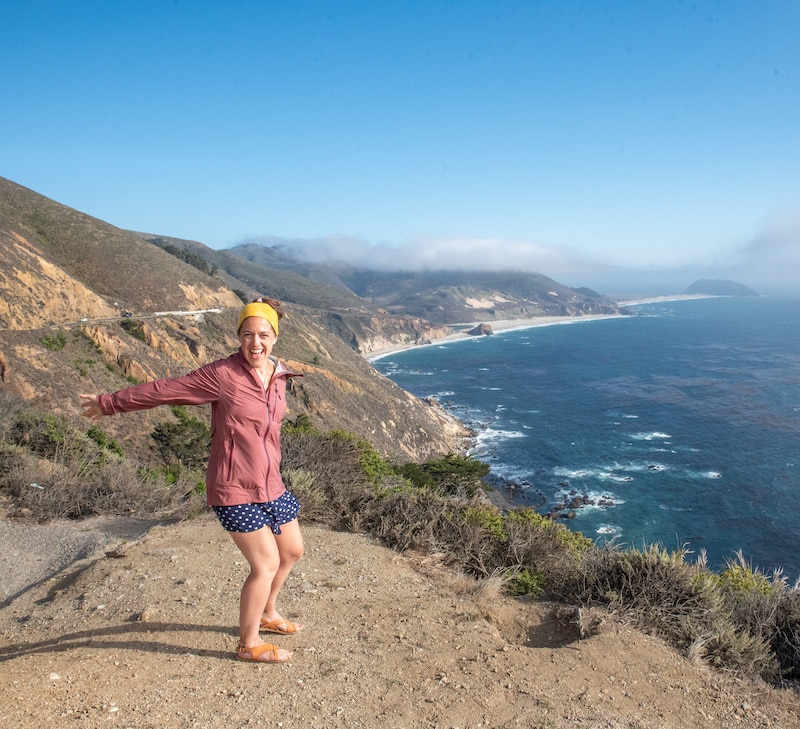
Renting A Car For Your Solo Road Trip
Need to rent a car for driving cross country? Check out Discover Cars to quickly compare your rental options.
Tips For Planning A Trip Cross Country Alone
The planning part can be the most fun; but, it can also be the most overwhelming. There are so many options and it’s hard to choose what to do and which route to take. To help, let’s go over some important tips for long road trips alone cross country.
1. Set realistic goals
One of the biggest mistakes that people make is planning to drive way too far in a single day. Not only can this be exhausting, but it leaves little room to actually explore as you drive across the country.
I recommend planning to drive a maximum of 8 hours each day unless you are very short on time. If you want to visit attractions one day, then plan on driving even less than that.
Realistic goals will help you stick to the itinerary that you create so you don’t get burnt out and aren’t scrambling to make up time at the end.
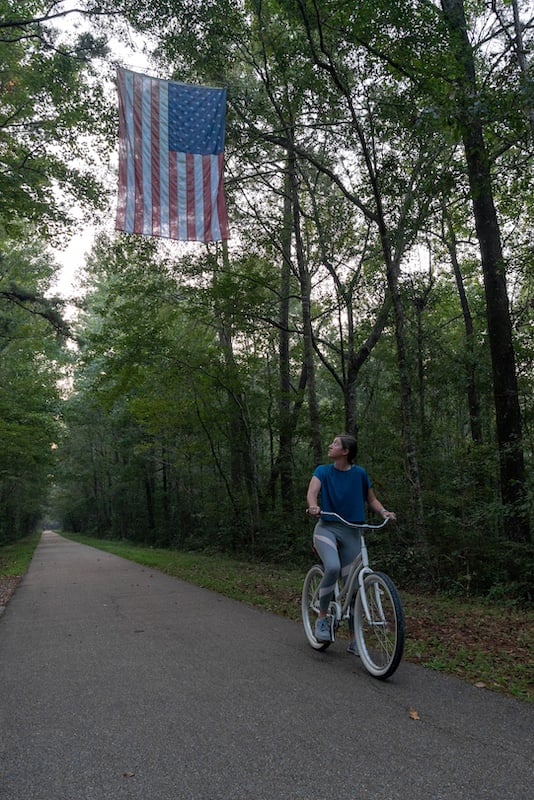
2. Consider the time of year
The time of year that you plan on traveling has a huge impact on your road trip and having as amazing journey. As someone from the southern US, I am not accustomed to driving in the snow.
I would be pretty nervous road tripping alone through the Rockies in the winter. If you’re like me, then you’d want to take a southern route in the winter.
On the flip side, if you’re traveling in the summer, consider taking a more northern route as driving through desert climates of the southwest might be too hot.
You’ll also want to think about timing in terms of crowds. During peak fall leaf-peeping season places like New England, the Blue Ridge Mountains, and even Colorado will be very busy with increased accommodation prices.
3. Create a balance
To really have fun on your solo trip , plan for a balance of longer driving days mixed with shorter driving days meant for exploring and even a rest day every so often depending on how long your trip is.
This allows you to enjoy more of your trip instead of just seeing the sites from behind the wheel. Try to plan a few guided tours in cities or National Parks so you can see the major points of interest quickly.
In my opinion, these exploration days are what make the road trip extra special!

4. Have an emergency plan
When I knew that I was going to be taking more solo female road trips, my husband and I agreed that we would sign up for AAA Roadside Assistance .
This way if anything happens to my car while I’m traveling I can easily get a tow. Just make sure to read the fine print on the membership options about towing distance.
I’ve also set up my emergency contacts in my phone so anyone can contact my husband in case of an emergency.
If you have an iPhone 14 or later, you can set your phone to automatically alert your emergency contacts and emergency services in case of an accident. Here is how to set this up .
Tips For Creating A Solo Cross Country Road Trip Itinerary
Assuming that you have your starting and ending point chosen, there are still many options for routes you can take when driving cross country solo.
Just as there are pros to solo travel in general, there are benefits to a one person road trip—the biggest being that you get all the say in where to stop and what to do. In this section, we’ll go over how to really take advantage of this perk.
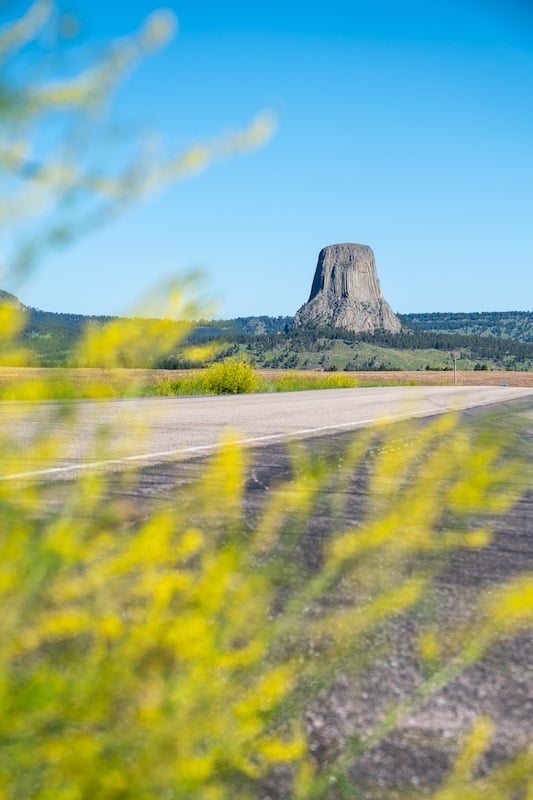
5. Utilize road trip planning tools
First, familiarize yourself with popular routes like the Blue Ridge Parkway, Route 66, or the Mighty 5 in Southern Utah. Here are more of the best solo American road trips if you’re looking for ideas.
Once I have a general idea of my route, I love getting on the Roadtrippers app to look around at what’s along those paths.
🎁 Bonus: You can get $5 off an upgraded Roadtrippers membership with code BTR5QTP .
You can filter what it shows you by interests like the outdoors, sights & attractions, and activities & experiences.
From there, I start saving things—the free plan allows you to add 7 stops—but you can also just write them down or save them in your Google Maps under a dedicated list.
There aren’t a lot of reviews on Roadtrippers so I use Google Maps to check those plus Campendium and The Dyrt to look up campsites.
Other helpful road trip apps and websites I use include AllTrails , which is great for finding hikes, and Atlas Obscura for offbeat attractions.
6. Prioritize “must-sees” vs “would be nice”
Once you have an idea of the route you’ll take and some things you are interested in along the way, you’ll want to start prioritizing them.
Which ones appeal to you most that make sense between your start and end points? Start making a list of your “must-sees” vs the things that “would be nice.”
Your “must-sees” will become your route. Keep a list of your “would be nice” spots though in case you have extra time or something comes up and you aren’t able to visit one of your “must-see” spots.
For example, when I’m traveling I always look for National Park sites as my “must-see” locations then add in other outdoorsy spots or cute small towns nearby.
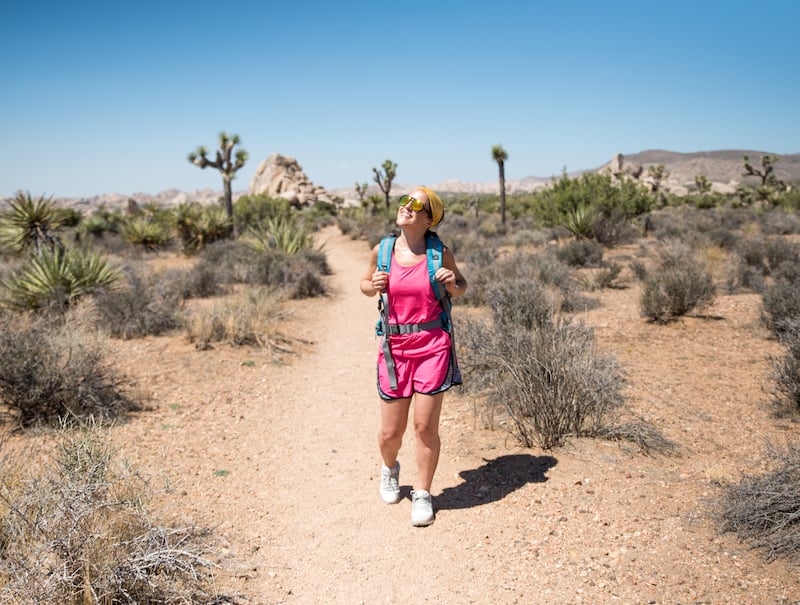
7. Stay flexible
While it’s always good to have a plan, no matter how much time you spend planning a cross country road trip alone, there is always a chance for the unexpected.
Weather, car issues, closed attractions, and more can cause you to have to pivot. This is why it’s important to stay flexible and be willing to change course if you need to.
8. Consider if you are comfortable with remote areas
The last thing I would consider when you plan a cross country road trip is how comfortable you are in remote areas. This is especially true if you’re planning a solo US road trip .
Many areas from the West Coast to the middle of the USA (Kansas, Nebraska, Oklahoma, etc) can be sparsely populated.
If you don’t like the idea of being in remote locations, you’ll want to stick near major interstates throughout this part of the country.
I am in remote areas often, so I decided to buy a satellite communicator for peace of mind. More on that later.
Budgeting For A Cross Country Road Trip Alone
Of course, there are pros and cons to traveling alone , and this includes road tripping by yourself. While it can be empowering, it can also take a hit on your budget when there’s no one to split gas and accommodation costs with.
With that in mind, here are some tips for budgeting for a solo cross country road trip.
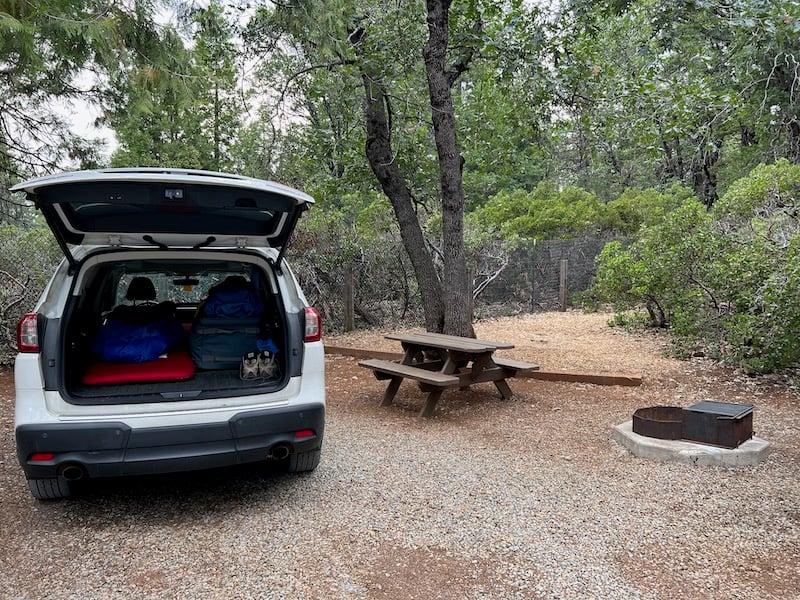
9. Research accommodation options in advance
Where are you comfortable staying and what types of accommodations do you prefer? If you are okay camping then your solo travel budget for places to stay will be much lower.
Personally, on my most recent cross country road trip, I camped every other night at campgrounds and stayed in hotels the rest of the time.
Some people stay in Cracker Barrel, Walmart, or Bass Pro Shops parking lots for free. Personally, I wasn’t comfortable with this as a solo female traveler , though you might be. Just double-check with store managers to make sure it’s okay.
Out west, you can find many free wilderness areas to camp; however, when camping on the East Coast , it’s not that easy.
You’ll want to sit down and look ahead of time at what the accommodation options are for the places you’ll be traveling through so you can find the cheapest rates.
While I personally don’t book accommodations in advance, many people don’t like the uncertainty that brings.
If you do like to book things last minute, you can use the HotelTonight app or website to find deals on last-minute hotel rooms. I find it to be hit or miss.
10. Join fuel rewards programs
A great way to save on gas is by joining fuel reward programs at large gas stations like Pilot, Shell, and Love’s. These programs usually save you between $0.05 – $0.10 per gallon.
The rewards programs can also help you save on snacks, drinks, or other items you might buy at the gas station for extra savings.
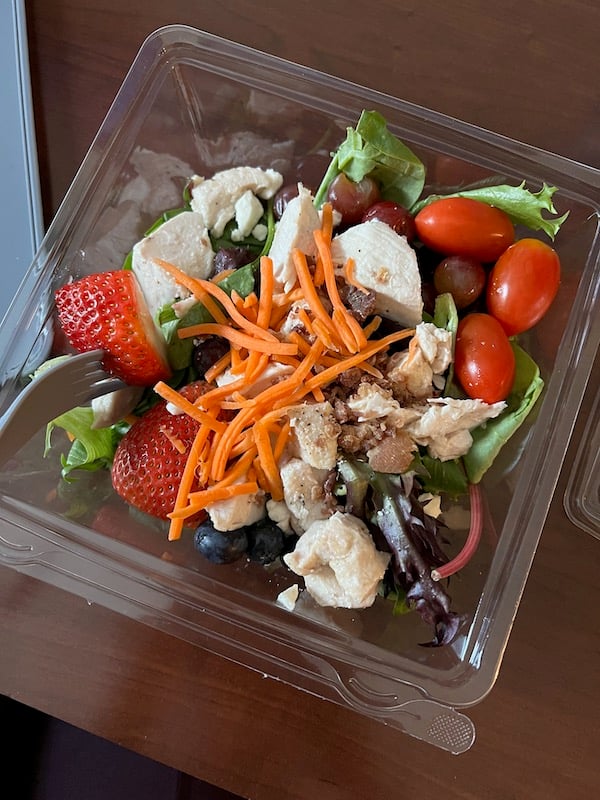
11. Limit eating out
I love eating at restaurants while traveling, but it adds up quickly. If you bring a cooler with you and stop at grocery stores a few times then you can make meals yourself with healthier options too.
I ate a lot of sandwiches on my trip and you can keep fruits and veggies in your cooler. Just make sure to add ice regularly.
Cheese and nuts are great snacks to keep on hand, and if you have time to make homemade protein balls or granola bars before leaving, those are fantastic too.
Another way to cut back on costs is picking up pre-made food at a grocery store. My favorite strategy is eating at the salad bar or deli at a grocery store, which is relatively cheap and healthy.
12. Download cash-back apps
I use the Upside app to get cash back on gas but you can also get cash back at some restaurants. It only works at certain gas station chains though.
Typically I pull up the app once I’m at a gas station to see if cash back is available and if it’s not, I don’t worry about it.
Ibotta is another option where you can earn cash back at grocery stores for specific products but you can earn at other retailers as well like Walmart or Sam’s Club.
13. Have a contingency fund
I’ve already mentioned this, but no matter how much you prepare, things happen. Please have a contingency plan for when unexpected things pop up!
For example, I got a flat tire during a California road trip . Thankfully, it only cost $35 to patch up; but, it would have been much more expensive if I’d had to buy a completely new tire.
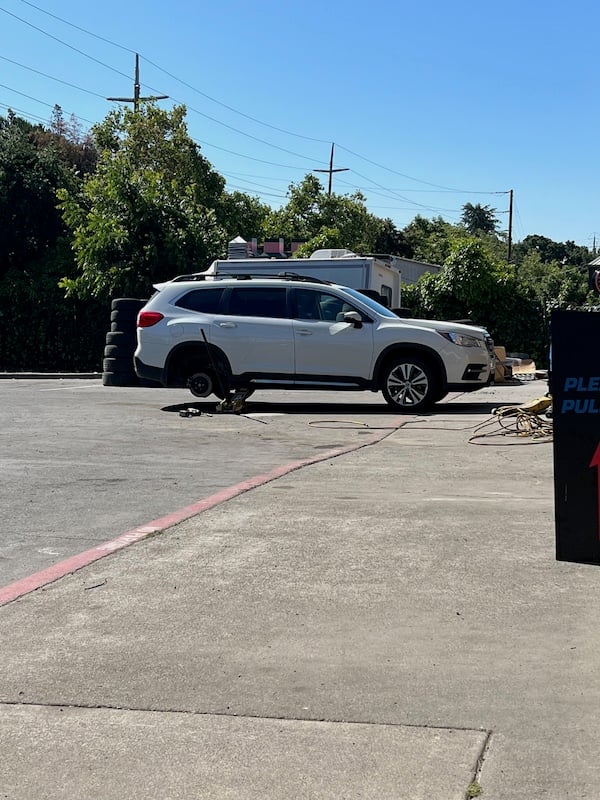
Choosing Accommodation When Driving Across Country Solo
Choosing your accommodations is completely dependent on your comfort level—not only with camping vs hotels, but also with last-minute booking vs things planned out in advance.
Here are some tips for solo road trips that apply no matter what type of accommodation you plan to book.
14. Choose safe areas
Once you have an idea of the cities or towns you’ll be staying in, do some preliminary research to determine if those locations are safe or which neighborhoods are safest in the city.
If I’m booking things last minute, I typically look at Google Reviews to see if anything mentions safety and I’ll pull up the area on Google Maps to look at street view.
No matter what, if you get to where you are supposed to stay and get bad vibes, do not be afraid to leave. It’s not worth sacrificing your safety.
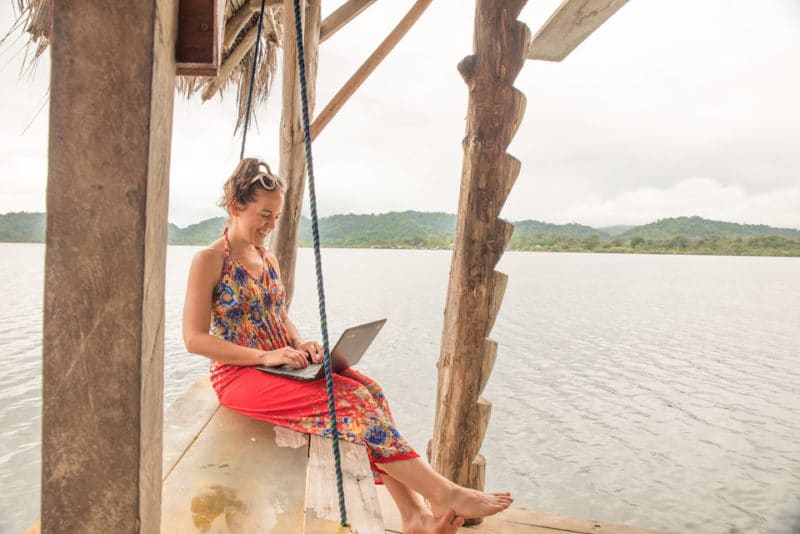
15. Look at convenience from the highway
If I’m short on time, this is one of the biggest factors that I look at. How far is a hotel off the highway? Is it easy to get off the highway and back on?
In addition to the distance from the highway, I also look at what else is around the hotel. If I need food, will I be able to easily grab something nearby?
These are questions you should ask yourself before choosing your accommodation.
16. Don’t overlook amenities
Free breakfast, laundry facilities, free WiFi, and free parking are typically the amenities that I look for. Others are just an added bonus.
Free breakfast means that’s one more meal that I don’t have to pay for and I’ll grab a banana or apple to eat on the road as a mid-morning snack.
Before booking campgrounds, I’m looking at what their bathroom situation is and if there is laundry and WiFi available. Make sure to check if you need specific amenities before booking.
How To Prepare Your Vehicle For A Solo Road Trip
These are some of the most important tips for solo road trips and they are also usually the most overlooked. Driving cross country is a long way, so you want to make sure that your vehicle is in tip-top shape by taking the following steps.

17. Get your oil changed & a full vehicle inspection
While everyone needs to do this, it’s especially important if you are driving an older car long distance. When you take your car in for an oil change, make sure they also check fluid levels, tires, and lights.
They will let you know if they see anything that needs to be fixed before you hit the road. Make sure they check your spare tire too, as you may need it along the way.
Not sure how to change a spare tire? Ask your mechanic for a lesson or check out this guide on changing a tire . You’ll definitely want to know how to do this before embarking on your cross country road trip!
18. Do a deep clean of your vehicle
Maybe it’s just me, but I feel a lot better when I’m starting out with a clean car. Because at the end of a long road trip, my car is in complete disarray.
Cleaning out your car gives you a fresh start for the trip. Make sure you keep a small trash can in there or at least a trash bag where you can collect garbage along the way.
19. Double-check your insurance & registration
Make sure your driver’s license and tags are up to date and double-check that your insurance card and registration are in your glove box.
I know most people typically keep them in their vehicle, but I took mine out just the other day to take to the DMV and forgot to put them back in my car for a few days. It’s always good to check.
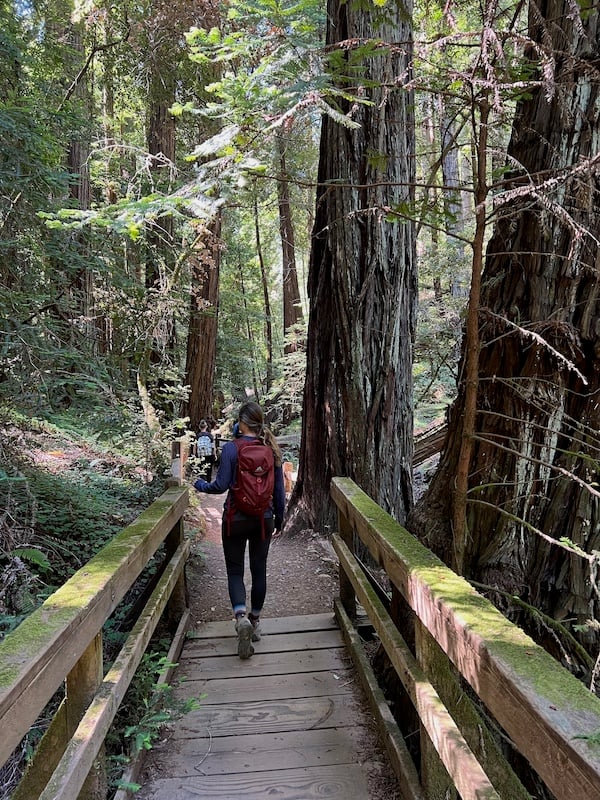
Tips For Driving Cross Country Alone
If you’re wondering how to drive long distances alone, it’s actually not as hard as you might think—especially if you keep the following tips in mind.
20. Start small if you’re nervous
If it’s you’re first time embarking on a long distance solo road trip and you’re feeling uneasy, consider starting with a smaller road trip near home.
For instance, if you live in NYC, you might do a New York state road trip before embarking on a solo Midwest road trip or a coastal Maine road trip .
This will help you gain the confidence to go longer distances without feeling anxious.
21. Download plenty of entertainment
One of my best tips for driving cross country alone is to have plenty of entertainment downloaded. When a trip is really long, I like to have multiple types of entertainment downloaded as well so I can switch it up.
I typically download music, podcasts, and audiobooks to my phone just in case. When taking a road trip alone, singing in the car can be fun for the first few hours, but eventually gets boring.
And because being bored can lead to you feeling tired or restless, you’ll want to make sure you have ways to stay entertained and engaged.
22. Take a nap when tired
If you don’t listen to any of the other tips for driving long distances alone, please listen to this one: take a nap when you are tired.
Driving while tired is incredibly dangerous. According to the National Safety Council , about 328,000 drowsy driving crashes occur annually, with about 109,000 of those resulting in an injury and about 6,400 being fatal.
To help combat this, the CDC recommends getting at least 7 hours of sleep, avoiding alcohol, and developing good sleep habits (try to create a sleep schedule before your road trip).
If you start feeling drowsy or getting “white line fever,” pull off at a rest area or a gas station in a safe area and take a quick nap. If it’s late at night, find a place to stay if needed.

23. Make stops more often
When driving solo, I find that I like to make stops more often. This helps me to stay awake and alert by getting my body moving. Plus, I get plenty of bathroom breaks since I try to stay hydrated on road trips—which helps me stay alert.
Hopefully you are also stopping to explore different attractions, but if you have a long day of driving, it’s still important to get out and stretch your legs regularly.
How To Stay Safe While Driving Alone Cross Country
Travel safety is always important to consider—though it’s extra important when driving cross country alone as a woman.
Unfortunately, it’s something we have to keep in mind at all times. Here are some ways to help protect yourself while driving cross country solo.
24. Share your itinerary with family or a close friend
Once you’ve planned out your road trip itinerary, share it with a close friend or family member. I love spontaneous road trips alone, but even then I give my husband my planned route and let him know each day where I plan to stay that night.
Which brings me to my next point: check in with someone often—preferably daily—so they’ll know as soon as possible when something isn’t right.
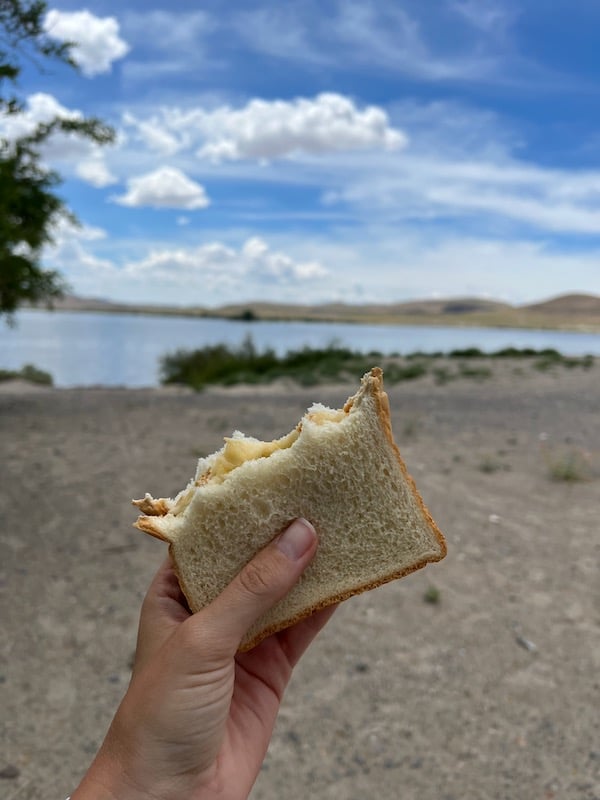
25. Consider taking a satellite communication device
Not everyone needs one of these, especially if you plan on staying within cell service range for most of your trip.
However, typically on my solo road trips I do a lot of hiking in remote areas and know I’ll be driving through smaller towns instead of taking the interstate out west.
The Garmin inReach Mini 2 (which you can also get on Amazon ) is what I have and thankfully I haven’t had to use it, but it does give me peace of mind just in case.
I have a friend who has had to use it twice and it has saved her life, so it really is an invaluable travel safety essential .
26. Only stop in well-lit areas at night
Ideally, you won’t drive after dark when traveling cross country by car alone, but I know sometimes that can’t be helped.
I try to only stop at well-lit areas at night and I don’t run my gas tank down too far in case I get a bad feeling about a place I want to stop.
Additionally, I try to find gas stations that have other things around so they’ll be populated and I won’t be totally alone outside of my car.
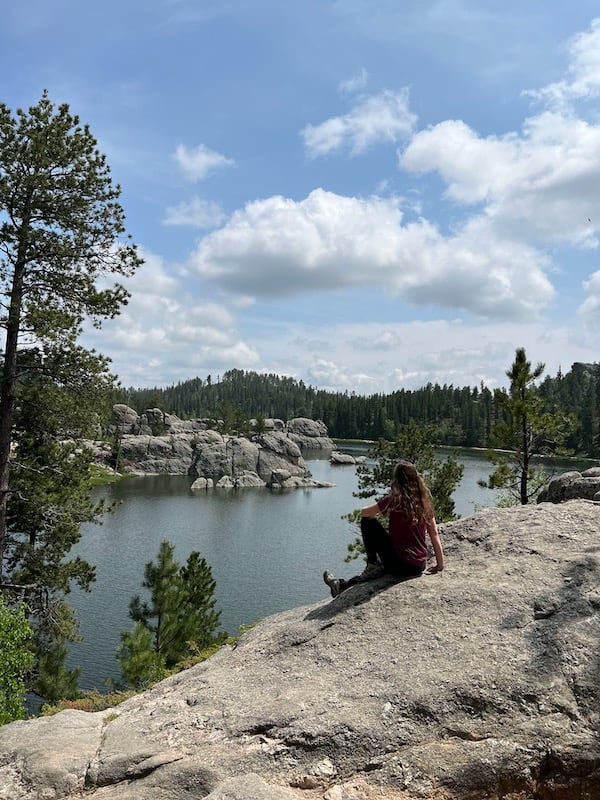
27. Trust your instincts
When you get a bad feeling about something, don’t ignore it. If your gut is telling you that you need to get out of a situation, always trust it.
I’ve driven many different routes around the country and only had one case where I felt uneasy. I got out of there and, to this day, know that I made the right choice.
While in Texas, hiking in a very remote area, I noticed a truck get right up on my bumper and then back off while driving down a dirt road. After I pulled into the trailhead parking lot, the truck slowed down almost to a stop while passing the lot, and then took off.
I walked out onto the trail but had a really bad feeling so after I took some photos of the plants I came to see, I decided to turn back and leave instead of hiking the full trail.
That same truck was in the parking lot when I got back with a lone male driver sitting there with the windows down. Thankfully, another family had pulled in and they were getting their kids out to go on the trail but I left as quickly as possible.
Am I sure that he had bad intentions? No. But I am thankful that I listened to that nagging feeling in my gut and got out of there.
Tips For Packing For A Solo Cross Country Road Trip
In addition to all the regular stuff like clothes and toiletries, there are a few additional things I throw in the car for long road trips as well.
Also, don’t forget the camping gear if you plan on camping at all—which can help save you money on your solo road trip. Other road trip packing tips include:
28. Pack an up-to-date atlas
One of the best tips for a solo road trip that I’ve ever gotten is to pack an atlas—and make sure it’s up to date!
If you don’t know how to read a map, you’ll want to get familiar with it before heading out. I also recommend familiarizing yourself with the route you plan on taking.
This has come in handy for me many times, particularly when driving through areas with little cell service or where I’ve had to make an unplanned stop.
Yes, you can download maps on Google Maps, but that can take up a lot of memory on your phone. Plus, technology seems to always glitch on me when I need it most, so I like to have my route down on paper so I never have to worry.
29. Keep snacks in easy reach
Pack lots of snacks, and try to make them healthy ones. I keep snacks in a bag in my front seat so they are in easy reach when I need them.
Nuts, granola bars, and fruit are just a few good options when you are on the go. Here are also some healthy and energizing snack recommendations .
30. Bring clothes for a week & do laundry
While I love road trips because I can throw anything in my car that I might need, I prefer packing light when it comes to clothes.
There are typically plenty of opportunities to do laundry when you’re on a road trip. Plus, this means fewer decisions to make when getting ready in the morning.
Alternatively, you can use a Scubba Portable Wash Bag —which has a washboard in the bag—to do laundry on the go.
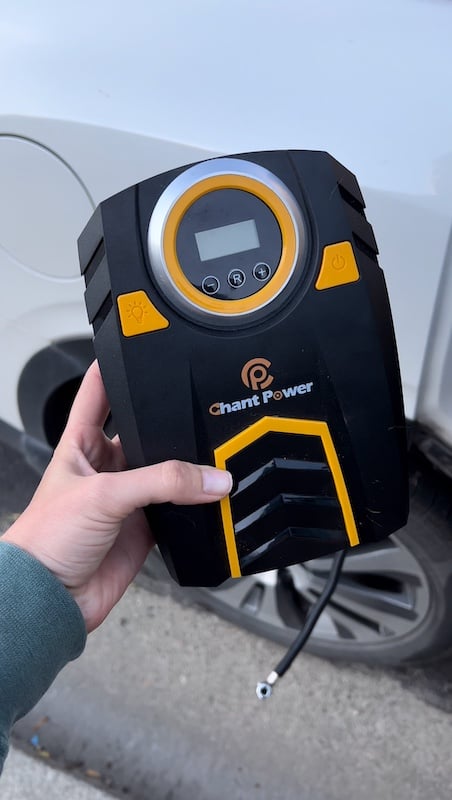
31. Don’t forget the essentials
So what are the solo road trip essentials you should pack? Here are some things you want to be sure to have in addition to your usual travel items:
- Blanket (this sustainably-made Puffy Kachula Adventure Blanket can also be used as a waterproof poncho; get 15% off with code JESSIE15 )
- Extra water and a water filter / filtering bottle if you’ll be hiking
- First aid kit
- Flashlight & extra batteries
- Portable digital air compressor & tire plug kit
- Jumper cables or portable battery jump starter
- AAA card (or other discount cards)
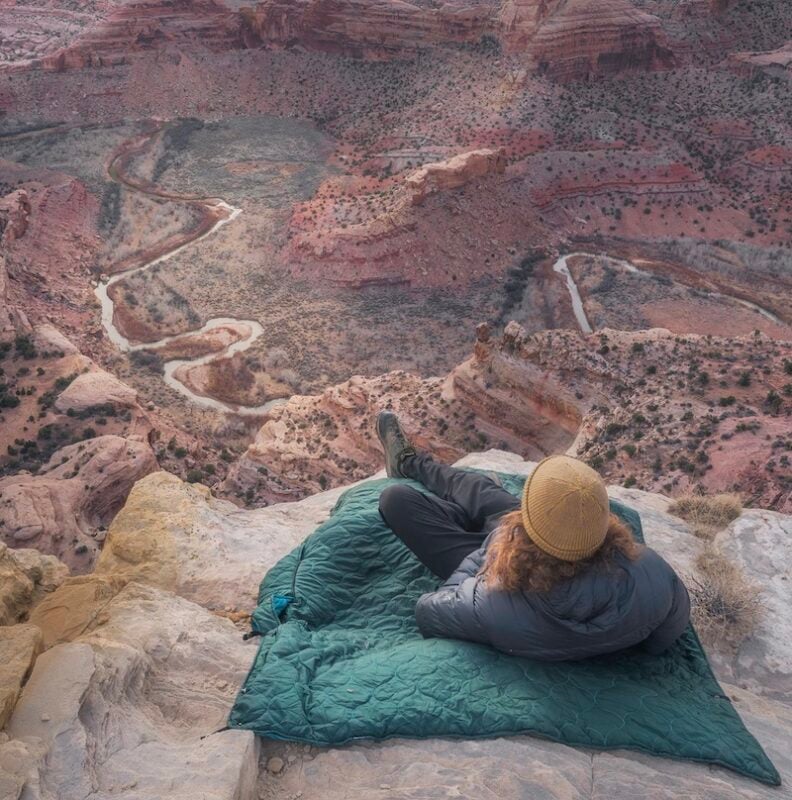
Travel Insurance For Driving Cross Country
When driving cross country alone— or traveling anywhere else in the world—it’s wise to get travel insurance.
One of the best travel medical insurance for travelers is SafetyWing as they’ve got a large network and offer both short-term and long-term coverage—including coverage if you’re traveling for months as well as limited coverage in your home country.
Additionally, SafetyWing is budget-friendly and offers $250,000 worth of coverage with just one low overall deductible of $250.
Click here to price out travel insurance for your trip in just a few clicks .
Frequently Asked Questions About Driving Cross Country Alone
Now that we’ve gone over some of the best tips for a solo road trip, let’s answer some frequently asked questions:
Q) Can you drive cross country alone?
You absolutely can drive cross country alone! I’ve done it and know many other women who have made the trip as well. Traveling cross country by car alone isn’t as difficult as you may think, especially with proper planning.
Q) Is it safe to drive cross country alone?
Yes, it’s safe to drive cross country alone. Follow important solo road trip tips like having an emergency plan, keeping family or friends updated, and trusting your instincts to minimize risks.
Q) Is it safe for a woman to drive cross country alone?
It is safe for a woman to drive cross country alone. While you do need to stay vigilant, I look at it as no different than taking day trips or weekend trips solo. I recommend starting with those kinds of trips and building your comfort level up.
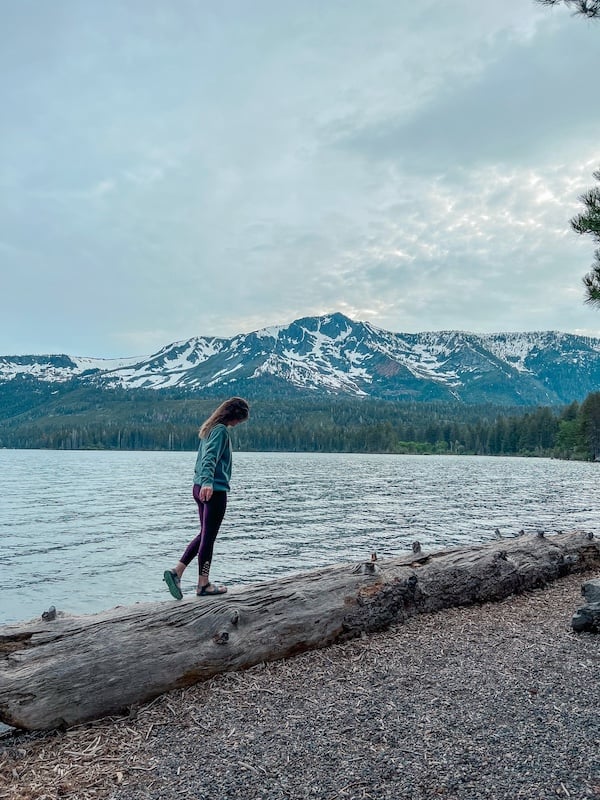
Q) What are the dangers of driving cross country alone?
Some of the biggest dangers of driving cross country alone are drowsiness and potential car trouble or accidents. That’s why one of the biggest tips for long drives alone is to pull over for a nap when you are tired and have your car inspected before leaving.
Q) Should I drive my own car cross country?
This is a personal preference. I like having my own car when driving cross country; however, if you don’t want to put the miles on your car, then you can rent one to make the trip.
You also might consider renting if your car doesn’t get good gas mileage. Price out what it would cost to rent a car and see if you think it’s worth it.
Q) How long does it realistically take to drive cross country?
Depending on your start and end point, you should plan at least 5 days minimum to drive cross country. This would not include much time to stop and explore anywhere and assumes driving approximately 8 hours each day.
If you want to stop and see some sights then you’ll want to give yourself a week or more to make the trip.
Q) How many miles can a person drive in a day?
If you are driving on the interstate, you can cover a lot more miles in a day and I would recommend setting a maximum of 500 miles per day. If you are taking backroads, I recommend even less.
This is also a personal preference, but 500 miles is about 8 hours of driving so hopefully you won’t get too uncomfortable on the trip.
Q) Can you drive cross country in 2 days?
No, you cannot drive cross country in 2 days on a solo road trip. Cross country road trips are 40+ hours of total driving time depending on your start and end points. This does not include any bathroom or food stops nor does it account for traffic slowdowns.

Q) What is the best time of year to drive cross country?
Summer is the most popular time to take a cross country road trip, as the weather is best in most parts of the country; however, if you don’t like the heat, you may want to avoid the desert in the Southwest. Spring and fall are also great times of year to do this if you have the flexibility.
If you choose to travel in winter, you’ll want to keep a close eye on the weather and avoid a northern route through the country if you aren’t comfortable driving in snow.
Q) Is it cheaper to drive across the country or fly?
Typically, it is cheaper to fly across the country vs drive when you are solo. The costs of gas, food, and accommodations add up quickly and are considerably more than what you would pay for a flight. Driving is only cheaper when you have multiple people in the car splitting costs.
Q) Can you drive cross country with a dog?
Yes, you can drive cross-country in the U.S. with a dog, but it requires careful planning to ensure the safety and comfort of your pet, including regular stops for exercise, water, and bathroom breaks, as well as making sure pet-friendly accommodations are booked in advance.
Final Thoughts On Driving Cross Country Alone
Whether you are driving by yourself for the first time or have done it before, I hope these tips have helped you plan your epic road trip and realize that it’s totally doable !
These drives are so freeing and I dream about taking more solo cross country road trips every day. The US is beautiful and diverse and this is an amazing way to appreciate the country.

What would you add to these tips for driving cross country alone?
About The Author

Anna is a travel blogger and photographer at Stuck On The Go where she loves writing about outdoor adventure and small town USA. She created her blog to help busy people incorporate more adventures into their lives and inspire them to try new things—even if it’s scary. You can typically find her out on a trail or in a kayak and she’s always in search of the best restaurants in town. She is based in North Carolina with her husband and German Shepherd who often tag along on weekend trips but she’s known to take off on long solo road trips often.
Related posts:

Hi, I’m Jessie on a journey!
I'm a conscious solo traveler on a mission to take you beyond the guidebook to inspire you to live your best life through travel. Come join me!
Want to live your best life through travel?
Subscribe for FREE access to my library of fun blogging worksheets and learn how to get paid to travel more!

Turn Your Travel Blog Into A Profitable Business
Subscribe to my email list to snag instant access to my library of workbooks, checklists, tutorials and other resources to help you earn more money -- and have more fun -- blogging. Oh, and it's totally FREE! :) // Privacy Policy .
Check your inbox for your welcome email + resource library password!
Thanks for the useful article..
Leave a Comment Cancel Reply
How to Plan a Solo Cross-Country Road Trip: Your Complete Guide
- Apr 16, 2023
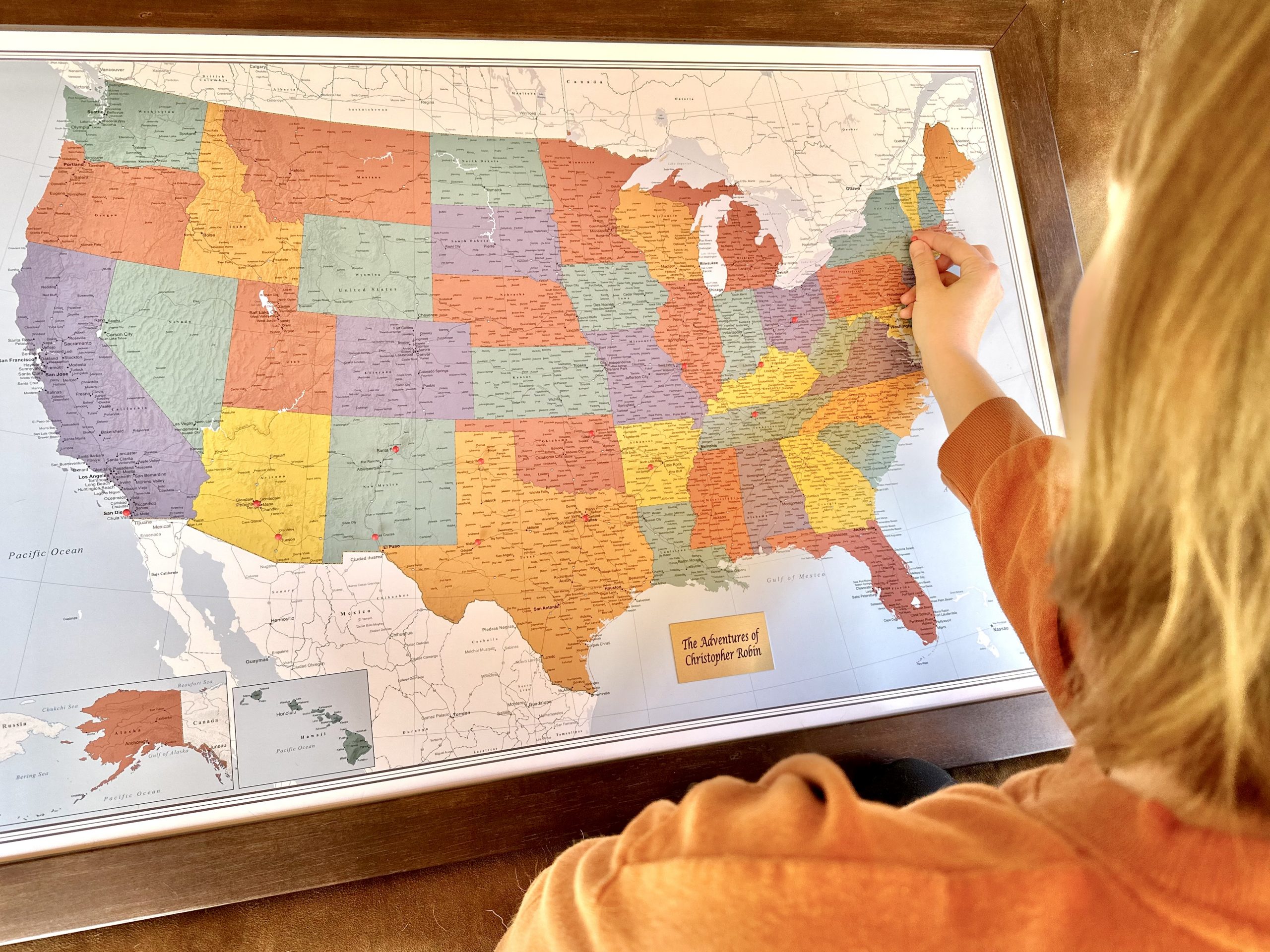
In March 2023, I took a solo cross-country road trip from Boston to San Diego and back. Planning my road trip was a multi-month endeavor that I enjoyed almost as much as the trip itself, so I wanted to put my planning process down on paper—and also share the lessons I learned from the actual drive—to help others plan their own adventures.
How to Decide Whether or Not to Go on a Solo Cross-Country Road Trip
First and foremost, there’s the question of whether to go on your trip alone or with another person. On one hand, driving across the country by yourself is an almost marathon-level test of physical and mental endurance. On the other hand, it gives you unique freedom to take exactly the kind of trip you want to take, without concern for another person’s preferences.
The Advantages of Going on a Solo Cross-Country Road Trip:
- You can stop only at places that interest you
- You can spend as long as you want at each destination
- You can listen to whatever you want in the car
- You can spend your free time however you like
- You can better control your costs
The best way to decide whether to go on a solo cross-country road trip is to take day trips. Try driving 5 or 6 hours at a time to see how you like it. If you’re completely depleted by this kind of trip, it’s either a sign that you need to bring a co-pilot along with you, or you need to make sure that you have enough time on your trip to drive fewer hours per day, or to make more frequent stops.
A Note on Embarking on a Solo Cross-Country Road Trip as a Woman: You will face a lot of opinions and potential resistance from the people around you about your safety as a solo female traveler. Let others’ feedback guide you to take precautions to make sure that you feel safe on your trip, but try not to let them sow doubt in your mind about whether or not this is something you should be doing in the first place. If taking a cross-country road trip has been a lifelong dream for you, doing it alone may be your best option for creating the experience that you want. Be aware of your surroundings at all times, and always trust your gut if a situation feels questionable to you; but know that 99.9% of the people you’ll meet along the way have good intentions, and you are more than capable of looking out for yourself while you’re traveling, just as you do in your daily life. (I found communities like The Solo Female Traveler Network incredibly helpful in bolstering my confidence before my trip.)

Cross-Country Road Trip Routes: How to Plan Your Trip
The first step in planning your solo cross-country road trip is to choose your route. You can and should spend weeks or months planning your route, not only because there are an infinite number of options available to you, but also because you’ll need to reserve things like hotels and national park trips in advance.
Questions to Consider in Planning a Route for Your Cross-Country Road Trip:
- Which places are your priorities to visit?
- Which places can you stop at between your origin and your destination each day?
- How many hours are you comfortable driving per day? (I chose to drive no more than 5-6 hours per day to allow me to sightsee and rest.)
- Will you drive across the country and back, or just one way?
- If you’re driving across the country and back, will you take a different route each way? (I recommend taking a different route each way to see more of the country, but taking the same way there and back allows you to explore each destination more thoroughly.)
- Do you prefer to take freeways, smaller highways, or back roads?
- Do you want to avoid toll roads? (Keep in mind that different states use different prepayment systems—your EZ-Pass won’t work in states like Texas and Oklahoma that have their own toll systems, so be sure to have cash on hand.)
- Which navigation system will you use along the way? (I used Waze on my iPhone, but also had a car GPS and an atlas as back-up methods.)
For assistance in planning your route, Facebook groups can be great sources of advice. For example, members of the group National Park Road Trips will offer feedback on the route you plan to take, when to visit certain parks, and how long to spend in each place.

How to Plan a Cross-Country Road Trip: When to Go
When it comes to planning a cross-country road trip, when you go is just as important as where you go. Why? There are two things that can throw off even the most impeccably planned road trip: weather and traffic.
How to Reduce the Chance of Bad Weather on Your Road Trip: You can’t change the weather, but you can choose a time to go where bad weather is less likely. I found Wikipedia enormously helpful in planning this aspect of my road trip: For any city, scroll down to the Climate section to view the typical weather (both temperatures and precipitation) by month. This was how I learned that March in the Great Lakes or the Rocky Mountains is not, in fact, spring, but an extension of winter, so I should avoid routes that pass through these areas unless I want to drive through snowstorms. April and October are generally considered the best months to travel without running into boiling or frigid temperatures, but for that reason, they’re also the most popular times to visit top destinations.
How to Deal with Bad Weather When It Happens: Be sure to have a Plan B for each day of your trip: If it’s going to storm or reach dangerous temperatures on a day when you planned to visit a national park or other outdoor destination, what can you do instead? For example, I bookmarked bookstores in every city I planned on passing through so I would have a good rainy-day activity; museums are another great option. It’s important in these cases to be flexible and not let bad weather ruin your mood just because it’s messing with your plans. Also, make sure that you keep supplies like an ice scraper, a warm blanket, and non-perishable food in your car in case you get stuck in a snowstorm. Two bulky but smart items to have on hand are kitty litter (to help your tires gain traction on ice) and water (to cool your radiator if your car overheats).
How to Avoid Traffic on a Cross-Country Road Trip: Choose the right time of day to be on the road. Plan to visit or leave cities before or after rush hour, whether in the morning or the evening. When you’re planning your trip, tell Google Maps what time you plan to arrive at a particular destination, and it’ll give you insight into whether or not traffic is common at that time. When you’re on the road, use an app like Waze to direct you around backups. If you’re visiting national parks, be sure to arrive outside of non-peak hours (for example, very early in the morning or late in the day) to avoid getting stuck in a long line of cars at the gate or at popular sites, and be aware that you may need to make reservations ahead of time depending on the parks you plan to visit.

How to Plan a Cross-Country Road Trip Itinerary
Here are the steps that I took in planning my itinerary (using Google Maps and an Excel spreadsheet):
- Start by searching for the fastest route from Point A (your origin) to Point B (your destination).
- Next, add in any must-visit destinations along the way. Google Maps will allow you to add 10 stops, so you may need to plan one segment of your trip at a time.
- Cull your list of destinations until you’re driving an ideal number of hours per day. There will be places you remove from your list because they add too much time, as well as places you add to your list because they turn out to be along the way.
How to Find Destinations Along Your Route: Sites like Roadtrippers , Roadside America , and Atlas Obscura allow you to find quirky stops between your origin and your destination.
Consider the Time of Day You’ll Visit Each Place: Put as much time into planning when you’ll get to each destination as you spend planning where to stop. For example: You might want to hit the road to avoid traffic and get to your destination sooner, then realize that you hate driving in the dark. You might want to visit a city or national park, then realize that the time you plan to get there puts you at risk of overcrowding, rush hour traffic, or unbearable temperatures. If you want to see a national park when it’s most scenic, you might want to plan to arrive at sunrise, golden hour, or sunset rather than in the middle of the day, when the sun’s directly overhead.
Other Considerations: If you plan on stopping in cities along the way, be sure to account for potential traffic, as well as parking. If you plan to stop at national parks, make sure to allot a full day for each one; find out whether you need reservations ahead of time; and buy an annual pass if you plan to visit more than three or four parks. And don’t miss out on any state parks along your route—these can be just as incredible as national parks, and potentially less crowded.
How Much of Your Itinerary to Plan Ahead: This is a matter of personal preference. I’m a planner, so I created a spreadsheet that broke down each hour of my trip. This allowed me to view how much time per day I’d spend driving vs. the free time I’d have to explore each stop. But even if you plan out every detail, it’s critical to remember that you’ll need to be flexible when you’re out on the road. It’s okay to decide that you want to skip a stop you planned on making to get to your destination sooner, or to make an unplanned stop to see a roadside attraction.
- Leg A (48 hours, 3,182 miles): Boston, MA > New Columbia, PA > Columbus, OH > Nashville, TN > Hot Springs, AR > Dallas, TX > Midland, TX > Las Cruces, NM > Tucson, AZ > San Diego, CA
- Leg B (47 hours, 3,064 miles): San Diego, CA > Joshua Tree, CA > Phoenix, AZ > Santa Fe, NM > Amarillo, TX > Tulsa, OK > St. Louis, MO > Louisville, KY > Pittsburgh, PA > Hudson, NY > Boston, MA

Where to Stay on a Cross-Country Road Trip
Some people prefer not to book accommodations ahead of time, instead finding a motel to stop at when you’ve driven as far as you can for the day. Others avoid this problem altogether by camping along the way. I personally preferred to find Airbnbs to stay in along my route, ensuring that I would have a place to stay each night in my ideal destination; so here’s my advice if you want to do the same.
Questions to Consider When Booking Airbnbs for Your Road Trip:
- Do you want to stay right in the destination you’re visiting? (If you want to stay downtown, you’ll pay a premium for your stay. However, this may give you the ability to walk to local restaurants, stores, and sightseeing spots, which can be a major plus. On the other hand, if you don’t mind driving, it can be cheaper and easier to stay in outlying neighborhoods rather than downtown.)
- Do you want your own place? (Some Airbnbs are located on someone’s property, whether they’re a separate guest house or a room in their home. You’ll want to decide what you’re most comfortable with, whether you feel safer knowing that someone’s nearby, or prefer to stay in your own place. Staying in a guest house can be cheaper.)
- Do you need a full kitchen? (Airbnbs with a mini-fridge and microwave are common and can be more affordable than those that include a stove/oven and full-sized fridge.)
- What’s the parking situation? (To keep your car safe and cut down on costs, you may want to look for Airbnbs with a driveway or dedicated parking area. If you’re staying downtown, you might otherwise have to pay for street parking that isn’t reserved; I ran into this in Columbus and Pittsburgh, and it’s common in dense, older cities like Boston and New York as well.)

How Much Does a Cross-Country Road Trip Cost?
In total, taking fuel, lodging, and food costs into consideration, I estimate that I spent between $4,000 and $5,000 on my 24-day solo cross-country road trip.
- Fuel Costs: Consider how many miles you’ll drive per day, and how many miles per gallon your car gets, depending on whether or not you plan to take highways. Driving mainly on freeways for 5 to 6 hours per day (which are more efficient than roads with stop lights), I found that I needed to fill up every day and a half or two days. Of course, gas prices vary a great deal depending on when you go and where you’re driving, but prices are cheaper wherever gas stations are more numerous, so try to fill up whenever you’re in a well-populated area if you have less than half a tank remaining.
- Lodging Costs: Consider how much you’re willing to spend on accommodations each night. I wanted to stay in desirable neighborhoods within the cities I was visiting, or as close as possible to the national parks I was visiting; so I put a lot of time into finding the right Airbnbs in these locations. I found that a budget of $130 per night was sufficient (but paid as little as $70 for some places), and I booked four months ahead of time to ensure that I would be able to find places that met all of my requirements. Be sure to include fees and taxes in this cost—they may not be visible until you’re about to book an Airbnb, but can really drive up the cost.
- Food Costs: I kept costs down by eating pre-packed snacks for two meals a day, and eating out for dinner only. I ordered food for pickup or ate in person to avoid paying delivery fees. Don’t forget to factor a 20% tip into your costs.

What to Pack for a Cross-Country Road Trip: Checklist
My Cross-Country Road Trip Packing List:
- For the front seat: Sunglasses, eye drops, glasses, hand sanitizer, trash bag, water bottle, snacks, chapstick, paper towels, disinfecting wipes, glass cleaner, sunscreen
- For the trunk: Car repair kit, first aid kit, ice scraper, backup GPS/atlas, duct tape, baby wipes, spare glasses & sunglasses, beach towel, extra water, extra snacks
- Clothing (beyond the obvious): Hat, walking shoes, rain coat, waterproof boots, light jacket, heavy jacket, gloves
- Toiletries: Toothbrush, toothpaste, floss, shampoo & conditioner, hairbrush/comb, moisturizer
- Other items: Laundry bag, laundry detergent pods (if applicable) ear plugs, phone charger, reading material, emergency meds (for headaches & upset stomach), camera & tripod
Staying Organized: What you pack is just as important as how you stay organized throughout your trip. First, make sure that the things you need to bring in with you every night are easy to carry and organized separately from the things you need less often, or will only need in case of emergency. Second, make sure that everything you leave in the car can fit in your trunk and be hidden from view to prevent theft, and don’t leave anything of value in your car at any time.

Other Considerations for Your Solo Cross-Country Road Trip
What to Drive on a Cross-Country Road Trip: On your trip, you’ll find that you’re essentially inseparable from the vehicle you’re driving, whether it’s your car, a rental car, or an RV. Make sure that your vehicle will be safe at each place where you stop, especially overnight. Ensure that you feel completely comfortable driving and parking your vehicle in a variety of conditions, whether you’re parallel parking downtown or navigating dirt roads in a national park. Get your vehicle inspected beforehand so that you’re confident it’s in good shape. Find out whether your insurance company offers roadside assistance ahead of time, or invest in a AAA membership. (I decided to take my own car rather than a rental that I would have felt less comfortable in, and I got my car inspected at the halfway point to make sure that it was in good enough shape for the second leg of the journey. Both decisions really helped to ease my anxiety.)
What to Eat on a Cross-Country Road Trip: I have dietary restrictions and didn’t want to spend the time and money to eat out for every meal. As a result, I spent a lot of time bookmarking restaurants on Yelp that could accommodate my needs within walking distance of each Airbnb I stayed in, and this research really paid off. I also brought a plethora of non-perishable snacks with me in the car to make sure I’d have enough to eat along the way. Make sure to buy snacks that are easy to eat on the go and will adequately tide you over between meals. (I bought my car snacks from Thrive Market , an online grocery store with a huge range of healthy, delicious options for any diet. I put high priority on finding snacks high in protein and nutrients to keep my diet healthy while I was on the road.)
My Favorite Road Trip Snacks:
- Bobo’s oat bars: Apple pie bites and chocolate almond butter bars
- Luna bars: Chocolate peppermint and lemon blueberry
- NOKA smoothie pouches: Super berry , strawberry pineapple , and mango coconut
- Mamma Chia squeeze pouches: Strawberry lemonade
- Mavuno Harvest dried fruit: Pineapple and mango
What to Listen to on a Cross-Country Road Trip: I personally enjoyed having a variety of things to listen to depending on my mood. I made a solo cross-country roadtrip playlist (recommended if you like folk and indie music!), rented audiobooks from my local library using the app Libby , and had several podcast series to listen to as well. Be sure to download the media you plan on listening to before you hit the road, and to queue up several hours of content at a time to avoid needing to use your phone while you’re driving.

Tips for Driving Long Distances Alone on a Solo Cross-Country Road Trip
- Keep snacks and water within arm’s reach; stave off dehydration and hunger to stay alert (but don’t eat till you’re overly full, as this can make you sleepy)
- Have a variety of things to listen to to keep you alert (e.g. an energizing playlist, songs you can sing along to, conversational podcasts, a mystery audiobook)
- Stop to stretch and get fresh air every 2-3 hours, and do some cardio exercise (e.g. jumping jacks, speed-walking, high knees)
- Stock the car with things to make you comfortable (tissues, moisturizer, chapstick)
- Call a friend while taking a break from driving to check in and get reenergized
- Don’t keep the car too warm
- Pre-download maps for rural areas, and have a backup atlas or GPS that doesn’t rely on internet
- Break up long drives with a lunch break
- Pull off whenever you see something interesting, even if it’s unplanned
- Budget traffic and rest stops into your driving plans
- Make sure your AAA coverage is up to date, or that your car insurance offers roadside assistance

I hope that these tips were helpful in planning your solo cross-country road trip! Traveling alone can be incredibly liberating, even though it requires more physical and mental endurance than traveling with another person. My three most important tips of all: Have back-up plans for everything, do your research so you know what to expect, and don’t let your whole trip get derailed if things don’t play out how you expected them to.
Share this:
- Click to share on Twitter (Opens in new window)
- Click to share on Facebook (Opens in new window)
Robin Young is the writer and photographer behind Feather & Flint.
Let’s Talk About the Decision to Not Have Kids
April 2, 2022, 21 healthy, vegetarian, gluten-free, noom-friendly recipes, january 1, 2024, featherandflint.


How To Plan A Solo Road Trip (Solo Road Trip Tips)
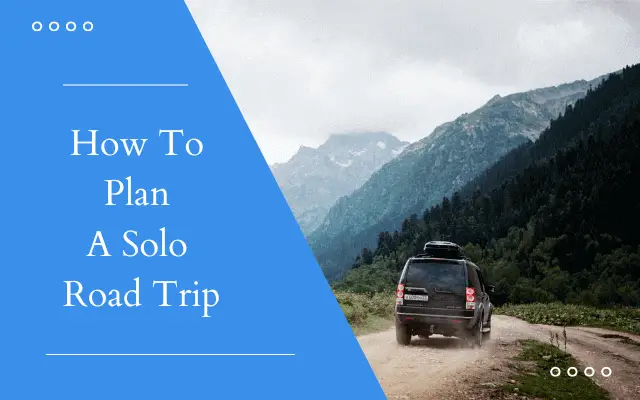
Last Updated on January 25, 2023 by Rose Morah
A solo road trip may sometimes feel a little crazy, especially if it is your first time.
You will have moments of doubt, fear, and stress before, during, and after the road trip.
However, all these will form a great part of a memorable experience.
The following are tips for planning a solo road trip:
1. Prepare your car before the road trip
2. plan a realistic itinerary , 3. plan your road trip budget wisely, 4. plan for fuel/gas stops, 5. let your friends or loved ones know about the trip.
- 6. Don't give out every detail about your trip online
7. Be prepared to take any necessary action with no fear
8. focus on enjoying your trip, 9. never assume that you will always have a good signal, 10. prepare for emergencies in advance, 11. download helpful road trip apps, 12. always be prepared for extreme weather, 13. make sure your door locks automatically, 14. know how to take care of your car.
- 15. Know how to hide your valuables
16. Don’t drive when tired or sleepy
17. pick places to sleep wisely, 18. invest in must-have road trip car accessories, 19. carry enough snacks and water, 20. carry emergency items for the road trip, 21. carry some books, 22. create a music playlist and download podcasts.
- 23. Listen to your gut feeling
24. Find what works for you
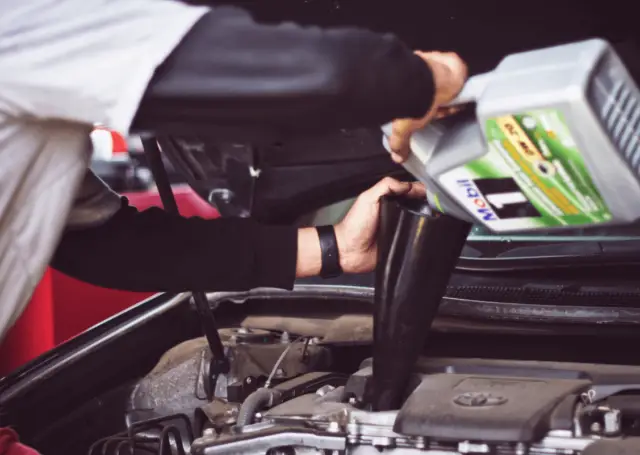
Preparing your car before the road trip should be the first thing you do when planning a solo road trip.
The type of preparation will depend on the distance you intend to cover throughout the entire trip.
For instance:
- If you will be covering a long distance, then it would be important that you do a full vehicle checkup/service.
- If you will be covering a short distance, depending on when you last serviced the vehicle, you can just do a checkup of only what’s necessary.
See also: Tire Pressure Guide: What is the Proper Tire Pressure For Vehicles?
Sometimes when planning a road trip to an exciting destination, it is easy to over plan and end up with an unrealistic itinerary.
But luckily, you can plan a realistic road trip itinerary with the help of a road trip app.
We have a detailed article about the best road trip planner apps .
It is important to take time and calculate the cost of the entire road trip, especially if you’re planning a road trip on a budget.
Knowing your road trip cost helps you figure out how to cut them down and stay out of big debts.
See also : How To Calculate The Average Cost Of A Road Trip .
This is one thing that most people overlook when planning a solo road trip.
It is easy to find yourself in desperate situations while driving in the dark where you need to get to the closest gas station.
This may happen due to unexpected occurrences, such as a roadblock, which will force you to take back roads with no gas stations available.
This can no doubt be risky, especially for women going on solo road trips.
Therefore, here is what I’d recommend:
- Always fill up whenever you have the chance, especially when driving on an unfamiliar route. This way you avoid getting stranded in case there are no more gas stations ahead. Bear in mind that some rural areas open gas stations only during specific times of the day.
- Keep the tank above half full. Personally, when I am doing a long road trip, especially in rural areas, I make sure my tank is always half full. This usually takes me about 2 to 3 hours before I can stop to refill. But of course, this depends on the type of vehicle you take on the road trip.
- Carry backup gas. It will help you in case you get stranded in the middle of nowhere.
See the following Smart Ways To Conserve Gas When Running Low .
Anything can happen on your trip. For example;
- You could have a car crash.
- Get mugged.
- Your car may break down in the middle of nowhere.
- You may not have access to your money when you need cash.
See : How To Deal With A Frozen Bank Account When Abroad .
Therefore, it is important to let your loved ones know where and when you are going. You need to also update them during the trip, especially if it is a long road trip.
This way in case something bad happens, they will have your back.
6. Don’t give out every detail about your trip online
It is important to know how to protect yourself from people who may want to harm you.
As much as it is important to let your friends and loved ones know about your trip, I’d also highly discourage you from taking it to social media.
Telling or posting all your plans and dates on social media before your trip may end up costing you.
You never know who is watching and waiting to harm or steal from you.
“You never know who would be after you”
I’d recommend you post after the trip.
Another way of protecting yourself on a solo road trip is being prepared to take the necessary actions.
For instance, if you notice something is not right at the place where you will be spending the night, you need to leave.
Personally, I had an experience where the check-in staff made me feel uneasy. I had to leave immediately.
I’ve also had situations in Airbnbs that required me to act fast.
You always need to be mentally prepared.
See also : Tips For Driving Long Distances At Night .
When planning the trip, aim at making it as enjoyable and interesting as possible.
For instance, what do you do when you find yourself on a boring route?
Personally, I search for backroads/diversions along that route that I could explore.
You also don’t have to fully rely on your original plan, especially if you realize that it hindering you from enjoying the best routes along the way.
For a fun and memorable trip, you need to be flexible and spontaneous.
You might also like: How To Entertain and Keep Yourself Busy On A Long Car Ride (10 Tips) .
If you are traveling to unfamiliar destinations on a solo road trip, you wouldn’t want to lose signal, especially if you are relying on online maps to get you there.
Therefore, I highly recommend you carry a paper map or download offline maps.
This will save you in case:
- You lose signal.
- You lose your phone. i.e if it gets stolen or dies e.t.c
Before you leave, you need to make sure that you have the following in your notebook:
- Roadside assistance phone number
- Health insurance helpline
- Friends or relatives’ addresses and written down phone numbers.
This is in case you lose your phone with all the information in it.
A good road trip app can make a solo road trip more enjoyable.
The following are types of road trip apps to consider when planning a solo road trip:
You would rather be over-prepared for the weather than not be prepared at all. It’s better to be safe than sorry.
Pack smart and be sure to include all-weather clothes.
As a safety precaution, be sure your door locks automatically when traveling solo.
In the past, I have experienced situations where someone tried to open my door while stopping at the traffic lights and while in the car park eating.
Driving a car with doors that automatically lock is crucial, especially if you are traveling on a route that is known for insecurities.
If it is going to be a long solo road trip, your car might need an oil change in the middle of the trip.
Therefore, if you plan to go on a 6000 miles road trip, and you normally change your oil every 4000 miles, you’ll need to talk to your mechanic to find out if you will still need the oil change.
15. Know how to h ide your valuables
Sometimes you may need to hide or cover your valuables when going on a solo road trip.
This is because some valuables might attract lots of eyes and ideas from strangers, especially if they notice that you are solo.
Things like cash, laptops, and phones need to be hidden or covered.
See also: Clever Ways To Keep Your Money Safe When Traveling .
If you had reserved a place to sleep in advance but feel like you are getting tired even before you get there, here is what I’d recommend before sleep takes you over:
- Eat snacks that help you stay awake while you drive.
- Take drinks that will keep awake while driving.
- Take a break. Pull over, set an alarm, take a nap, wake up, and hit the road.
Driving when tired or sleepy is like driving while drunk. This is because you are not alert and if anything happens and you will not be able to react in a timely manner.
Additionally, you need to always be alert and aware of your surroundings.
The good thing is that there are healthy snacks that help you stay alert when driving for long hours.
Check out healthy non-refrigerated snacks to help you stay awake while you drive.
Depending on your budget, there are many options to consider when it comes to the choice of places to sleep.
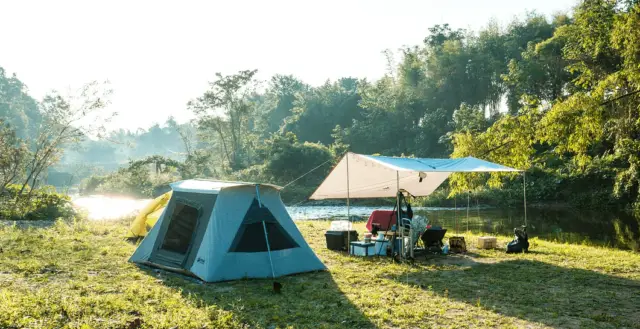
11 Best Cars To Sleep In (Tips From Avid Campers) .
Read This Before Sleeping In A Car At A Truck Stop .
There are car accessories that are a must-have before going on your road trip.
These accessories save you unimaginable costs in repairs and help make your road trip as smooth and enjoyable as possible.
Check out these must-have road trip car accessories for what should be on your list of solo road trip accessories.
You might also like these must-have Hi-Lift Jack accessories
Drinking water keeps you well-hydrated while driving. Snacks, on the other hand, give you the energy you need to get to your destination.
Carrying snacks and drinks has helped me a lot in the past, especially when driving on a route that has very few restaurants or with restaurants that are very far apart.
Remember to include that when planning a solo road trip.
Some of the items you may need to carry on a solo road trip include:
- Toilet paper roll.
But of course, that depends on the length of the trip.
Reading books can help beat boredom, especially when you get to your hotel room.
Listening to a good music playlist or podcast while driving solo is entertaining. This type of entertainment is key to a fun and enjoyable solo road trip.
23. Listen to your gut feeling
Trusting your gut could help you make important decisions during the road trip.
Most of the time your gut is always right. Trust your gut.
What makes my road trip fun and enjoyable could be different from yours.
It is important to know what works for you and have the freedom to do whatever you want.
This is what makes a solo road trip better than a family/ friends road trip .
Don’t worry about the unknown. Plan, properly prepare, and just hit the road!
Hello there! My name is Rose. I’m passionate about electric cars and clean energy. My adventurous spirit and journalistic pursuits make each day fascinating and far greater. I consider traveling not just about the grandeur moments, but the little elements that transform the whole experience.
Related Posts

How To Sleep In The Car Overnight (Best Tips & Hacks)

How To Quickly Fall Asleep In The Car
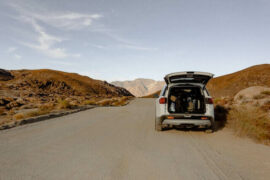
How To Sleep In A Small Car (Best Tips & Hacks)
- Car Buying Tips
- Destinations
- Car Road Trip
- Motorcycle Road Trip
- Travel Tips
Type above and press Enter to search. Press Esc to cancel.
Before you go, check this out!
We have lots more on the site to show you. You've only seen one page. Check out this post which is one of the most popular of all time.
How To Drive In A Solo Road Trip [All Guideline]
If you’re planning a solo road trip but haven’t been sure how to go about it, worry no more! In this guide, we’ll show you everything you need to know how to drive in a solo road trip.
Cause Planning a solo road trip can be an exhilarating experience, but it’s also important to remember to take care of yourself while traveling. We’ll cover everything from packing your car to choosing the right destination and everything in between.
So whether you’re looking for an easy or challenging road trip , this is the guide! In this blog post, we’ll outline the best practices for safe driving, provide tips on avoiding boredom on your trip, and advise on the equipment you’ll need to make the trip a success.

Table of Contents
The Equipment You’ll Need
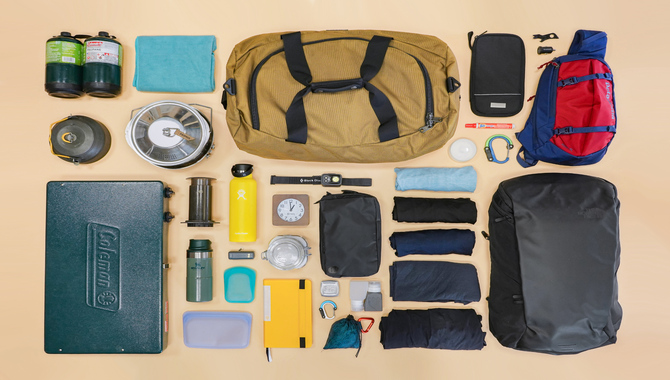
Planning a solo road trip can be a little daunting. But with proper preparation, it will become easy. First and foremost, you’ll need a car. Make sure it’s in good condition, and you have the necessary documents to drive in the United States.
Next, pack snacks and drinks for the trip and a road map of the area you’re traveling in. Finally, prepare for the road trip by practicing your driving skills. This will help you avoid accidents and make the journey much more comfortable.
Safe Driving Practices While On Your Solo Trip – Follow The Below Guideline
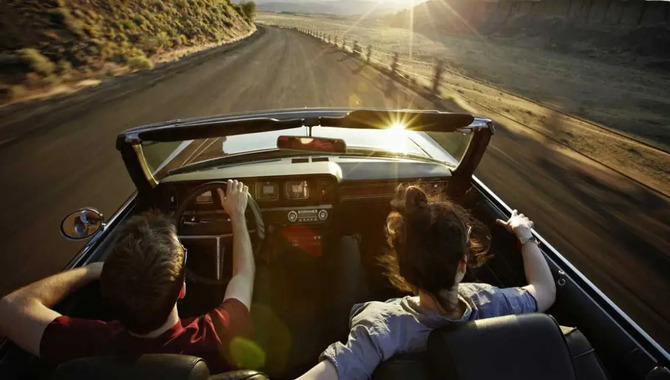
Planning a solo road trip can be daunting, but with a bit of preparation, it can be a lot of fun. Here are a few tips to make the journey safe and fun: First, make sure to have a plan. Map out your route, account for any stops you might make, and be aware of the emergency roadside assistance numbers in the area. Next, always keep your cellphone off while on the road.
Not only will this prevent distractions, but it can also help in an emergency. Third, adhere to the speed limit and be alert while driving. Fourth, use public transportation or car rental services when traveling long distances solo. Finally, be a good driver and take the time to enjoy the journey!
Planning Your Route Before You Go

Ready to road trip the USA solo? It’s not as daunting as you think.
– Follow these tips correctly, and you will be on your way in no time! First and foremost, download or carry a map of the area. So that you don’t get lost in that area. Take breaks along the way if necessary, but make sure to move along as quickly as possible
– Traffic can get a little hectic on the open road. Factor in the time of year, the highways that will be open, and the towns you’ll want to visit. Once you’ve decided on a solo travel destination, start planning your route. Decide on the best way to get there and start mapping it out. Take note of the scenic roads and stop at scenic areas while on your trip – they’ll make the journey much more enjoyable!
Tips For Avoiding Boredom On A Solo Trip
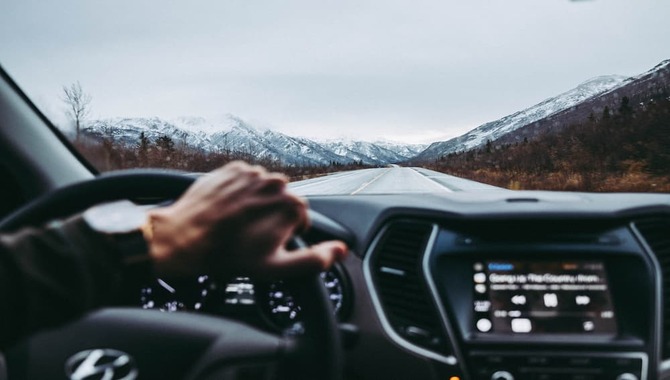
Solo travel can be an effective way to explore a country or city. However, it can be a bit of a bore if you don’t have anything to do.
To avoid the monotony of traveling solo, follow these tips:
- Venture out and explore different areas of your town. This will keep things interesting.
- Travel to local tourist attractions, which will give you a great experience .
- Bring a laptop or tablet to watch your favorite shows or movies offline.
- Make sure to pack some books and magazines to read. By doing these things, you will be able to fully enjoy your trip!
Stay Safe While Driving
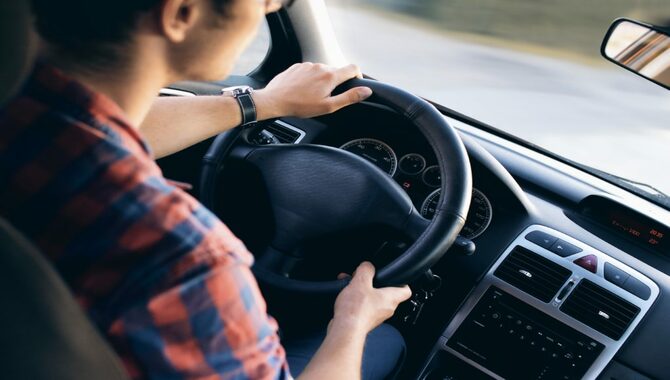
Road trips can be the best time of the year – the weather’s perfect, you can explore new places, and you don’t have to worry about school or work. However, traveling solo can be a little daunting, especially regarding road safety. Pack the right things and be careful to make the trip an enjoyable and safe experience.
Some essential tips to keep in mind when traveling solo include packing enough food and water, using a hands-free device, and avoiding eating or drinking while driving. Most importantly, always be aware of your surroundings and obey all traffic laws. Finally, get a good night’s sleep on the road – it will help you stay alert and avoid fatigue-related accidents.
Driving Tips For A Solo Road Trip

When it comes to a solo road trip, a few tips can help make the experience a lot more comfortable and rewarding. The first thing to do is start planning the trip well. This way, you can make the most of your time and avoid any last-minute road trip chaos. Another good idea is to download an app like MapQuest or Google Maps that will help you navigate without getting lost.
Additionally, use the roadmap as a guideline while driving so you don’t get overwhelmed. Finally, make sure to pack enough clothes and snacks for the drive, as you won’t be able to stop at any stores along the way. With some preparation, a solo road trip can be a lot of fun and a fantastic opportunity to explore new places!
Staying Hydrated On A Long Trip

Road trip planning can be a little daunting, but it’s easier with a few tips. One of the most important things to remember is to stay hydrated. Make sure to drink plenty of water, juice drinks, and snacks that are high in fluids.
Additionally, avoid eating heavy meals before you go – they’ll only make you feel terrible while driving. And if the road trip gets too hot outside, close the windows and crank up the AC! Staying healthy and hydrated on a long trip is essential, so follow these tips, and you’ll be good to go!
Tips To Make better The Most Of Your Journey

Road trips are the perfect way to escape the daily grind and explore new places. However, making the trip solo can be a little daunting. No worries! This guide will help you make the most of your solo road trip by providing tips and advice on everything from planning the trip to the best ways to stay engaged on the road.
Be aware of the time zones you’ll be crossing, and pack snacks, drinks, and anything else you may need to keep yourself entertained during long drives. Make sure your car is fully stocked with water, food, maps, and other essentials, in case you get stuck on the road. And last but not least, enjoy the trip – road trips are a great way to get in touch with your inner adventurer!
Eating Healthy On A Long Trip
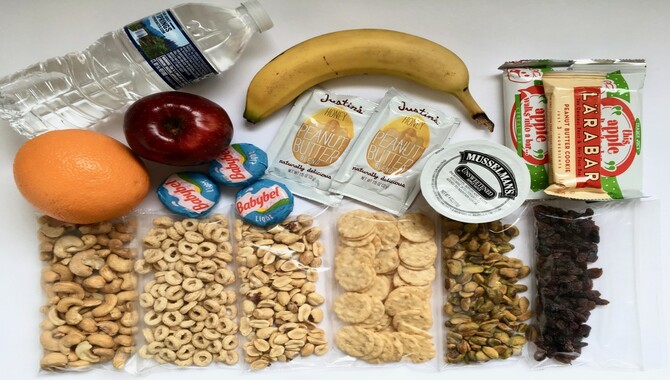
Road trips can be a lot of fun and interesting. To make the trip a breeze and stay healthy, follow these tips: – Stick to lean protein sources like eggs, grilled chicken, or fish instead of processed foods. These foods are high in protein and will help you feel fuller for longer.
– Eat balanced meals and snacks to stay healthy and energized on the road—pack snacks low in sugar and fat and plenty of fresh fruits and vegetables.
– Drink plenty of water while on your trip
– it will help you avoid dehydration, headaches, and other health problems!
– Make sure to pack plenty of fresh fruits and vegetables for snacks
– they’re a great way to keep your energy up and your stomach happy on the road.
Driving a solo road trip can be a fun and exciting experience, but taking the necessary precautions to stay safe and healthy is important. By following the tips in this guide, you can make the trip a breeze and enjoy the scenery simultaneously! Make sure to also stock up on snacks and drinks, and take the time to relax and enjoy the ride! Have fun.
Frequently Asked Questions
How do i drive in solo travel.
The best way to drive solo travel is to rent a car. Cars can be rented from various sources, including the internet and local car rental companies.
How Safe Is Driving In Solo Travel?
Studies have shown that the overall incidence of homicide in the United States is about 1 per 100,000 people. This means that the chance of being killed while traveling solo is about the same as that of being killed in a car accident. However, the risks are different depending on the country you are traveling to.
For example, in some countries, the chance of being murdered is much higher than the chance of dying in a car accident. Therefore, it is important to read the travel warnings issued by the US State Department or the embassy of the country you visit.
What Is The Best Way To Drive In Solo Travel?
Driving tips for solo travelers can be found on the Lonely Planet website.
Michael C. Herrera
I’m a travel blogger with a focus on safety. I’ve been to all seven continents, and I love sharing my tips for staying safe while traveling. I also have a lot of experience with travel hacking and finding the best deals on airfare and hotels. My blog features reviews of restaurants, hotels, and attractions around the world.
Leave a Reply Cancel reply
Your email address will not be published. Required fields are marked *
Save my name and email in this browser for the next time I comment.
Recent Posts
Flixbus Luggage - What You Need To Know
When travelling by bus, you must consider the amount and type of luggage you'll bring. That's where FlixBus luggage comes in. FlixBus is a popular bus company that operates in Europe and the United...
Lucas Luggage Replacement Wheels: A Simple Guide
Lucas luggage replacement wheels are an essential component for any frequent traveler. These wheels are designed to replace worn-out or damaged ones on your existing Lucas luggage. Providing an...

20 tips for planning the ultimate road trip
Posted: August 4, 2023 | Last updated: August 4, 2023

20 tips for the ultimate road trip
Virtually no other mode of vacationing affords the freedom of exploration inherent in road-tripping.
Whether traveling internationally or vacationing stateside, exploring the countryside by motor vehicle is a perfect way to get to the heart of a region—and a fantastic method for satiating wanderlust. Unlike pre-booked vacations, which too often involve hectic airports, hurried tour guides, and detailed, unchangeable itineraries, road trips allow travelers to go at their own pace, soak in the scenery, and take in the full scope of the landscape.
A full 43% of Americans had road trips planned this summer , according to consumer research released in May 2023 by TransUnion. Many people prefer road trips because they're more flexible and, often, far more affordable than other modes of transport. Some of the most popular weekends for road trips fall on summer holidays: The American Automobile Association predicted a record-setting 43.2 million Americans would road-trip over Fourth of July weekend this year.
While it's easy to enjoy an adventure on the road, there are plenty of hacks to make the overall experience more pleasurable. To that end, S tacker curated a list of 20 road-trip tips to help make every overland adventure more enjoyable. Some are practical suggestions, while others are more creative ideas meant to enhance the fun. Keep reading for 20 ways to improve your next adventure.
You may also like: Main Street America: Route 66 attractions by state
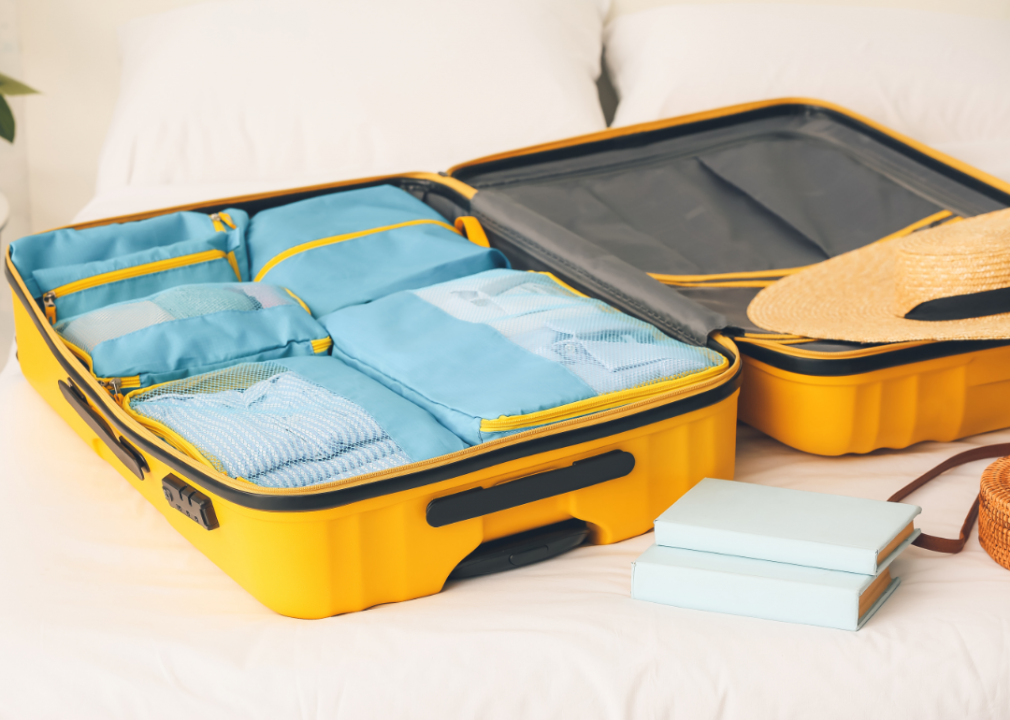
Compartmentalize your luggage
Having to dig through one giant bag of clothes, toiletries, and electronics is enough to drive any road-tripper bananas—especially if said digging is a recurring theme spread out over several days or weeks.
Packing can be easily compartmentalized with smaller bags or packing cubes organized by activity or occasion. Planning for several beach days? Prep a bag or packing cube with beach-only items. Stopping at various hotels along the way? Pack another cube with overnight essentials to prevent hauling a car's worth of luggage into every accommodation.

Get a tune-up
Nothing ruins a road trip faster than your car breaking down on the side of the highway halfway through. The simplest way to prevent this is also the most obvious: Take your vehicle in for a basic tune-up prior to the trip. This small investment of time and money can save a huge headache down the road—literally.
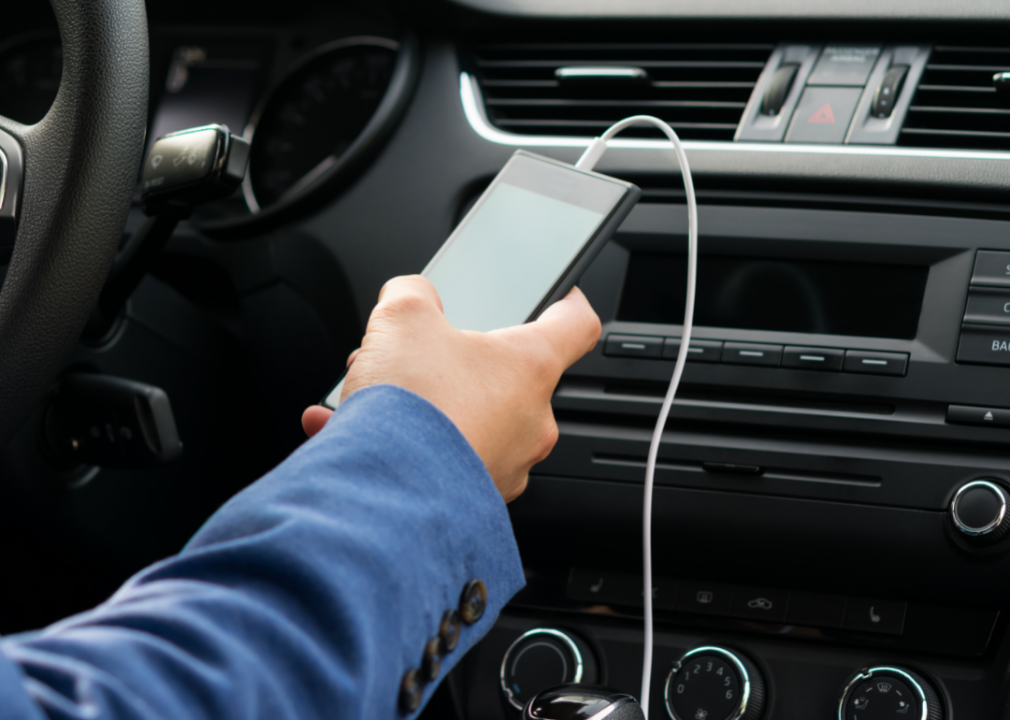
Download your media
Streaming Netflix at a campsite or listening to Spotify for six hours while driving will wreak havoc on your phone plan's data. Even with unlimited data, you're not guaranteed great service—particularly if you're headed into more rural outposts.
Before you head out on the first leg of your journey, download select playlists, podcasts, movies, or other media you plan to consume during that section of the drive. Delete what you've listened to or watched as you go to free up space to download more.

Bring water—lots of it
Keeping water on hand does more than keep passengers hydrated to fight headaches and fatigue.
Water can be used to wipe spills inside your car, poured over your radiator if your engine overheats (lukewarm water only!), and used to wash up after camping. Don't make the assumption there will be potable water everywhere you go. Carry large quantities with you in the vehicle and refill every chance you get in case of an emergency.
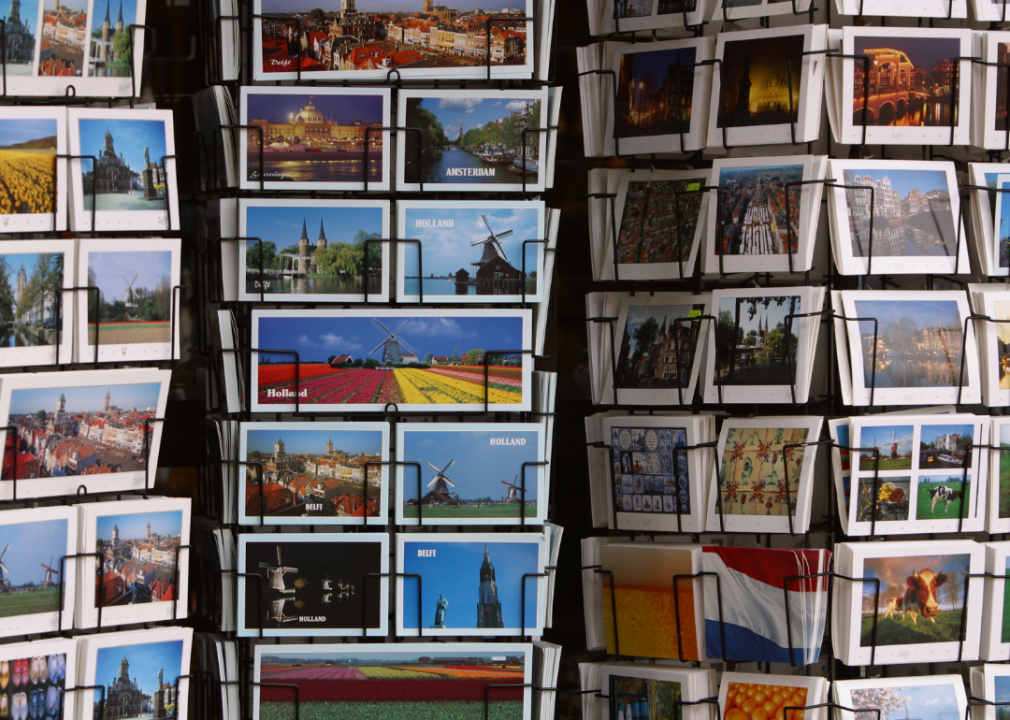
Collect something
If you're planning a road trip with multiple stops, collecting a simple souvenir at each destination is a great way to remember the trip. It could be a postcard, coffee mug, key chain, or something more personal. Many travelers also get creative with photography by taking a photo of a tree in every location, for example, or a road sign, and making a collage of the images at the end. Just remember to be respectful and not take things like plants or other parts of the natural environment.
You may also like: Must-drive roads in every state
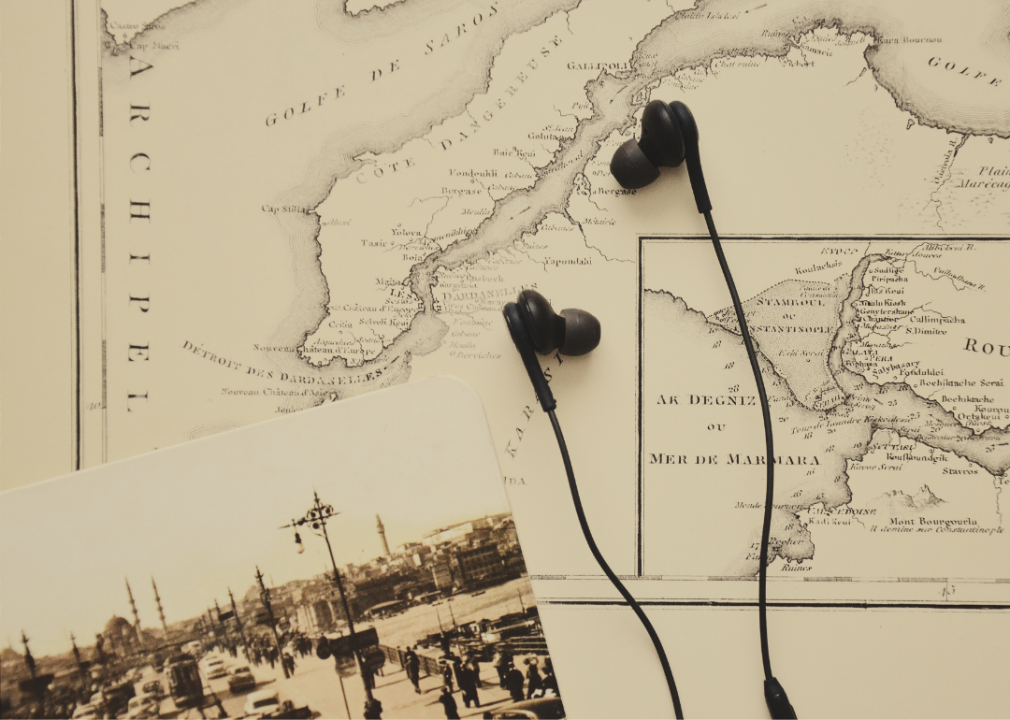
Bring earplugs or headphones
While many of us imagine a classic road trip as an endless highway with the windows down and the music up, there are times weary travelers want silence, too—particularly around bedtime. When you're trying to sleep at noisy campgrounds, crowded trailheads, or in motels with thin walls, having a way to control what you do and don't hear will be a blessing.
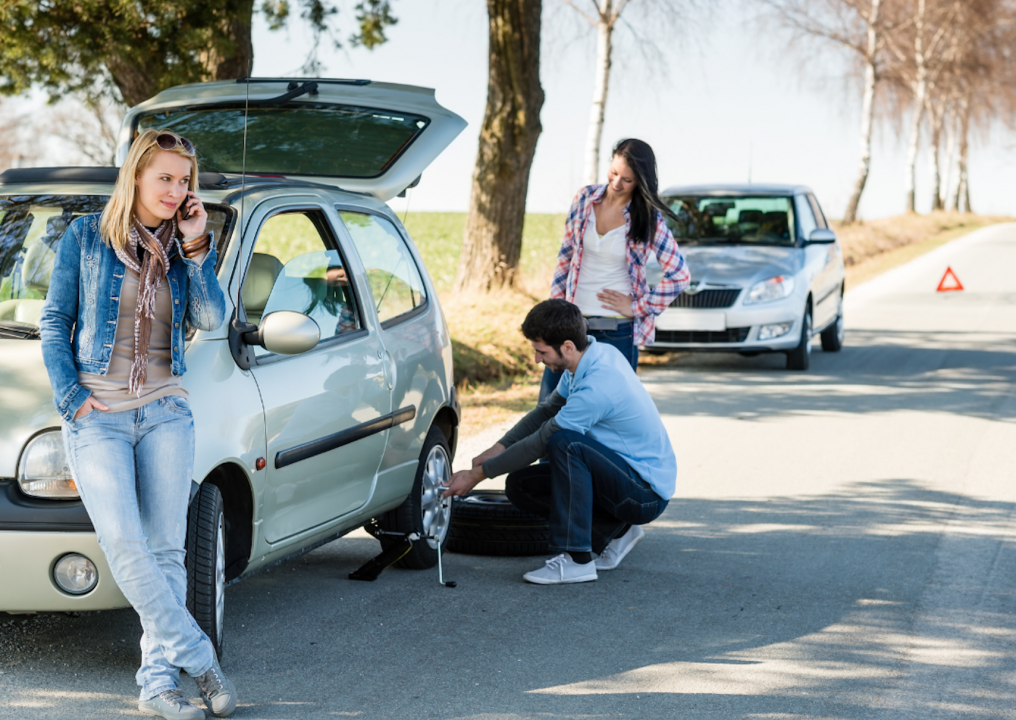
Don't forget emergency provisions
Even the most perfectly planned road trip has its fair share of bumps. Make sure you're prepared for the worst by carrying all basic emergency provisions, including a spare tire and jack, jumper cables, engine oil and fluids, tire chains (if driving through snow), water, snacks, a warm blanket, a fire-starting tool, a flashlight, and a first-aid kit.
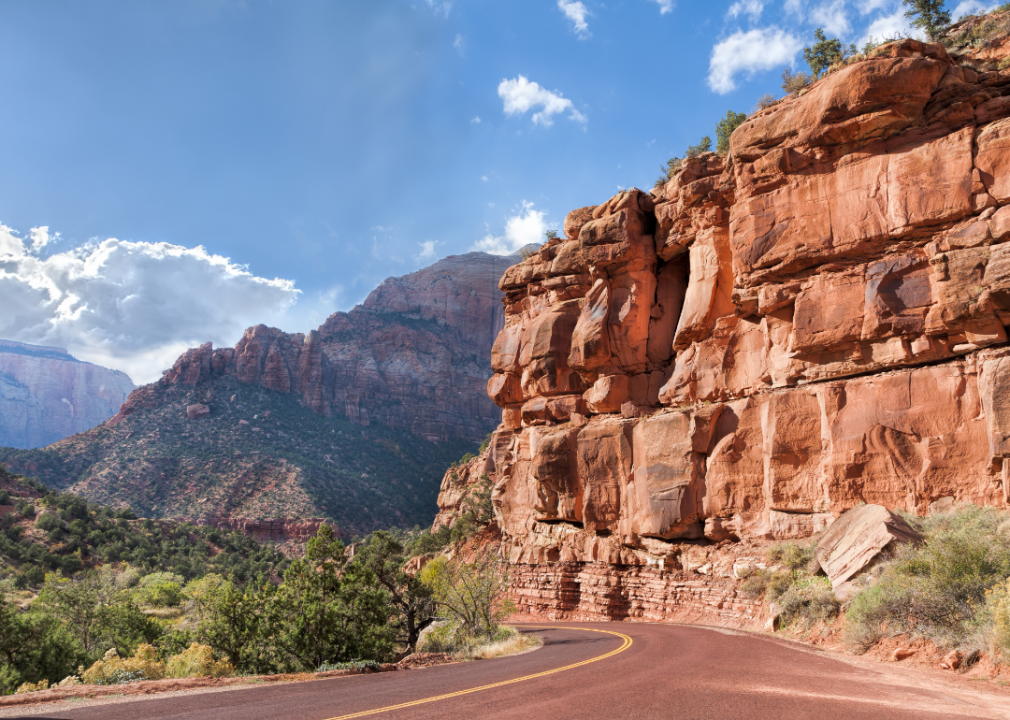
Take the scenic route
It's tempting to pick the quickest path between points A and B. After all, seeing the outside of the vehicle is the whole point of the trip. However, if there's an alternate route that doesn't take much more time but offers a significant increase in scenery, it's often worth it to take the slightly slower path. You will spend a lot of time in your car regardless: Appreciating the journey is key.
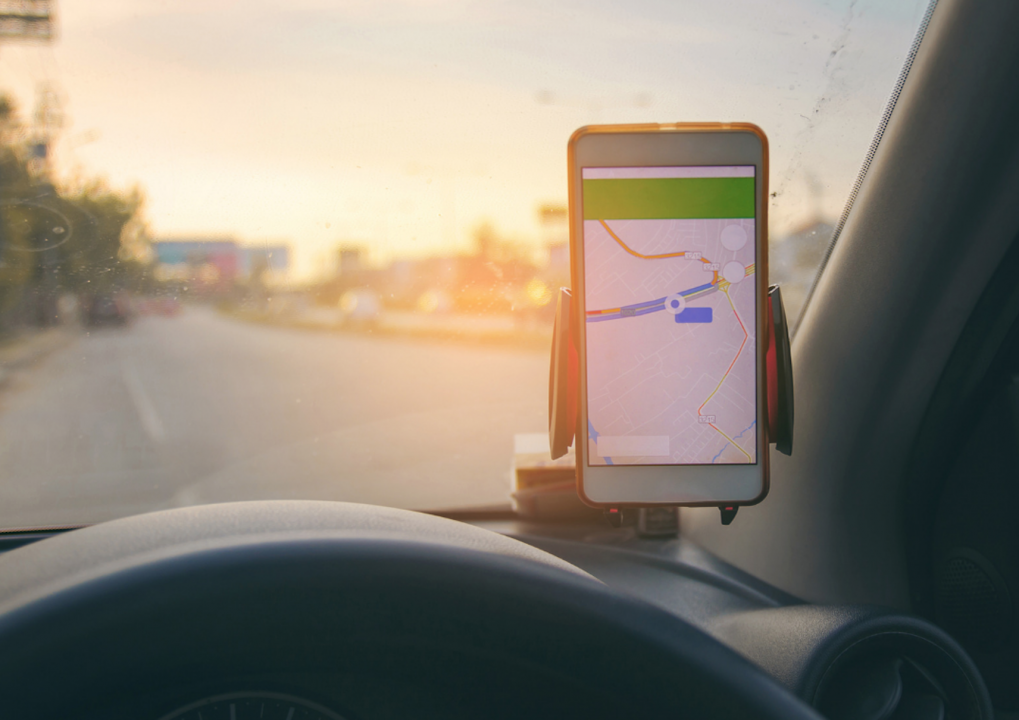
Get Google Maps offline
Getting lost can be part of the fun of exploration; other times, it can be a giant source of stress and tension.
If you anticipate being without Wi-Fi, or traveling through areas with spotty cell service, download the Google Maps of the area you're driving in to your phone before you go. Better yet, pick up a physical road atlas at a gas station—tracing your route will make for a perfect piece of frameable art later on.
Don't wait until you're lost, because you'll need the internet by then and it will be too late. To download the map of the area you're headed, simply enter the city or region you're visiting on your mobile device, click the menu, then "Offline Maps," then "Custom Map." You can then drag the square to the specific area you want to access offline and save. This is helpful not only when driving but when walking around a new town or hiking in more remote locations.
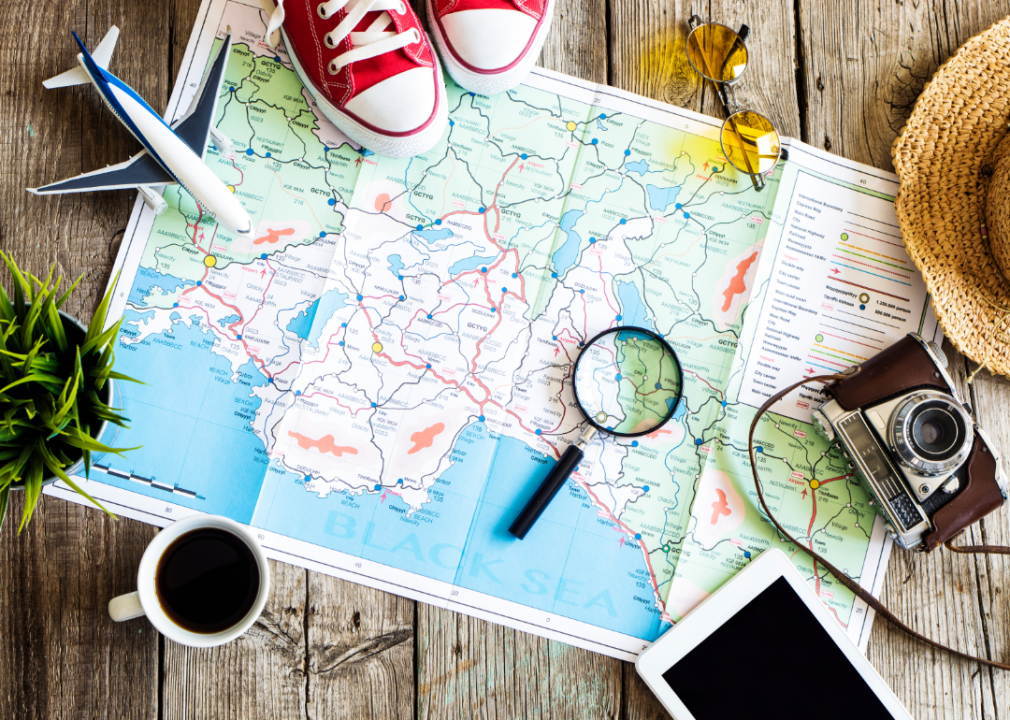
Have a rough plan...
Although the flexibility of a road trip is a massive part of its charm, structureless days can be overwhelming and actually take away from the experience. Without due diligence, you may show up at a national park to find that particular entrance is closed due to high traffic—or you might spend half the morning each day figuring out where everything is and what there is to do.
It's fine to keep much of your trip spontaneous, but it helps to spend a few hours before you go to carve out a basic framework of what options are available to you.
You may also like: Offbeat adventures: Travel to the coolest hidden wonders in every state
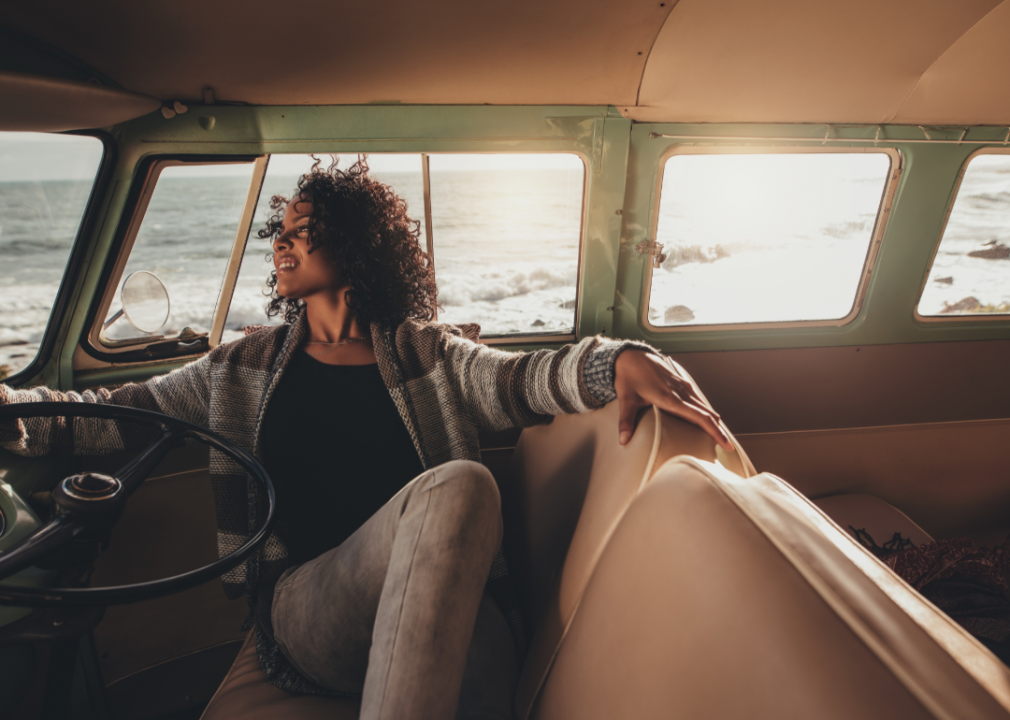
...But don't plan too much!
The flip side of too much spontaneity is too much planning or a trip that leaves nothing to chance. Also, it can be exhausting if you spend every minute of your day racing around with an item to check off of your to-do list. Even if you're planning to create a full itinerary, be sure to schedule downtime to rest, relax, and recuperate.
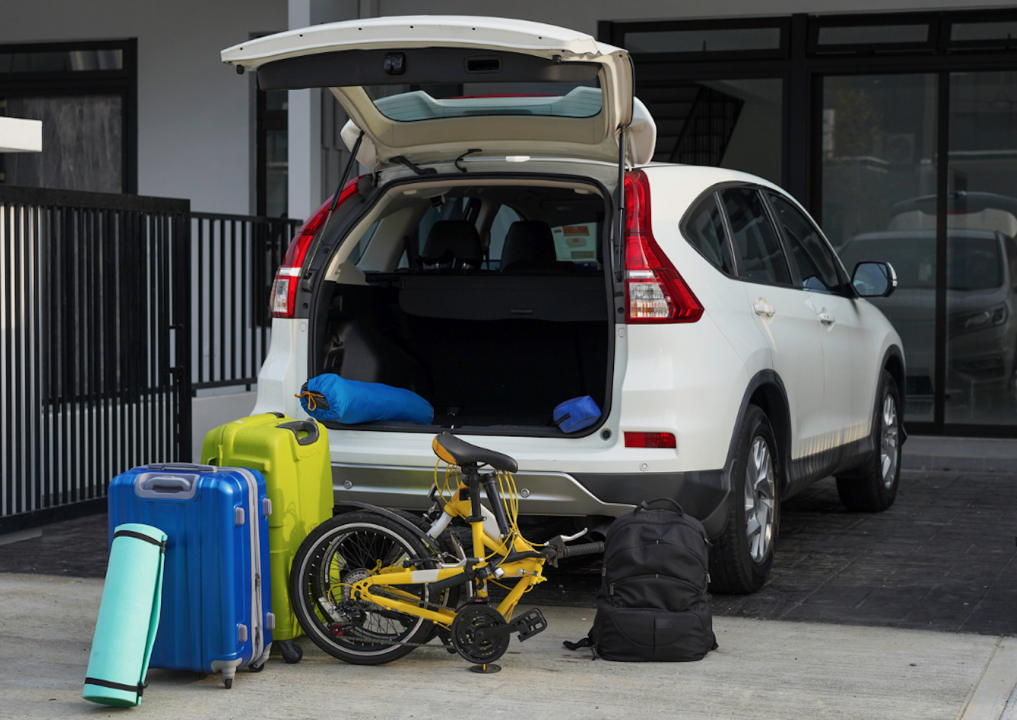
Organize the car
It's hard to enjoy yourself on the road if you're constantly looking for misplaced items, trying to carve out a space to sit, or retrieving things you've dropped into that annoying crack in between the seat and the console. This is where organizational tools and gadgets can come in extremely handy. The internet is full of car ceiling cargo nets, dashboard organizers, back-seat pouches, console shields, sticky pads, mini shelves, and other auto accessories. Load up before you go.
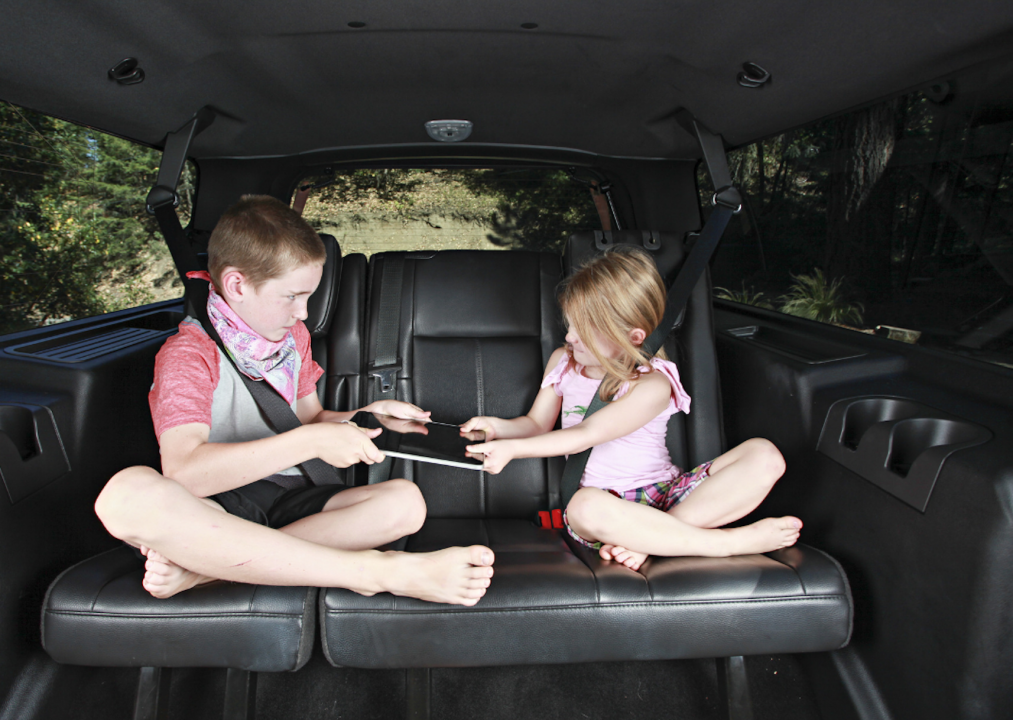
Whether you're counting license plates, listing off countries by letter, or trying to spot certain types of vehicles, playing games that don't involve screens is a great way to pass the time. If you're traveling with friends or family, create a scavenger hunt before you go, or come up with an ongoing competition that features prizes at the end: Whoever spots the most items with American flag prints or cars that start with the letter T wins ice cream or a free back rub.
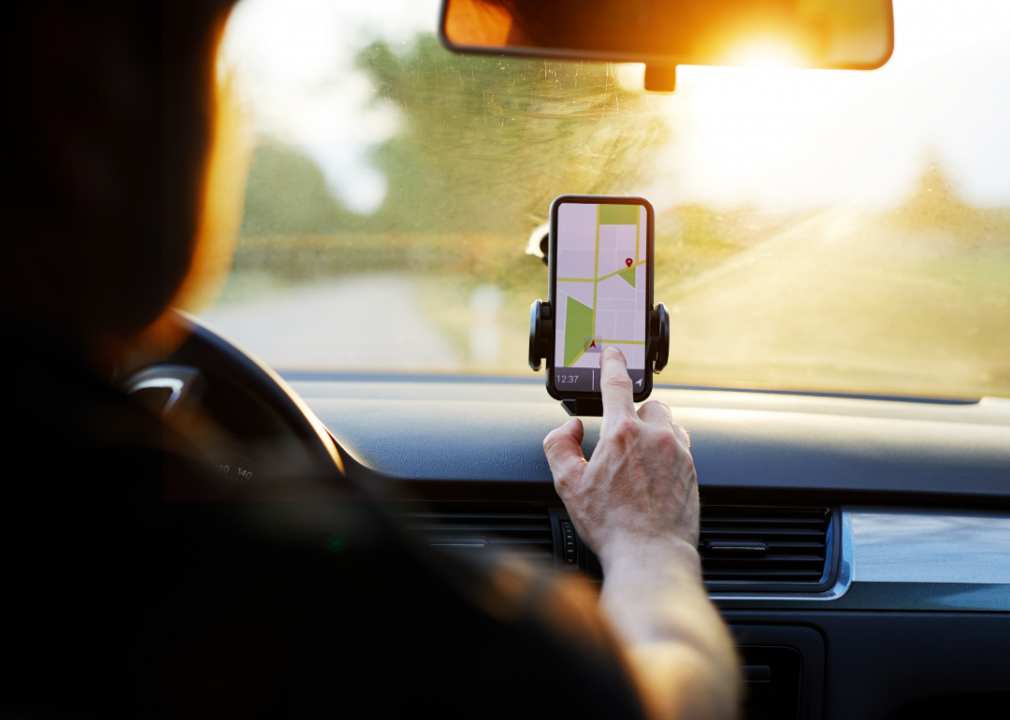
Take advantage of apps
There's an app for everything, and road trips are no exception. Countless parts of your journey can be made simpler with little buttons on your phone. There's "Roadtripper" to help you find routes, "Roadside America" to highlight hundreds of roadside attractions along your way, "GasBuddy" for cheap gas, "Waze" to help dodge traffic jams, and many, many more.
Peruse your options before you go to take full advantage of the modern technology available.
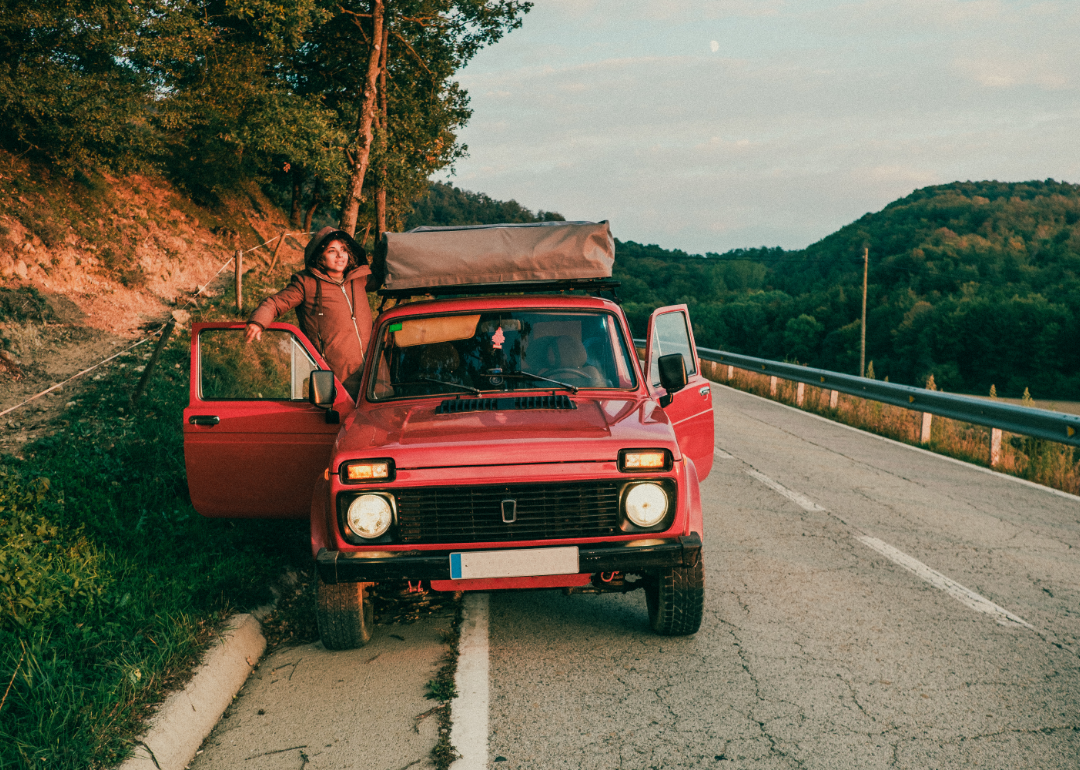
Get a roof rack for storage
If your vehicle doesn't already have a roof rack, planning a major road trip is a great excuse to invest in one. With that, you can put bulky items and other belongings in a cargo box on top of your rig, freeing up an enormous amount of space inside to stretch your legs or pack more items. Don't forget to invest in several sets of strong, reliable straps or bungee cords.
You may also like: Longest highways in America
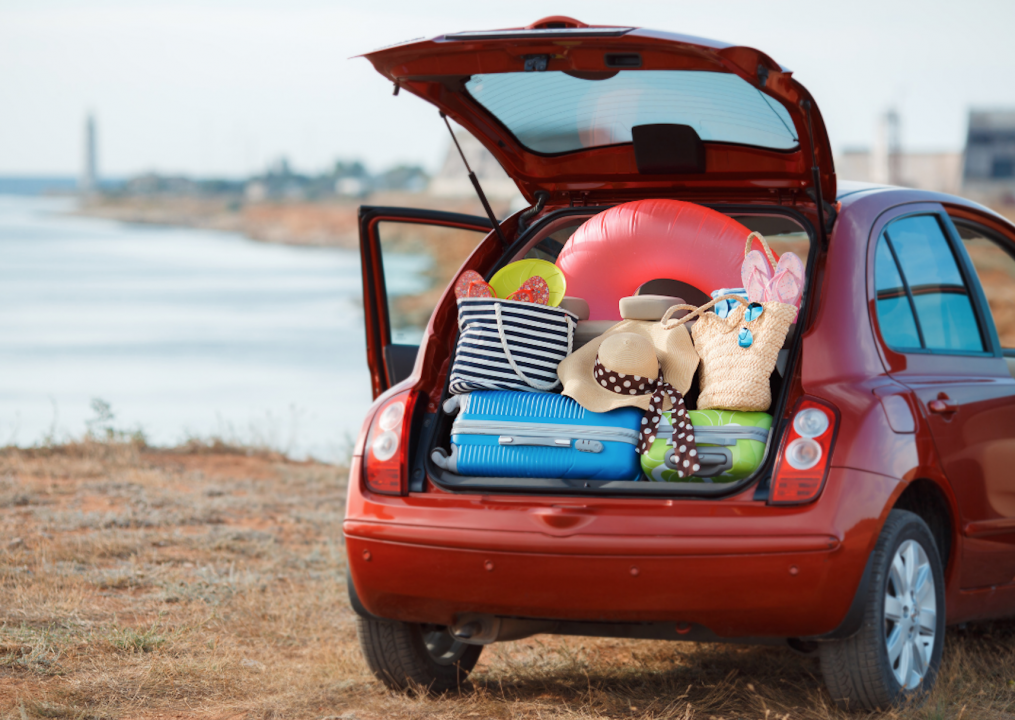
Be mindful when packing the car
Don't just drag everything to the curb and start packing up your vehicle Tetris-style, according to how well certain objects fit together. Instead, be strategic by thinking about what you'll need and when. If you know, for example, that you won't be in the water for the first few days, keep the beach bag and pool toys buried for now. Likewise, if you know you'll want your laptop as soon as you get to your hotel on the first night, pack that on the outside for easy access.
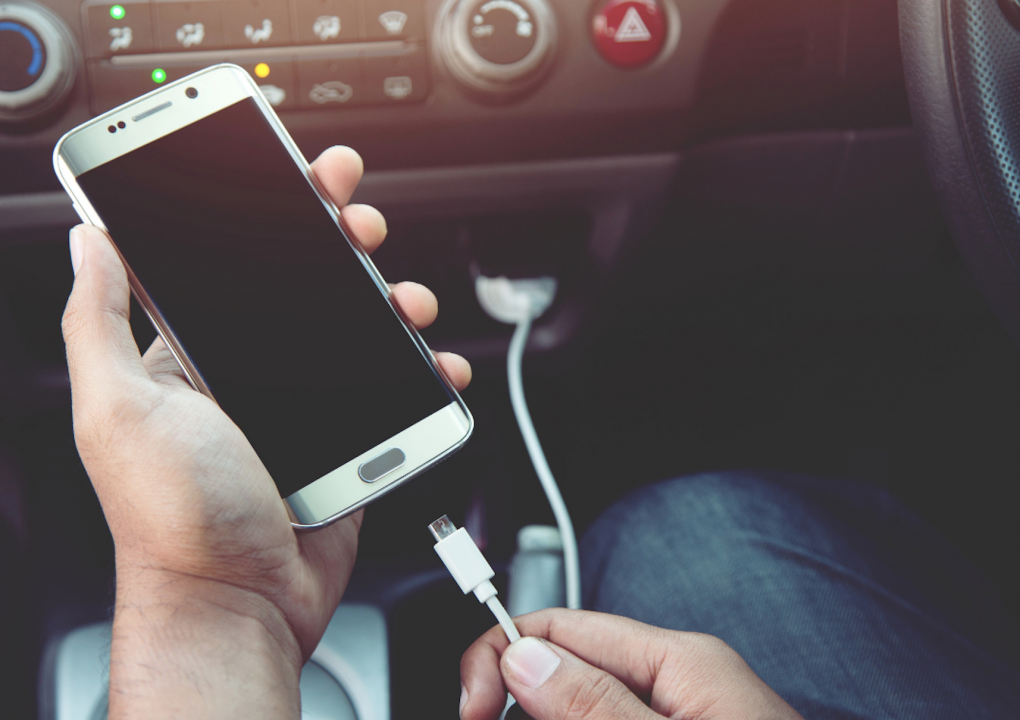
Have a charging system
Between your phone, laptop, Kindle, and other devices, it's likely that you'll have lots of things you want to keep charged on the road—and if this isn't a solo journey, you can double or triple that number. A built-in USB charger in your car won't be enough, even if it has several ports.
Invest in a car-charging adapter that offers a standard outlet (or several), along with USB ports and other charging mechanisms. If you have a lot of devices, you may even consider a larger external solar battery or one you can recharge with the car's engine.
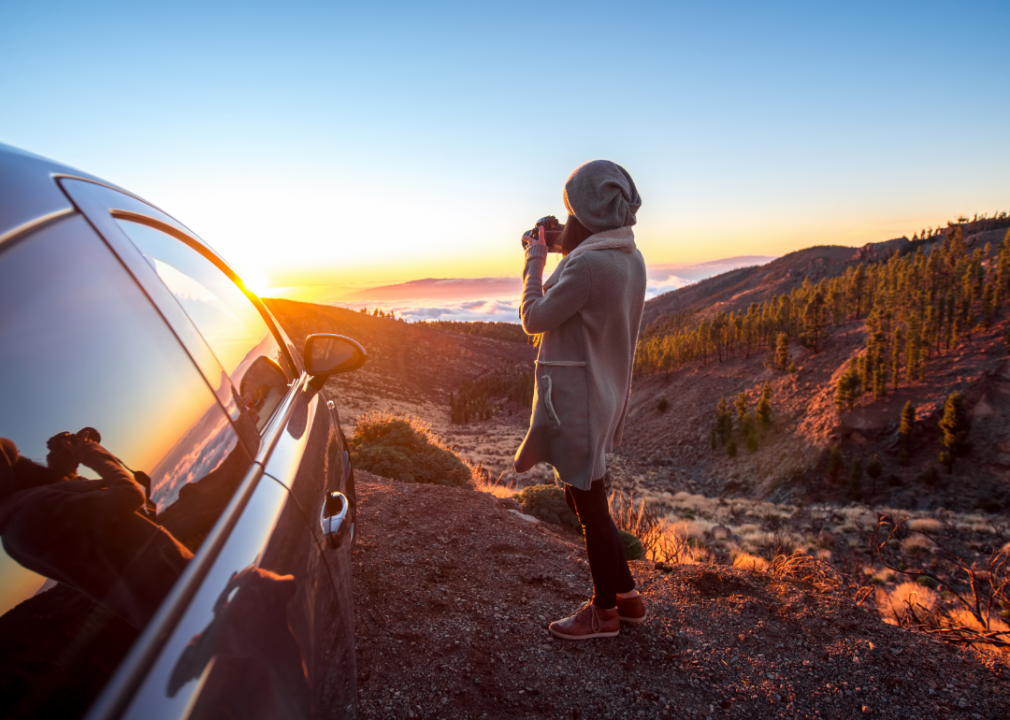
Get a camera that's not your phone
It's a cliché—but a true one—that most people today are attached to their phones in unhealthy ways. If you want to be more present on your trip and enjoy periods of digital detox, bring a camera with you that doesn't have any smart capacities. That way, if you want to go out and explore the town one afternoon without your phone, you can do so without fearing you'll miss a photo op.

Be adaptable
When you're on the road, the phrase "if it can go wrong, it will" often becomes extra relevant. Although you'll no doubt have tons of fun on your trip, there will also be things that don't go your way. Even the most prepared traveler gets lost, major attractions have unexpected closures, and highway construction cause setbacks—the list goes on.
It's important to mentally and emotionally prepare for unexpected surprises and to do your best to roll with the punches so they don't ruin your trip.
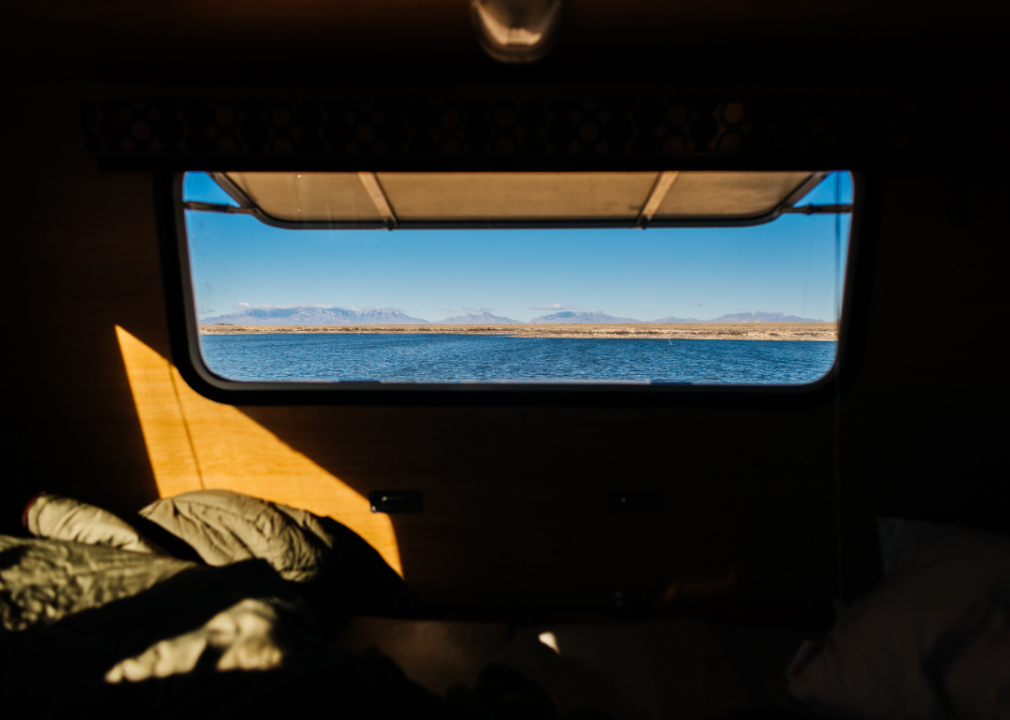
Bring window shades
Even if you're planning to do 100% of your sleeping in hotels or other non-vehicular accommodations, there will be times when you'll want climate control—or shade—inside your car. On top of keeping it cooler when you're on excursions, window shades will make the atmosphere more pleasant if you want to read a book or take a catnap as a passenger.
You may also like: The history behind all 63 national parks
More for You
Husband Of Kansas City Chiefs Cheer Alum Speaks Out On Wife's Death After Stillbirth
Tiger Woods left-handed shot at The Masters breaks the rules of golf
This Is How Long You Can Leave Butter On the Counter, According to Land O'Lakes
30 trans celebrities who broke barriers
Disney Cites First Amendment In Gina Carano Termination Suit
Krispy Kreme Is Only Requiring Customers to Pay Sales Tax on a Dozen Donuts as a ‘Sweet Tax Break’ on Tax Day
These Are 10 Smells That Cats Absolutely Hate
Health Care to Change for Thousands of People Under New Bill
Worried about microplastics in your water? You can get rid of them with common kitchen items
"None of them dudes wanted no smoke with Derrick Rose" - Rip Hamilton says superstars were scared of a prime Derrick Rose
Keanu Reeves' Ballerina Cameo as John Wick Revealed at CinemaCon Screening
KFC Is Changing Its Menu—Here’s What to Expect
35 Things About "American Schools" That Are Completely Normal To Americans And Incredibly Weird To Non-Americans
Giant battery to be installed underground as deep as Empire State Building is tall: 'It's a massive amount of storage'
Nursing school enrollments are decreasing—here's what that means for the future of nursing
"That is like saying can Prince play the guitar" - Kenny Smith defends Michael Jordan from recent criticism
New 'Beetlejuice Beetlejuice' Footage Introduces Jenna Ortega's New Character
13 Menu Items McDonald's Employees Refuse To Order
12 Concealed Kitchen Storage Hacks You’ll Want to Use Immediately
I Blind-Tasted 9 Ketchup Brands—and the Winner Will Surprise You
- Skip to main content
- Keyboard shortcuts for audio player

Solar eclipse 2024: Follow the path of totality
Solar eclipse, what you need to know to watch monday's total solar eclipse.
The NPR Network
A stunning celestial event is visible across the country Monday, when the moon crosses directly in front of the sun: a total solar eclipse. For those in the path of totality, there will be a few brief moments when the moon completely covers the sun and the world becomes dark.
Traveling for totality? Skip ahead.
This will be the last chance to catch a total solar eclipse in the continental U.S. for about 20 years, so here's what you need to know to safely enjoy!
When is the eclipse?
April 8, 2024 there will be a total solar eclipse that crosses from the Pacific coast of Mexico through the United States.
What is totality and why it matters
According to NASA , totality will start around 11:07 a.m. PDT/1:07 EDT in Mexico and leave Maine at around 1:30 pm PDT/3:30 pm EDT.

Here's what time the eclipse will be visible in your region
Check out this table for when the partial eclipse and totality are visible in each region or check by zip code here.
A partial solar eclipse will be visible across the contiguous United States, so even if you're not directly in the path, you should be able to see something special, weather permitting.
Unable to get to totality? We'll be sharing highlights here from across the NPR Network throughout the day Monday if you can't see it in real time.
Where to see totality?
More than 30 million people live in the path of totality for Monday's eclipse, and many more in nearby areas.
Here's what we know about Monday's weather forecast.
Why totality matters
As NPR's Neil Greenfieldboyce explains , "During a total eclipse, the sky darkens suddenly and dramatically . The temperature drops. Stars come out. Beautiful colors appear around the horizon. And the once-familiar sun becomes a black void in the sky surrounded by the glowing corona — that's the ghostly white ring that is the sun's atmosphere."

Eclipse Science
For april's eclipse, going from 'meh' to 'omg' might mean just driving across town.
A partial eclipse, while still a fun experience, is hardly as dramatic. Those with a view of the partial eclipse will see crescent-shaped shadows like those seen here in 2017.
How to watch safely
If you plan to look directly at the eclipse (partial or totality), you're going to need eclipse glasses handy because looking directly at the sun without proper protection ( traditional sunglasses don't count! ) can be harmful to your eyes.

The perfect celestial soundtrack to the total solar eclipse
As NPR's Joe Hernandez explains, "Proper eye protection must be worn throughout a total solar eclipse — except for the roughly 3 1/2 to 4 minutes when the moon fully obscures the sun, a brief period known as 'totality.' (You will need to take your glasses off during totality to actually see it.)"
If you don't have access to eclipse glasses, you can get crafty with things you have around the house ( like some of us did back in 2017!) More on that here.
Traveling for totality?
The celestial event is driving a ton of domestic travel to the path of totality. If you're headed out of town to view the eclipse, here are some NPR Network resources for areas in the path of totality:
Texas The path of totality crosses through the Lone Star State, with some areas expecting a possible influx of visitors in the hundreds of thousands to catch prime viewing. Our member stations across the state have gathered local resources to help you navigate the region and the eclipse!
- San Antonio: Check out the latest from Texas Public Radio
- Dallas: Explore KERA's coverage for the latest
- Austin: Head to KUT for the best local resources
Arkansas The eclipse will be cutting through the state, putting Little Rock in the path of totality. Check out Little Rock Public Radio for local resources.
The southwestern edge of the state will be well-positioned to witness the total solar eclipse this year. Kentucky Public Radio is covering the eclipse throughout the region, from Kentuckiana eclipse mania to the University of Louisville's free class about the celestial event. Keep an eye on WKMS for the latest local updates.
Missouri The southeastern corner of the state will be in the path of totality, crossing across towns like Whitewater and Ste. Genevieve. Head to St. Louis Public Radio for local coverage and resources. Illinois Carbondale seems to have won the eclipse lottery, being in the path of totality both in 2017 and for this year's eclipse . For resources from across the state, check out Illinois Public Media .
Indiana A huge portion of the state will be within the path of totality, giving cities across Indiana, including Bloomington and Indianapolis, prime viewing of the eclipse.
- Bloomington: Check out Indiana Public Media
- Indianapolis: Head to WFYI for the latest
- Fort Wayne: Just north of the path of totality, WBOI has resources for the Allen County area
Ohio The Buckeye State is getting bisected by this year's path of totality, plunging a number of the state's most populous areas into darkness for a few minutes on Monday.
- Cleveland: Head to Ideastream Public Media for the latest.
- Columbus: With the capital city just south of totality, head to WOSU for regional resources.
- Cincinnati: Totality will just miss the border town. Here are some tips from WVXU on how to navigate the eclipse in the region.
Pennsylvania Only the northwestern-most corner of the state will catch totality, with views from the lakeside in Erie being particularly well-positioned for a stunning viewing experience. WESA has more from across the region.

Plan to watch the eclipse from a wild mountain summit? Be ready for harsh conditions
New York Buffalo, Rochester, Syracuse and Plattsburgh will fall under the path of totality on Monday. If you're planning to travel to the region for the best views, here are some local resources to stay safe and informed:
- Buffalo: Head to WBFO for the latest
- Syracuse: WAER has more on plans in the Salt City
- North Country: NCPR has the latest from across the region, as well as information on local viewing events to check out
Vermont The Green Mountain State will see totality across its most populous region, including Burlington and Montpelier, as well as the Northeast Kingdom on the Canadian border. Vermont Public has everything you need to know to navigate your time in the region to enjoy the eclipse safely. New Hampshire The northernmost region of the Granite State will be in the path of totality, providing prime viewing to those in Coos County. NHPR has info on local events, travel updates as well as special coverage with New Hampshire Public Television. Maine The last state in the path of totality in the U.S., much of Northern Maine will be positioned for prime viewing. The rural region is preparing for an influx of visitors, and safety officials are encouraging visitors and locals alike to be prepared. Maine Public will be covering the eclipse and has everything you need to know to navigate the region safely.
How to document the eclipse safely
With the ease of cell photography , it can be tempting to reach for your phone to document the eclipse and the moments of totality, but make sure to do so safely.
As NPR's Scott Neuman explains , "For starters, you'll need to wear eclipse glasses or similar protective eye gear while aiming your camera or even just observing the eclipse."
Feeling ambitious? Here are a few more tips.
Or if you're not inclined to capture the moment visually, you lean into some other forms of creative expression. Indiana, for example, has named Linda Neal Reising the official poet in the state for this year's eclipse.
As former NPR reporter and eclipse superfan David Baron shared with Life Kit , viewing totality "[is] like you've left the solar system and are looking back from some other world."
So consider focusing on being present in the moment to enjoy the celestial spectacle.
More resources to enjoy the eclipse
- Sharing the eclipse with tiny humans? Check out these kid-friendly total solar eclipse learning guides from Vermont Public's But Why, and this great explainer from KERA Kids on the difference between a solar and a lunar eclipse.
- Want to see how a solar eclipse alters colors? Wear red and green on Monday
- Plan to wander into the wild for the best view? Here are some tips from outdoor experts.
- Tips from Bill Nye on the best ways to enjoy the eclipse.
NPR will be sharing highlights here from across the NPR Network throughout the day Monday if you're unable to get out and see it in real time. NPR's Emily Alfin Johnson compiled these resources.
- 2024 eclipse

IMAGES
VIDEO
COMMENTS
To plan your trip, you need to know how long you can drive each day, what distance you can cover, how many breaks you need, and whether driving at night is an option. All these factors must be considered to get the road trip you want. 2. Set a theme for your solo road trip. You might want to choose a theme for your trip.
SOLO ROAD TRIP CAMPING. In my opinion, camping is an integral part of any road trip. Unsurprisingly, a solo road trip with camping involves a bit of extra planning. However, just as with a road trip alone, camping alone can be extremely rewarding. Firstly, you need to remember all your camping essentials. Second, follow these tips:
With this guide to planning your first solo road trip, you can travel smarter and safer, all while having a blast in your own company. 1-on-1 Van Life Coaching. Ready to get over your analysis paralysis and put your van life dreams into action? Let's make it happen together. Book a 1-on-1 van life coaching call now and take the first step ...
Get the oil changed, top off the fluids, check the brakes, and make sure the cooling system is in good shape. Have the manual handy in case a light comes on during your trip. Before you go, double check your car insurance plan and secure a membership to AAA for round-the-clock roadside assistance. 06 of 10.
Carjack: No one wants a flat tyre, but it's good to plan for one. Sometimes cell signals can be spotty on remote roads, making calling roadside assistance challenging. Having a carjack can make life easier, if you happen to get a flat. First aid kit: A first aid kit is always handy, no matter where you are.
Embrace freedom and flexibility by taking a solo road trip for personal growth and new experiences. Choose the right destination by considering your interests, researching the route and weather, and planning for safety and emergencies. Prepare for your trip by maintaining your vehicle, packing essentials, and budgeting.
Planning a Solo Road Trip. It's no secret that we love road trips around here. They're simply some of the best ways to explore a place. From the beginning to the end, you are the master planner. You decide for how long you will be travelling, where you will be staying, where you will be eating and so on. Plus, you can always be spontaneous.
Here are my top 10 tips for first time solo road trippers: 1. Plan an itinerary. It may seem obvious, but I cannot stress enough how having an itinerary, even if it is a loose one, is so important when planning a solo road trip. Planning where you want to go, what you want to see, and how long you want to spend exploring each place is crucial.
1.2: Decide what will move you forward. Once you've figured out what's holding you back and how to decrease or eliminate your fears, you can fuel that energy into excitement. This means that you get to start planning your trip and creating ideas of what you'd like to do, and what you want to get out of your trip.
Here are a few solo road trip essentials for a roadtrip alone: A Spare Tire. A Tire Pressure Gauge. Flares. An Extra Canister of Gas (if you are in a truly deserted spot) A Paper Map (or a downloaded one). Don't rely on cell signal alone. An Extra Set of Keys.
Each of these iconic places offers visitors a chance to immerse themselves in the splendor of America's wilderness at its most pristine. -Bret Love & Mary Gabbett from Blue Ridge Mountains Travel Guide. 5. Solo Road Trip Through New York's Finger Lakes Region. Rainbow Falls in Watkins Glen State Park.
Planning for a Solo Road Trip: My Expert Tips. Here are my tips to plan a long solo road trip (more than one day), but they can also apply to shorter road trips (less than a day). These are tried and true tips I still use today. If you are a female or novice road tripper, this post is ideally for you.
Prepare for exploring Idaho's Scenic Byways' natural beauty on your upcoming solo road trip. Essential Solo Road Trip Tips. Going on your first solo road trip, or simply a solo trip, is an adventure filled with freedom and self-discovery. Traveling solo teaches you to enjoy your own company. Safety is also essential for a solo traveler.
Step 4: Prepare Your Vehicle. Before you hit the road on your solo adventure, it's vital to prepare your vehicle for the journey ahead. Proper vehicle maintenance and preparation ensure a safe and stress-free road trip experience. Start by scheduling a thorough maintenance check-up for your vehicle.
Avoid overly sugary snacks and caffeine if these make you jittery or anxious. Water is always the best, but tea, decaf coffee, or juice are great too. Self-entertainment. There are many things to ...
Here are some helpful resources for planning a solo cross country road trip: Car Rental: Save up to 70% with DiscoverCars ️ Solo Road Trip Planning: Roadtrippers (get 15% off with code BTR5QTP) 盧 Helpful Apps: -Campendium and The Dyrt to look up campsites -AllTrails for finding hikes -Atlas Obscura for offbeat attractions
In March 2023, I took a solo cross-country road trip from Boston to San Diego and back. Planning my road trip was a multi-month endeavor that I enjoyed almost as much as the trip itself, so I wanted to put my planning process down on paper—and also share the lessons I learned from the actual drive—to help others plan their own adventures.
1. Prepare your car before the road trip. Preparing your car before the road trip should be the first thing you do when planning a solo road trip. The type of preparation will depend on the distance you intend to cover throughout the entire trip. For instance: If you will be covering a long distance, then it would be important that you do a ...
Planning a solo road trip can be daunting, but with a bit of preparation, it can be a lot of fun. Here are a few tips to make the journey safe and fun: First, make sure to have a plan. Map out your route, account for any stops you might make, and be aware of the emergency roadside assistance numbers in the area. Next, always keep your cellphone ...
The Ultimate Guide to Planning a Solo Road Trip: Tips and Tricks. Travel Guides The Ultimate Guide to Planning a Solo Road Trip: Tips and Tricks. by Naman Sharma; February 22, 2024; 0 Comments;
Stacker curated a list of 20 road-trip tips to help make every overland adventure more enjoyable. Suggestions include staying hydrated, avoiding over-scheduling, getting the car tuned up, and ...
With this in mind, Road Scholar, the world leader in educational travel for older adults for nearly 50 years, has launched a new series of trips designed exclusively for solo travelers over 50.
NHPR has info on local events, travel updates as well as special coverage with New Hampshire Public Television. Maine The last state in the path of totality in the U.S., much of Northern Maine ...